2017 Tesla Model 3: What's It Like to Live With?
Read about the most recent updates of the 2017 Tesla Model 3 in our long term road test on Edmunds
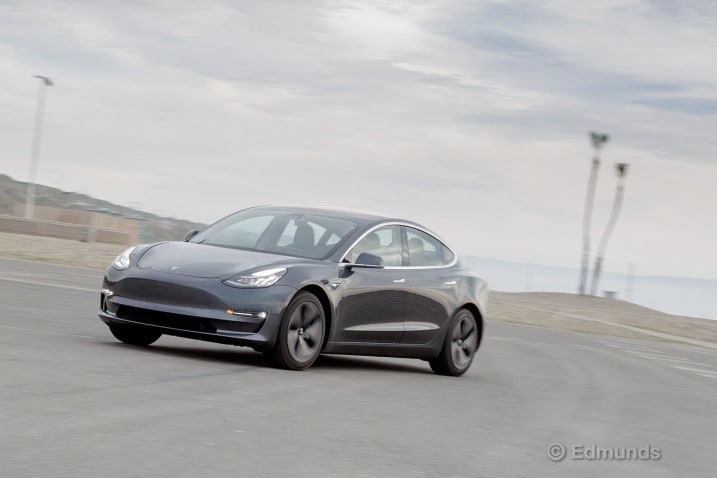
What do you want to know about?
- Pre-Introduction
- Ordering Process and Timeline
- Introduction
- Will an XL-Size Mountain Bike Fit?
- Monthly Update for January 2018
- Monthly Update for February 2018
- Monthly Update for March 2018
- Monthly Update for April 2018
- Stopping Distance and Grip With 18- and 19-inch Tires
- Monthly Update for May 2018
- Stopping Distance Retest After an ABS Firmware Update
- Monthly Update for June 2018
- Monthly Update for July 2018
- Monthly Update for August 2018
- Monthly Update for September 2018
- Monthly Update for October 2018
- Monthly Update for November 2018
- Monthly Update for December 2018 and January 2019
- Monthly Update for February and March 2019
- Monthly Update for April 2019
- Monthly Update for May 2019
- Monthly Update for June 2019
- Monthly Update for July 2019
- Monthly Update for August 2019
- Monthly Update for September 2019
- Wrap-Up
Pre-Introduction
The Buying Process Has Begun
We're doing something different. We have not yet taken delivery of what will be a 2017 Tesla Model 3 sedan, but the pre-ownership experience has just passed a critical milestone and we thought you'd want to follow along. As you can see, we have recently received an invitation to configure our Tesla Model 3 and begin the actual buying process.
It's hard to imagine a more anticipated car than the Tesla Model 3 sedan. This is the affordable $35,000 electric car that Tesla has been building up to since the carmaker has existed. And it's no overstatement to say this is the car that will ultimately make or break the company.
The Model 3 sedan shares nothing with the Model S and the Model X that came before it. It's much less expensive and it rides on a smaller platform, but it does share the same basic rear-drive layout concept that can be sold in all-wheel-drive form with the addition of a second electric motor.
On the technical side, the biggest Model 3 difference is the electric motor itself. In an unexpected departure from previous Tesla products, the Model 3 will use a permanent magnet motor instead of an induction motor, the very type that was pioneered by Nikola Tesla himself. What that means and how that manifests itself will be one of many things we delve into when we finally take ownership of our long-awaited long-term Tesla Model 3 sedan.
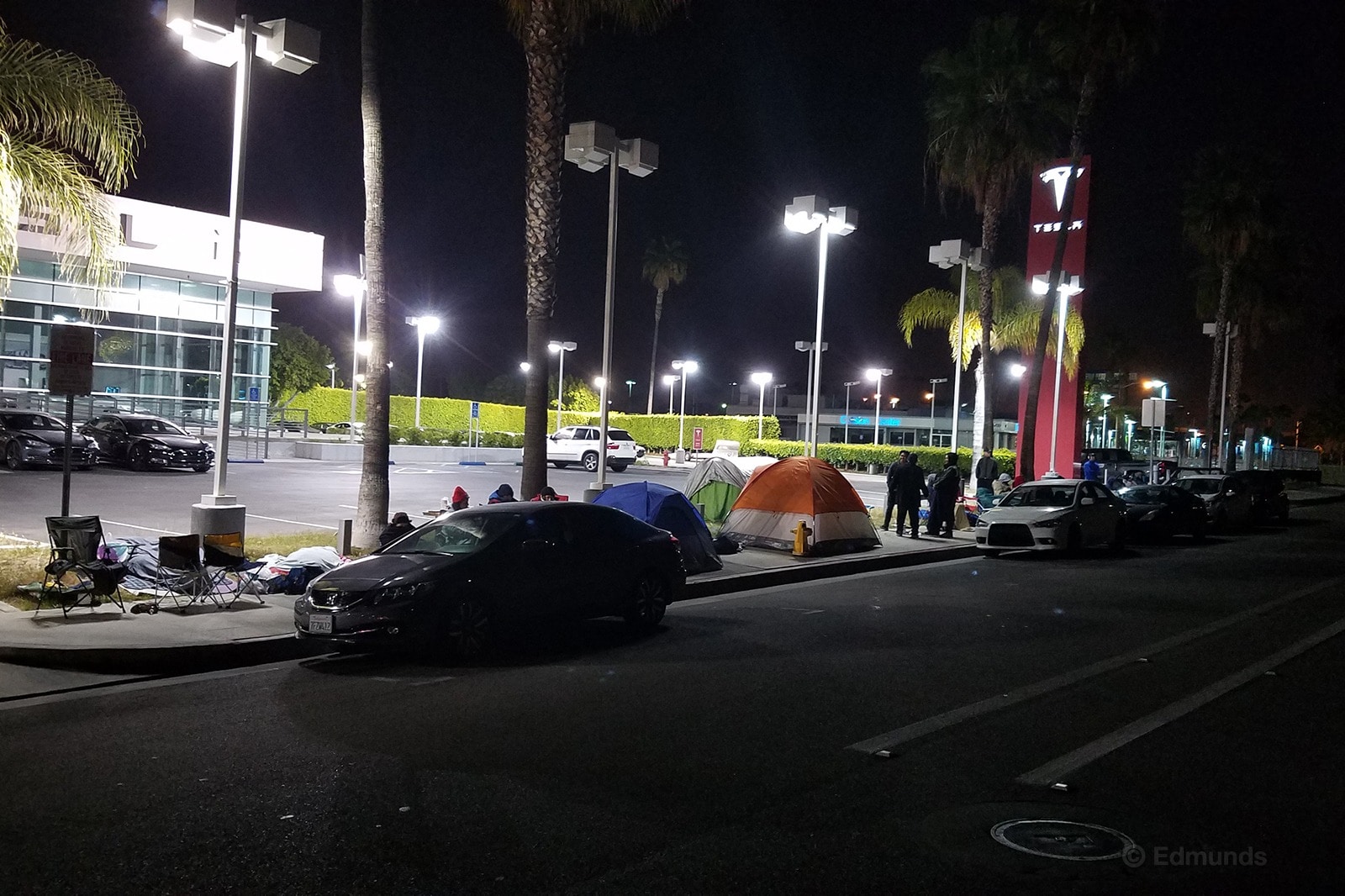
We barely knew any of this when the process of buying our Model 3 began before sunrise on March 31, 2016, the day the waiting list opened. I got in line at my local Tesla dealer at 4 a.m. that day to get an early crack at putting down a $1,000 deposit and hopefully secure a good place on the reservation list. The same thing was happening in more than a hundred other locations around the globe, too, so getting up early seemed especially necessary.
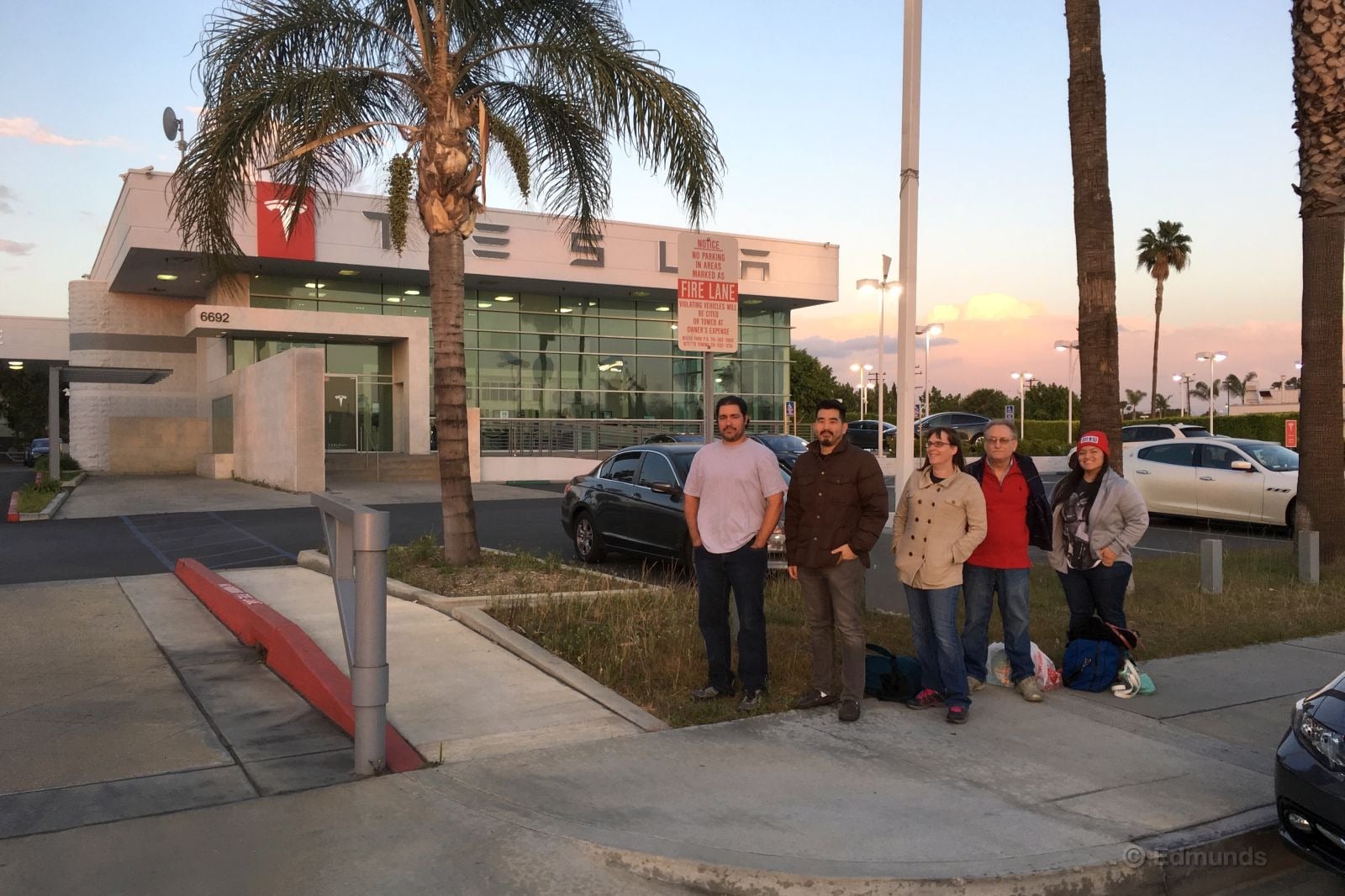
I even considered lining up with five die-hards I met the night before at 7 p.m., but thought better of it. My price for a partial night's sleep? Twenty-six places in my local line.
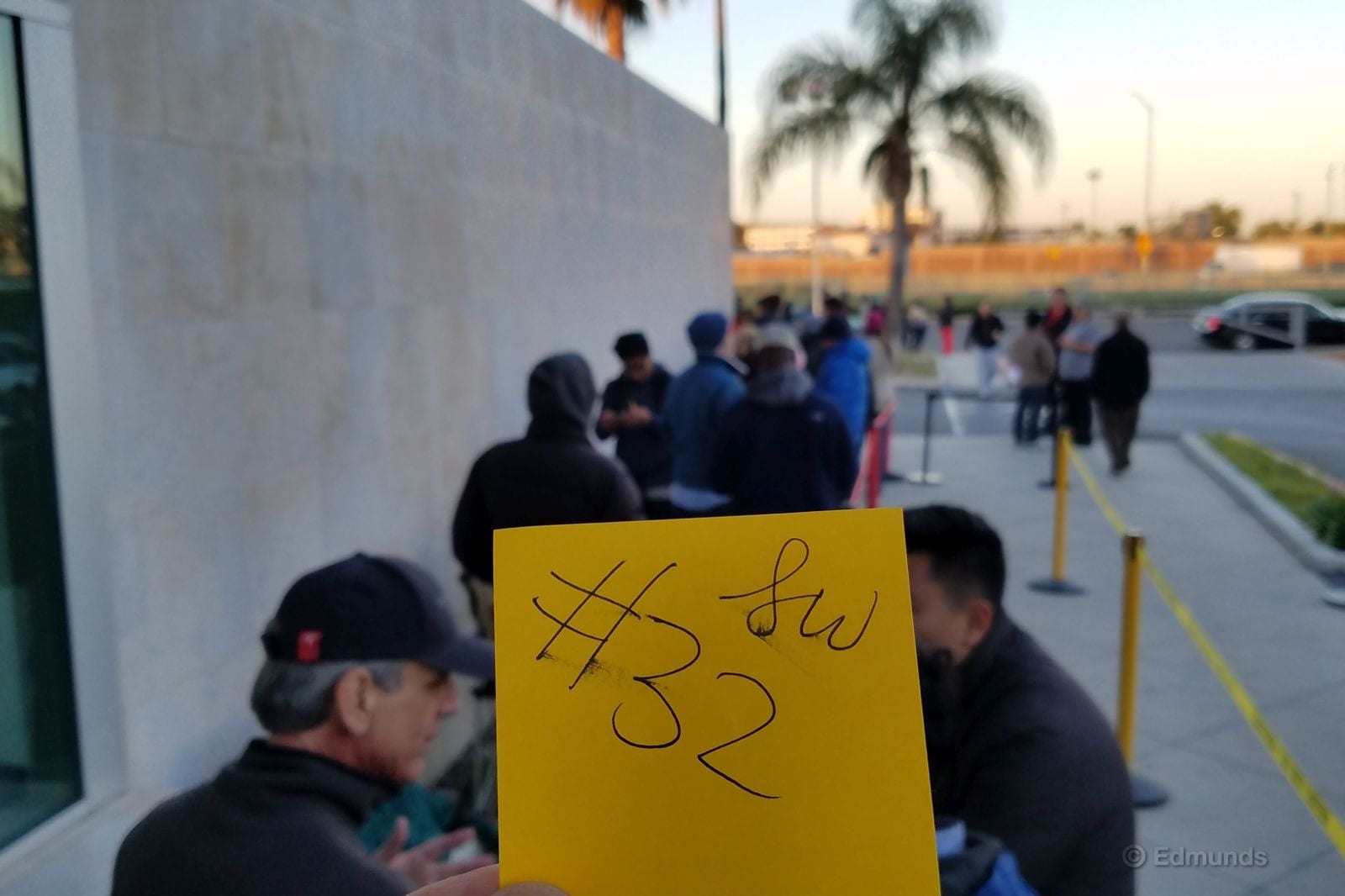
Instead of being No. 6, I was given No. 32 when they started handing out numbers and began moving the front part of the line off the sidewalk and up toward the building after the sun came up.
This was a calculated move. It had been announced that current Tesla owners were going to get some unspecified level of priority, so I figured we'd recover most of those places. After all, we'd already bought a 2013 Tesla Model S, driven it for 30,000 miles, written about it extensively, and sold it. Furthermore, as I stood there on that frosty March morning, another Edmunds staffer was preparing to head north to Fremont, California, to take delivery of our then-new 2016 Tesla Model X long-term test car the very same day.
Interestingly, we've since driven our 2016 Tesla Model X over 25,000 miles and put it up for sale on eBay. The decision to sell it was not brought about by the invitation to configure our Model 3, but it is notable that 20 months of eventful Model X ownership have come and gone since I first stood in line for this Model 3.
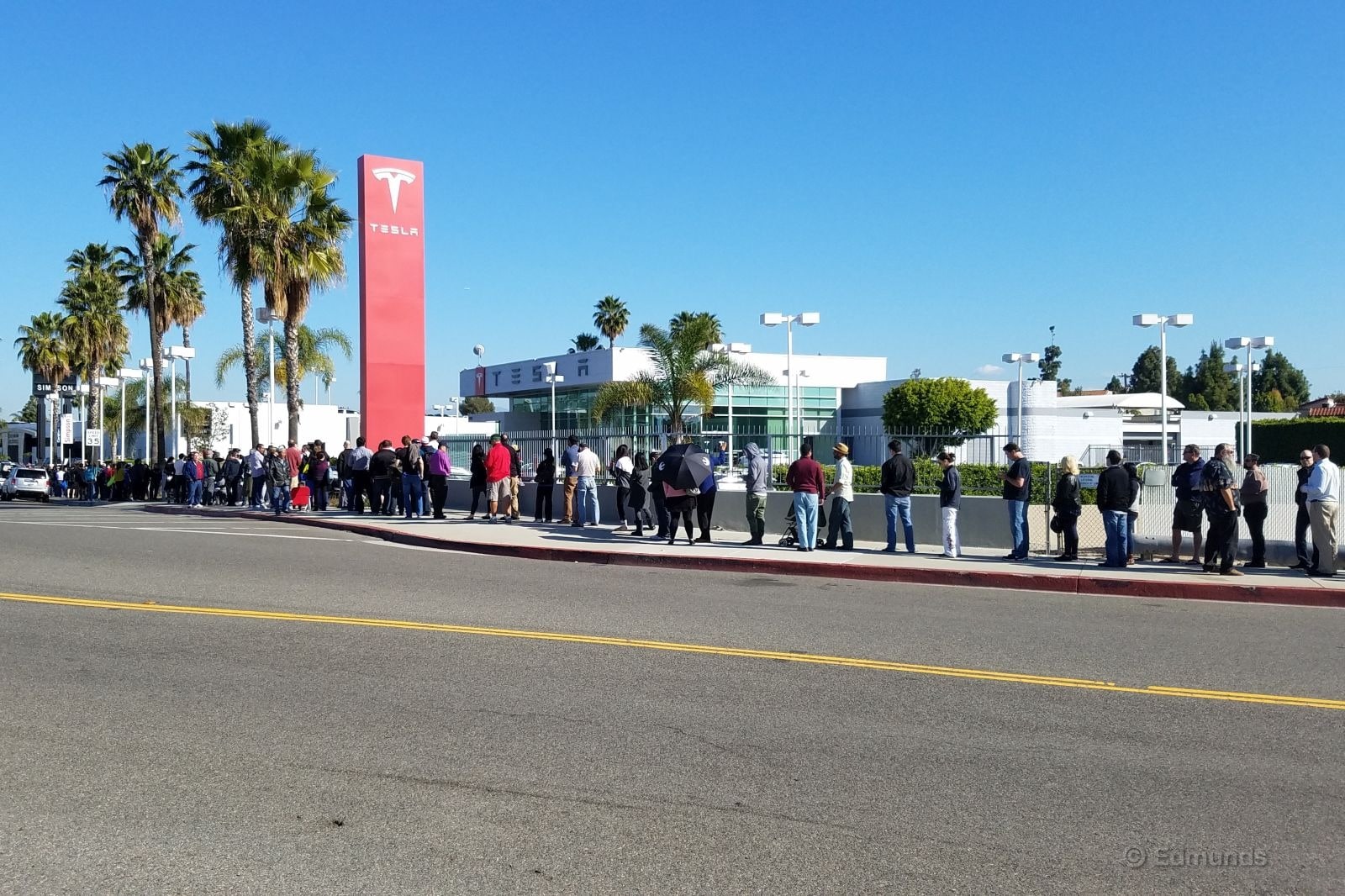
That line had grown very long indeed as the first of us were formalizing our reservations with a major credit card. There were still at least 300 people strung out along the curb by the time I walked back to my car and drove home at 11 a.m.
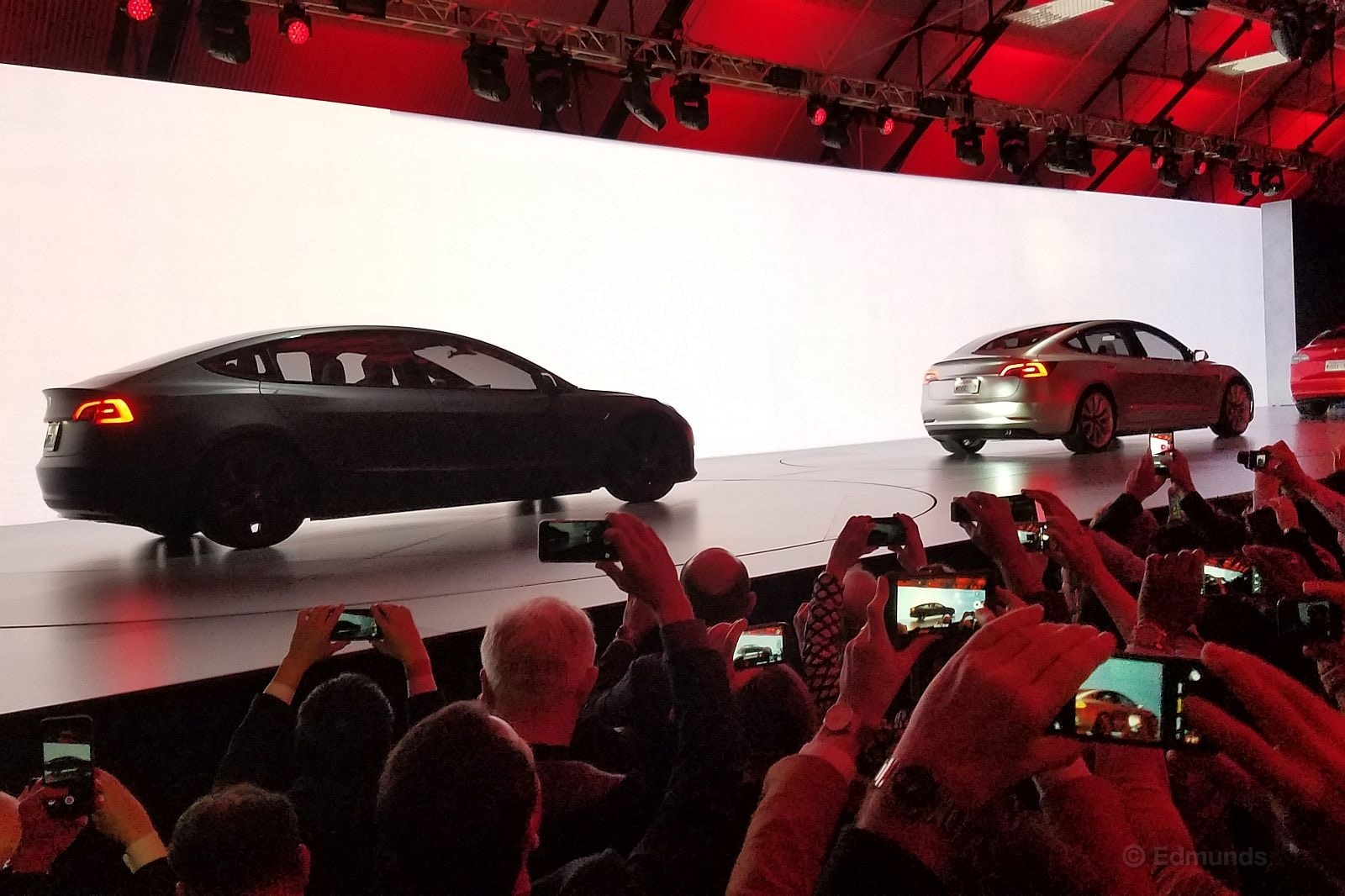
But my long day wasn't over. After going home to grab some shut-eye, I put on my media hat and prepared to attend the Model 3 reservation launch party at Tesla's design HQ in Hawthorne, California, that same night. Only then did the magnitude of Tesla Model 3 mania really sink in. The actual car was revealed before many hundreds of people, and I actually got to ride in one of the prototypes.
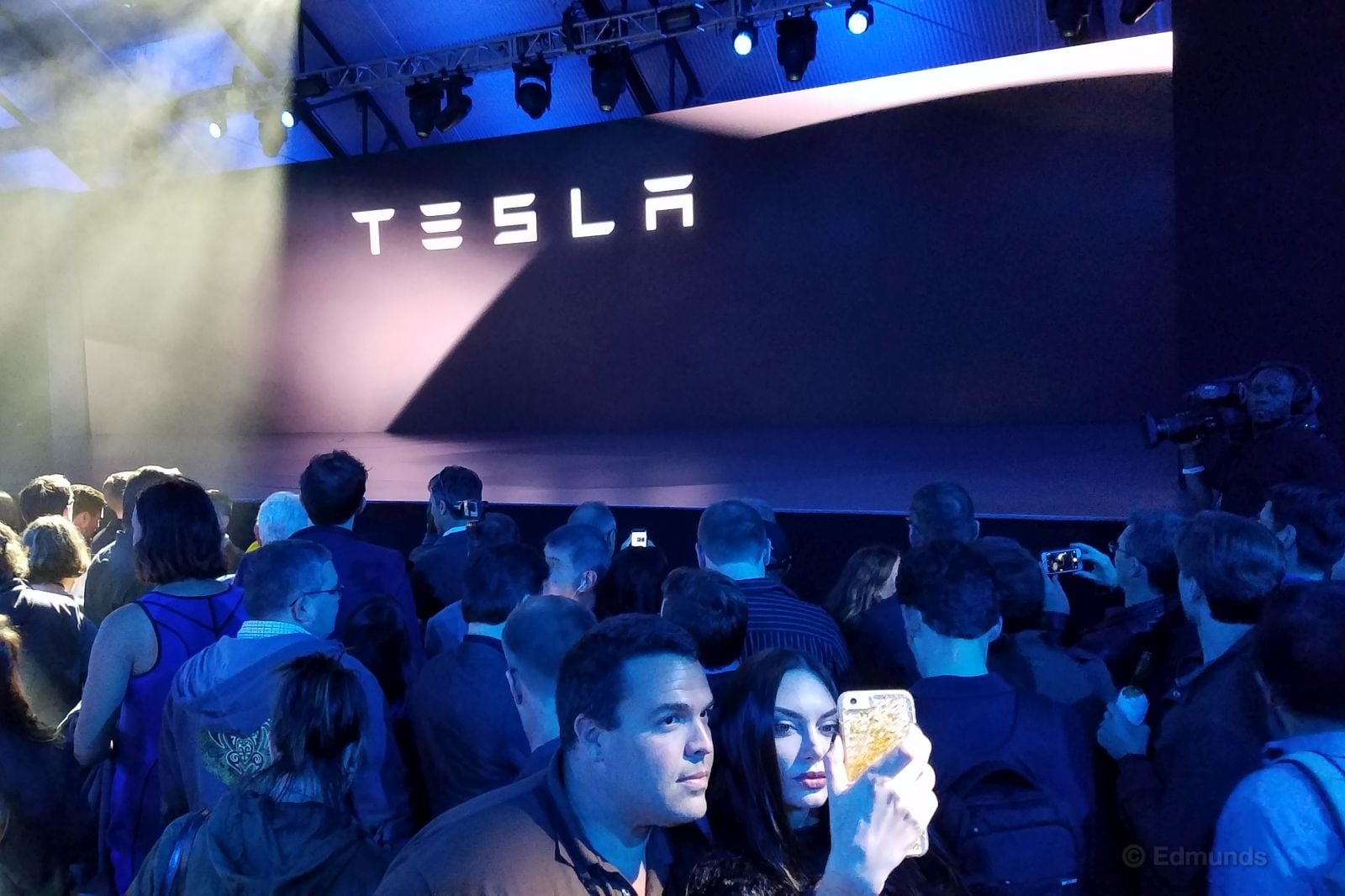
We've been in the middle of this for nearly two years. Will it be worth the wait? We'll soon know. But the purchase process isn't yet complete. Now that we've opened this channel, we'll keep it topped up with regular updates. We'll tell you how we configured the one we ordered, how much it'll cost us and when it will be delivered. And when it finally arrives, we'll mark the occasion with a full long-term introduction, complete with photos of our very own 2017 Tesla Model 3 sedan.
Edmunds is in the process of purchasing this vehicle for the purpose of evaluation.
Ordering Process and Timeline
What is it like to order a Tesla? How does it feel to be on the cutting edge of electric car technology? The short answer is that it's a day of excitement, followed by a wait of many months as news and rumors trickle out.
As the designated car buyer for Edmunds' long-term cars, I went through the process of ordering our 2017 Tesla Model 3 and kept a diary of events, much as I did for the Model X. Here's what has happened so far.
March 31, 2016: Reservations open early this morning for the Model 3. No one knows what the car looks like, yet the Tesla faithful are willing to hand over their hard-earned cash, sight unseen. Our own Director of Vehicle Testing Dan Edmunds is one of them. He camps out at a Tesla store in Orange County, California, to place a $1,000 deposit. More on that here. Delivery preference will be given to current Tesla owners. Speaking of which, we become "current Tesla owners" this very afternoon when we take delivery of our new Model X. The doors look pretty cool; let's see how they hold up over time.
Later that evening, the Model 3 is revealed to the world.
April 1, 2016: We receive a confirmation email from Tesla as proof that we're in the queue. It reads:
"Model 3 production is scheduled to begin in late 2017. North American deliveries will be first, followed by Europe, Asia and Pacific countries, then countries with right-hand-drive configurations. Those who own Model S or Model X cars will be offered priority production slots as a special thanks for supporting the Tesla mission."
We took delivery of our Model X on the same day that we reserved the Model 3, so we're not certain yet if we'll receive priority in the queue.
July 8, 2017: The first production Model 3 rolls off the assembly line. It goes to Tesla founder Elon Musk as a birthday present. Musk says that the first 30 Model 3 customers will receive their cars at an event on July 28. He estimates that production will grow to 100 cars in August, more than 1,500 by September, and then 20,000 by December.
July 28, 2017: As promised, Elon Musk hosts an event in Fremont, California, to deliver the first 30 Model 3 cars. I watch the livestream from home as Musk nervously gives a speech to an enthralled audience. The first vehicles go to employees, who will serve as beta testers for this new model. Dan attends the event and rides shotgun in a prototype model.
Despite the reservation process, Musk says the company will build the more expensive 310- mile, long-range-battery model first. This adds $9,000 to the base MSRP of $35,000 and also mandates the $5,000 Premium package. The package adds premium interior materials, upgraded audio, a glass roof, and USB ports for every passenger. We now have a tough choice: Get the top trim sooner or wait months for the base model. We start mulling that over.
July 30, 2017: Screenshots of the configurator start to emerge. In addition to the long-range battery and premium package, the options are as follows: Any color but black costs $1,000. If you don't like the base 18-inch Aero wheels, it will cost an additional $1,500 for the 19-inch Sport wheels. Want that fancy Autopilot that Tesla often brags about? It'll set you back $5,000. Despite the name, Autopilot can't yet deliver "full self-driving capability," but Tesla's working on it. And it's charging $3,000 to future-proof your Model 3, giving you the update at some undetermined date. All in, a fully loaded Model 3 will set you back $59,500 — a far cry from the "affordable" $35,000 EV we were promised.
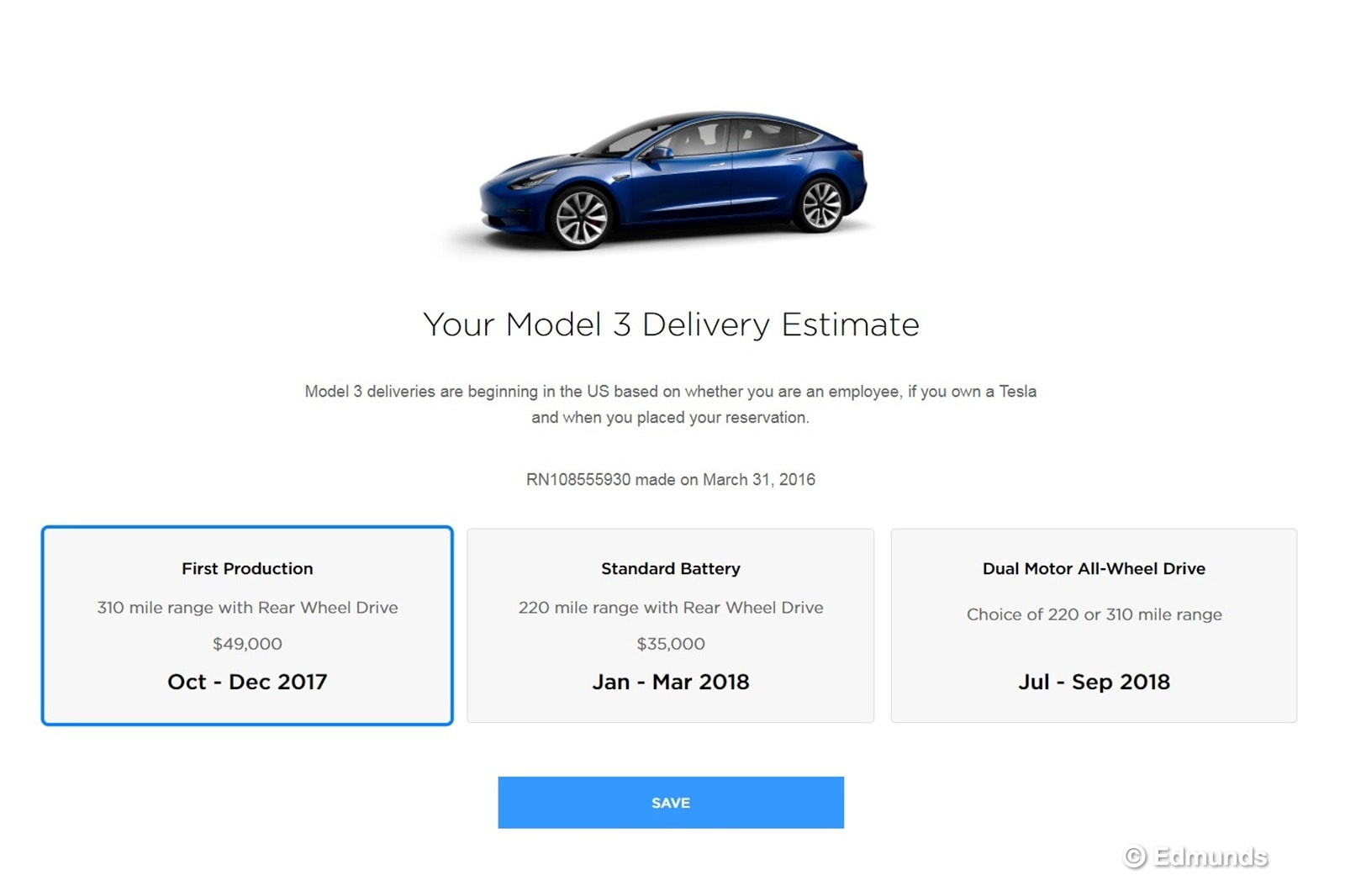
The Tesla website now gives an estimate of when we can expect to take delivery. The first production models are supposed to arrive from October to December 2017, while the standard-battery models are expected from January to March 2018.
November 1, 2017: Reports say Model 3 production is far behind schedule. Musk calls it "production hell."
We get an email from Tesla later in the day:
"Thank you again for your Model 3 reservation. We're making significant progress clearing early production bottlenecks, but as we continue to work through them, your estimated delivery timing will now be slightly later than we originally expected."
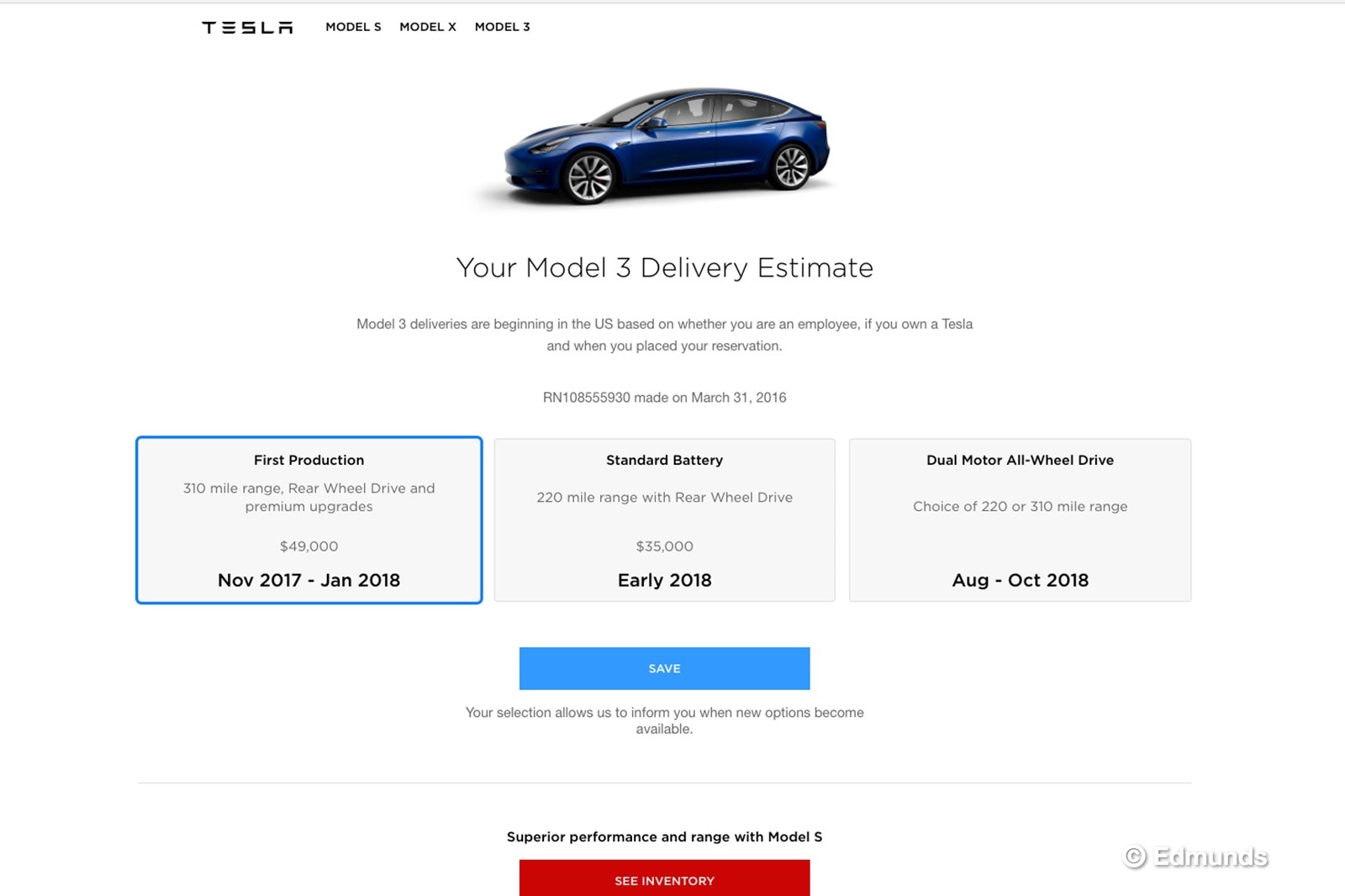
The new estimated delivery for the long-range models is November 2017 to January 2018, while the standard battery model estimate changes to a nebulous "early 2018."
December 7, 2017: We get the email from Tesla saying our Model 3 is ready to order. There's a link to the configurator. We take some time to ponder the color and options.
December 12, 2017: After careful deliberation, we decide on a color and options. For a while, we considered getting an absolute base model, but we ultimately decide on a long-range model with a few options. We've always been early Tesla adopters and feel that we can better serve shoppers by jumping in first and reporting issues, making it easier for our readers to make educated buying decisions.
We deviate from our usual pattern on the wheels. We usually choose the larger option, but this time we stick with the base 18-inch wheels, saving $1,500 and (hopefully) gaining better ride quality.
As for the color, we like the look of Midnight Silver Metallic. Next we add Enhanced Autopilot but pass on the "full self-driving capability." There's no guarantee that it will be released during our window of ownership. We can always add it in later, though it will take an extra $1,000 to do so.
All in, our Model 3 costs $56,000. This includes the $1,000 destination charge.
Once you choose your options, there's an option to apply for financing. We're paying cash so we move on to the next step. Tesla asks you to put down $2,500 to place the order. This payment is in addition to the $1,000 we already put down in 2016. We charge it to the company card, and the order becomes official.
December 20, 2017: I get a call from Brandon, our Model 3 delivery specialist. He verifies our registration information and lets me know he's there to any questions that may come up. This is a pretty cool touch that you don't often see when you order a car. Brandon says he'll notify us when he has a better idea of when the car will be available.
Tesla estimates that the car will be delivered roughly four weeks from when we placed the order, putting it right on target with its revised delivery timeframe.
Barring some other production delay, we expect to pick up our 2017 Tesla Model 3 in mid- to late January 2018. Stay tuned.
Edmunds is in the process of purchasing this vehicle for the purpose of evaluation.
Introduction
When we last left off in the 2017 Tesla Model 3 ordering process on December 20, 2017, I thought we'd be waiting four weeks for our car to be ready. But things went faster than anticipated. Before we get to the car's official introduction details, here's the rest of its order and delivery backstory.
December 26, 2017: I received a belated Christmas present: Brandon, our Tesla delivery specialist, called us to say that our 2017 Tesla Model 3 was ready to be delivered. This was a surprise since we had configured and placed the order only two weeks earlier.
It also was a marked improvement from our purchase of the 2016 Tesla Model X, when configuration to delivery took nearly six months. Brandon said we could have the car as soon as New Year's Eve, but that wasn't enough time for us to get a check ready, so we made a delivery appointment for early January.
We asked to pick up the car at Tesla's factory in Fremont, California, as we had done with our Model S and Model X. But that's no longer an option. Tesla told us that it's cranking out so many Model 3 cars that employees don't have time to give customers the grand factory tour at pickup. You can still take a factory tour, but not when you take delivery.
January 5, 2018: I was all set to pick up our Model 3 at the nearest delivery center, which is in Marina del Rey, a couple miles away from our offices in Santa Monica. There was one last-minute wrinkle, however: California raised its vehicle registration fees for 2018, and because we'd been quoted a 2017 out-the-door price, we were a few dollars short. I scrambled to get a new check and the Edmunds accounting team came through for us.
DMV fees aside, the paperwork signing was lightning-fast. The Tesla rep showed us to a small table, where a personalized "Congratulations" sign greeted us. From there, I just needed to sign in three places and the deal was finalized. No additional sales pitches or mountains of paperwork. I wish all car purchases were this fast.
It has been about 21 months from the time Dan Edmunds first placed the deposit for the 3 to when we took delivery. And because we're repeat Tesla buyers, we're getting our car earlier than most people. As a reference point, Dan placed a deposit for his own Model 3 on the same day and he has yet to receive a "time to configure" email. If you have ordered a Model 3 but aren't already part of the Tesla ownership club, you, too, will have to keep waiting.
What Did We Buy?
We bought what's been billed as the affordable Tesla. Sort of. Before the advent of the Model 3, owning a Tesla meant spending at least $75,000 and often in the ballpark of $100,000. The Model 3 changes that: Its starting price of $35,000 brings it closer to being a car that average people can afford. But that base price comes with a few caveats.
What Options Does It Have?
If we wanted our Model 3 within the first production run (and we did), there were a couple of mandatory options. First, we'd have to buy the version with the 310-mile long-range battery: a $9,000 option. And second, we had to go with the $5,000 Premium Upgrades package. The package includes such features as 12-way power seats with heating, open-pore wood trim, LED foglights, a glass roof and a premium audio system. So from this angle, an early Model 3 costs $49,000, not $35,000. Make that $50,000 because the mandatory destination charge is $1,000.
From this point, there were few remaining options to consider. Any color other than solid black costs $1,000. We chose Midnight Silver Metallic. The optional 19-inch sport wheels and tires cost $1,500, but we passed on those. We'd opted for the larger wheels on our two previous Tesla vehicles, so the Model 3 will be our opportunity to test out the standard 18-inch Aero wheels and tires.
We did go for Enhanced Autopilot, which costs $5,000. There was one other option available: "Full Self-Driving Capability," for $3,000. Tesla promises that at some time in the future, the Model 3 will "be capable of conducting trips with no action required" by the person in the driver seat. That time frame is a bit too vague for us, so we passed. This is a software option we can always buy later, albeit for $4,000.
All in, our Model 3 cost us $56,000 — well past the base price. And given that the average new-car transaction price is about $35,000, it's still a car that's out of the range of most buyers. That said, we're early adopters, and such folks always pay more. We hope that our early experiences will help people decide what options they want and give them a preview of how the Tesla Model 3 holds up over time.
One more thing: Model 3 owners will have to pay for use of the Tesla Supercharger network. The prices vary by state, but we'll be keeping track of our costs in our monthly updates.
Why We Bought It
The Model 3 is a significant vehicle for many reasons. It made hundreds of thousands of people so excited for an electric vehicle that they were willing to put down a $1,000 deposit for a right to get in line. No other EVs have come close to that level of interest. The Model 3 has a more attainable cost of entry for people who saw the Model S and aspired to one day have a Tesla to call their own.
And for Tesla CEO Elon Musk, the Model 3 has long been part of his master plan to "enter at the high end of the market, where customers are prepared to pay a premium, and then drive downmarket as fast as possible to higher unit volume and lower prices with each successive model."
Building an estimated 5,000 Model 3 sedans a week by the first quarter of 2018 while producing its other vehicles will be a test of Tesla's quality and manufacturing process. Our Model X had fewer issues than our Model S. Will the Model 3 continue this trend of improved reliability?
Follow the car's progress on our long-term road test blog, where we'll log our latest thoughts and impressions of this 2017 Tesla Model 3 sedan.
Edmunds purchased this vehicle for the purpose of evaluation.
Will an XL-Size Mountain Bike Fit?
Maybe you've heard: I'm fairly tall. I'm nowhere near the tallest guy you've met, but a height of 6 feet 2 inches puts me in what statisticians call the 95th percentile. As a result, my mountain bike is pretty big. This all came to a head when I decided to go for a ride on a weekend when I was driving our 2017 Tesla Model 3 sedan.
My bike isn't the bulkiest one you've ever seen. For one, it's a hardtail, not a full suspension bike. And it doesn't have those cartoonishly fat tires that are starting to gain, ahem, traction. That said, it is quite literally a giant. Says so in 2-inch letters right on the frame. And it is Giant's XL-size mountain bike frame with 29-inch wheels, too. Call it an XL 29er in front of your biker friends and you'll get knowing nods.
As for the Model 3, it has an all-glass roof. All 3s built so far have one. It's part of the Premium Upgrades package, an option that is mandatory until further notice. Point is, the glass roof spans all the way to the seam where it meets the body sides, leaving no room for the kind of hidden rack receptacles you see on many other roofs. The owner's manual hints at the future existence of a Tesla accessory rack, but it hasn't yet hit the market. I can only imagine what it might mount to.
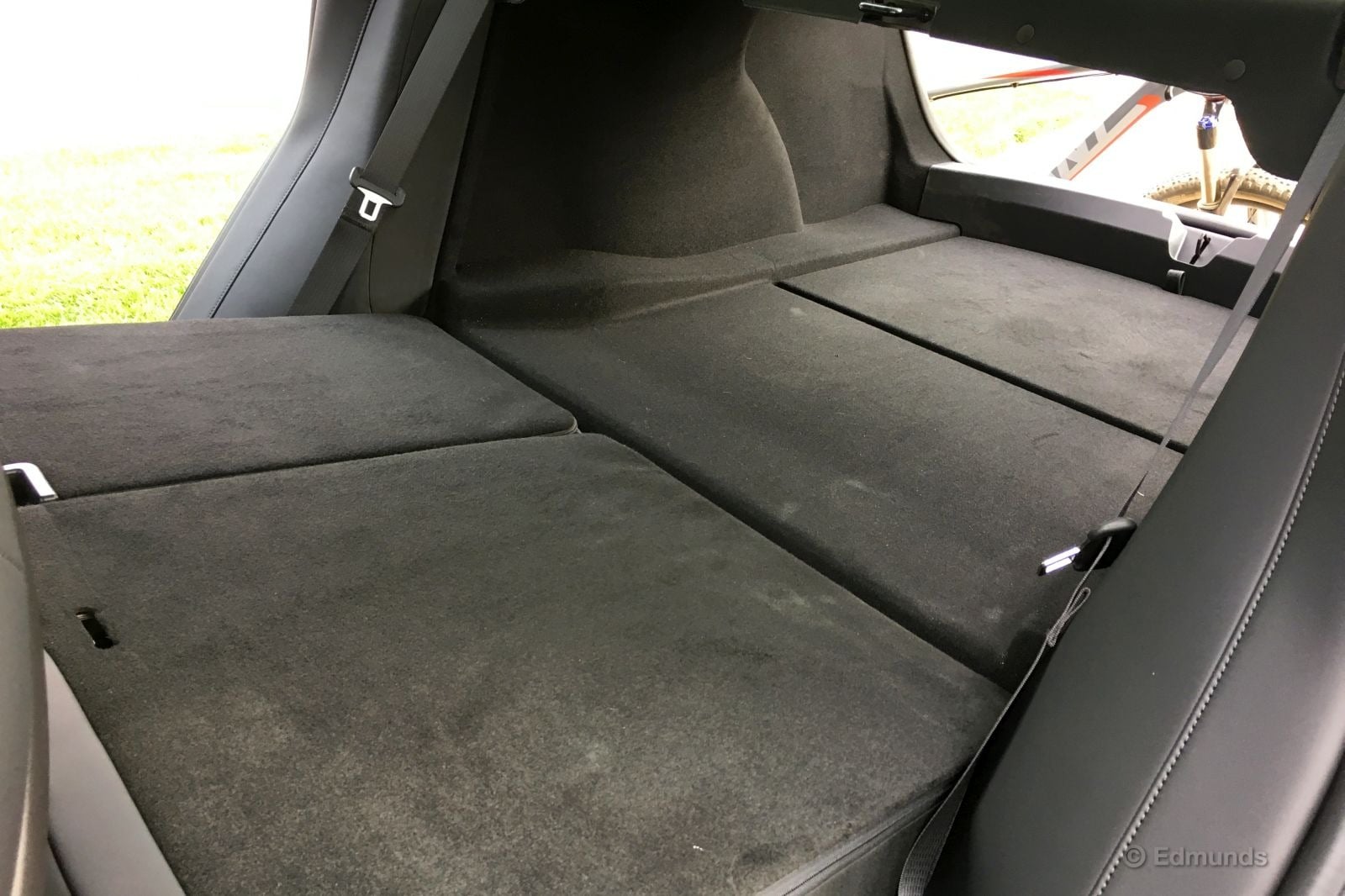
That leaves the trunk. Unlike the Model S sedan, which was really a hatchback, the Model 3 is a true sedan with a trunk. Like many others of this type, it has 60/40-split rear seatbacks that fold down to expand the load area.
That last sentence is an understatement. The portal that's revealed when you fold the seats is bigger than the trunk opening itself. The seatbacks fold flat into the floor like a crossover SUV. The result is something that even I could sleep on — and probably will in a future episode.
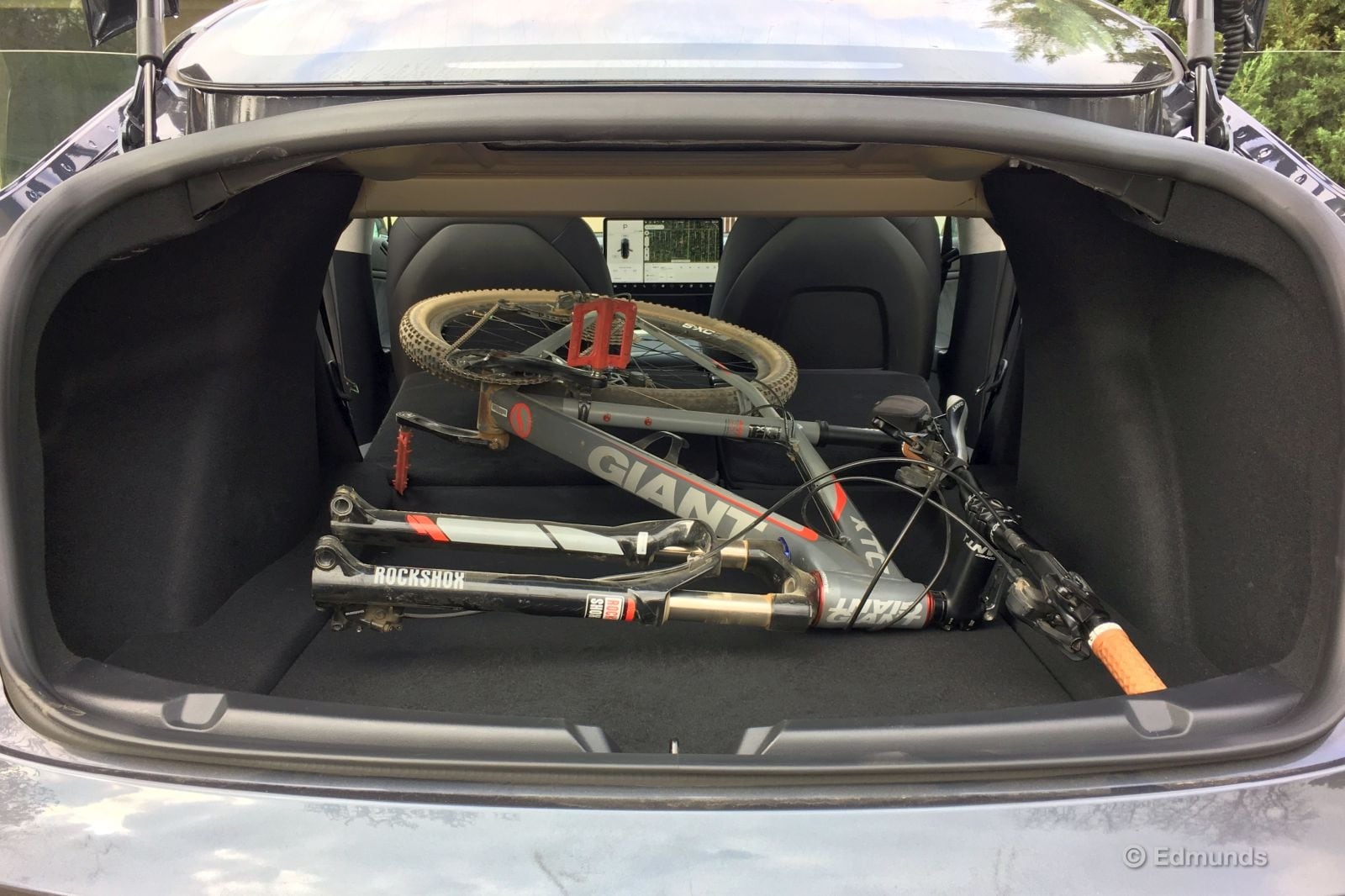
I had to remove the front wheel, but that's standard operating procedure. The biggest problem was not the height of the trunk opening but rather the depth. The bottom edge of that sloping rear window comes back pretty far, which made it hard to get enough leverage to hold the bike horizontal and keep the pedals from dragging on the way in. Great for groceries, less so for this.
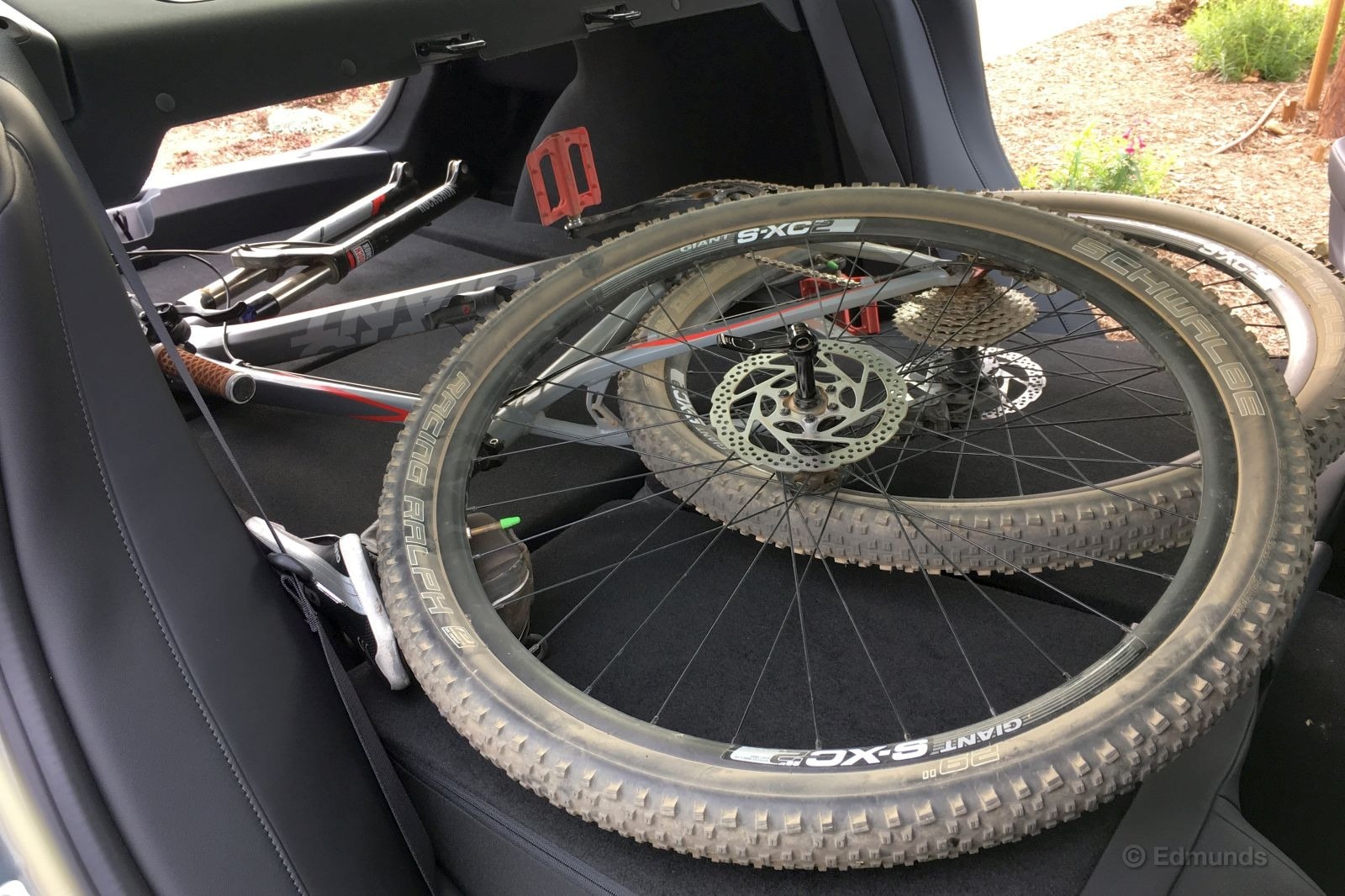
Still in all, it was pretty simple if I slid the bike in tail first and chain up. I didn't have to drop my seat post to slip it through the opening either. There was more than enough longitudinal space to slide it in far enough to lay the bars flat at 90 degrees, and in this position the back tire was nowhere near the front seat, even when racked to my long-legged driving position. There's tons of room for gear bags all over the place, too.
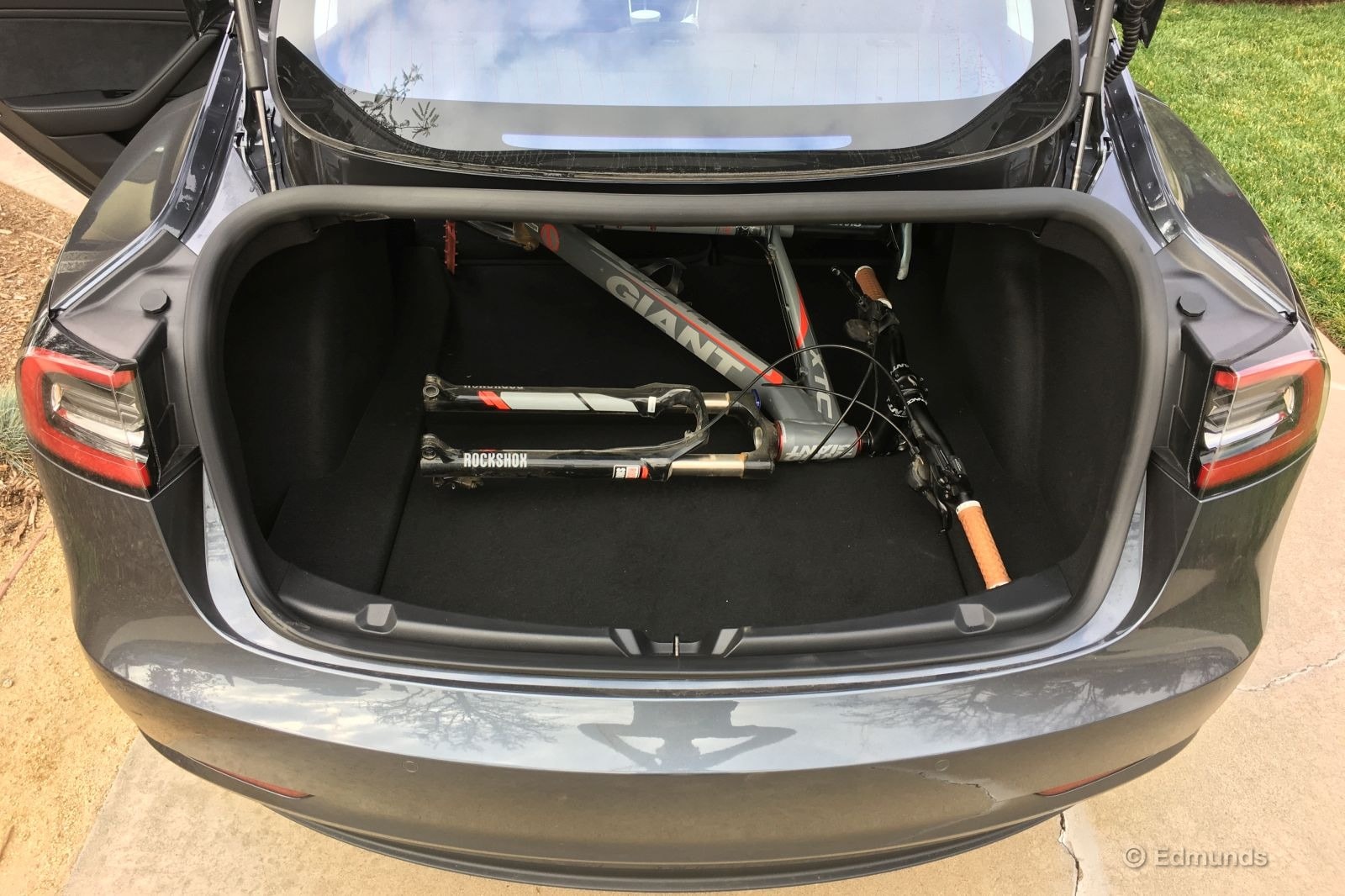
It's not perfect. This method only works with one XL 29er bike. That's no deal-breaker for me because I drive solo to meet up with buddies who come in from other directions. I'm more concerned that the cargo area carpet is a little too frizzy. Next time I'll lay out a blanket or a hunk of cardboard.
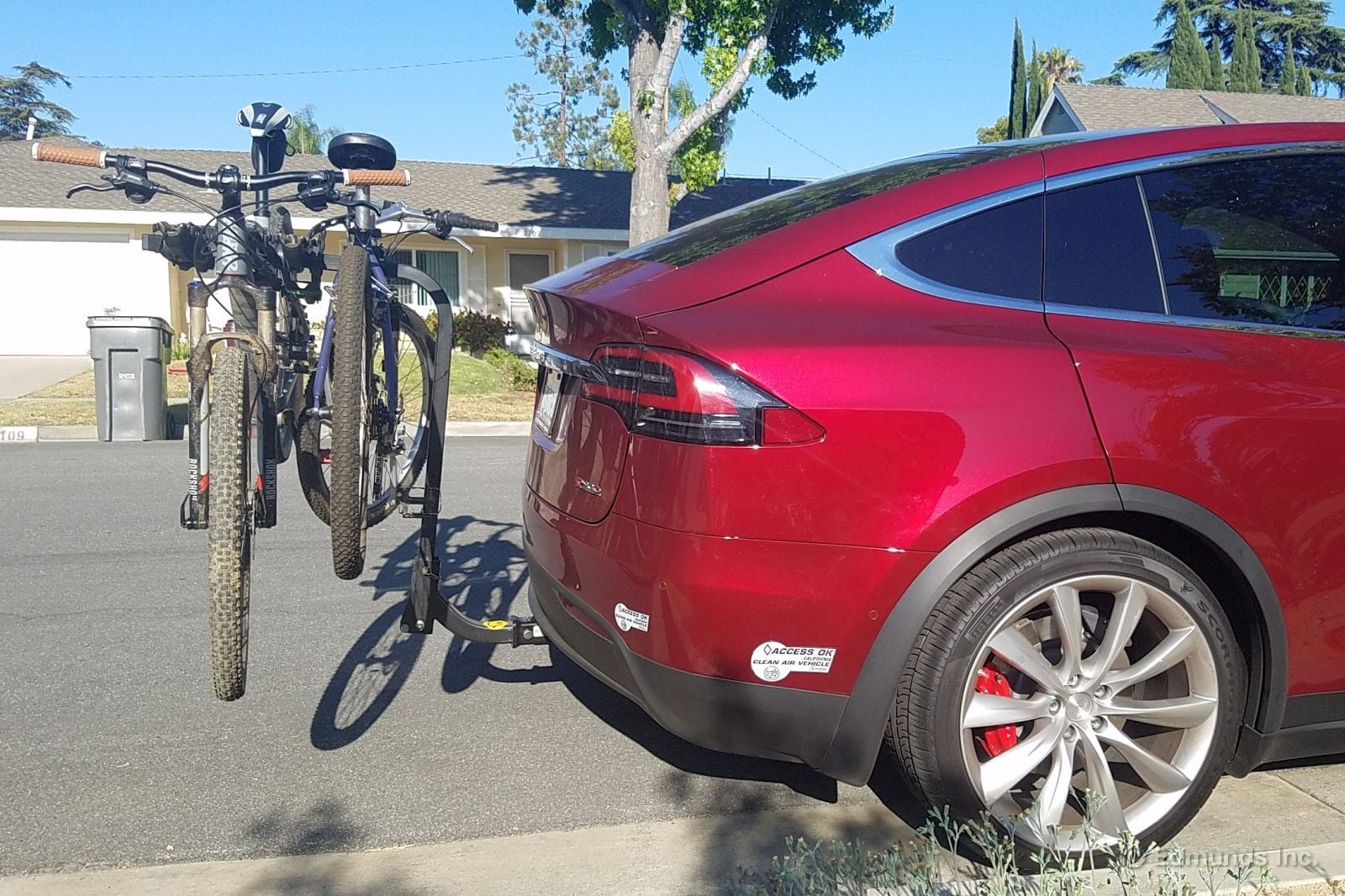
You can bet there will be a next time. I really like the security that comes with hauling a bike inside, and loading it does not feel like a tedious game of Operation. The whole time I was at it I couldn't stop chuckling at the thought that the Model 3 is much better at bike hauling than our larger Model X ever was. That "SUV" had non-folding middle-row seatbacks and was less suitable. It steers you toward exposed hauling via the hitch. No thanks.
Monthly Update for January 2018
Where Did We Drive It?
We took possession of our 2017 Tesla Model 3 sedan on January 5, which left 27 days before the month ended. In that time we added 1,388 miles. That may not sound like much, but it does work out to a rate of nearly 1,600 miles per month, pretty much where it needs to be to achieve our nominal target of 20,000 miles in a year.
And we pulled it off despite a steady diet of local commuting and running around town. We haven't really gone anywhere, the lone exception my weekend drive into the local mountains to a place called Crystal Lake Cafe. You'll find it where Highway 39 dead-ends high up in the San Gabriel Mountains. Highway 39 is the sort of road that gets a lot of attention from motorcyclists and drivers of nimble-handling cars.
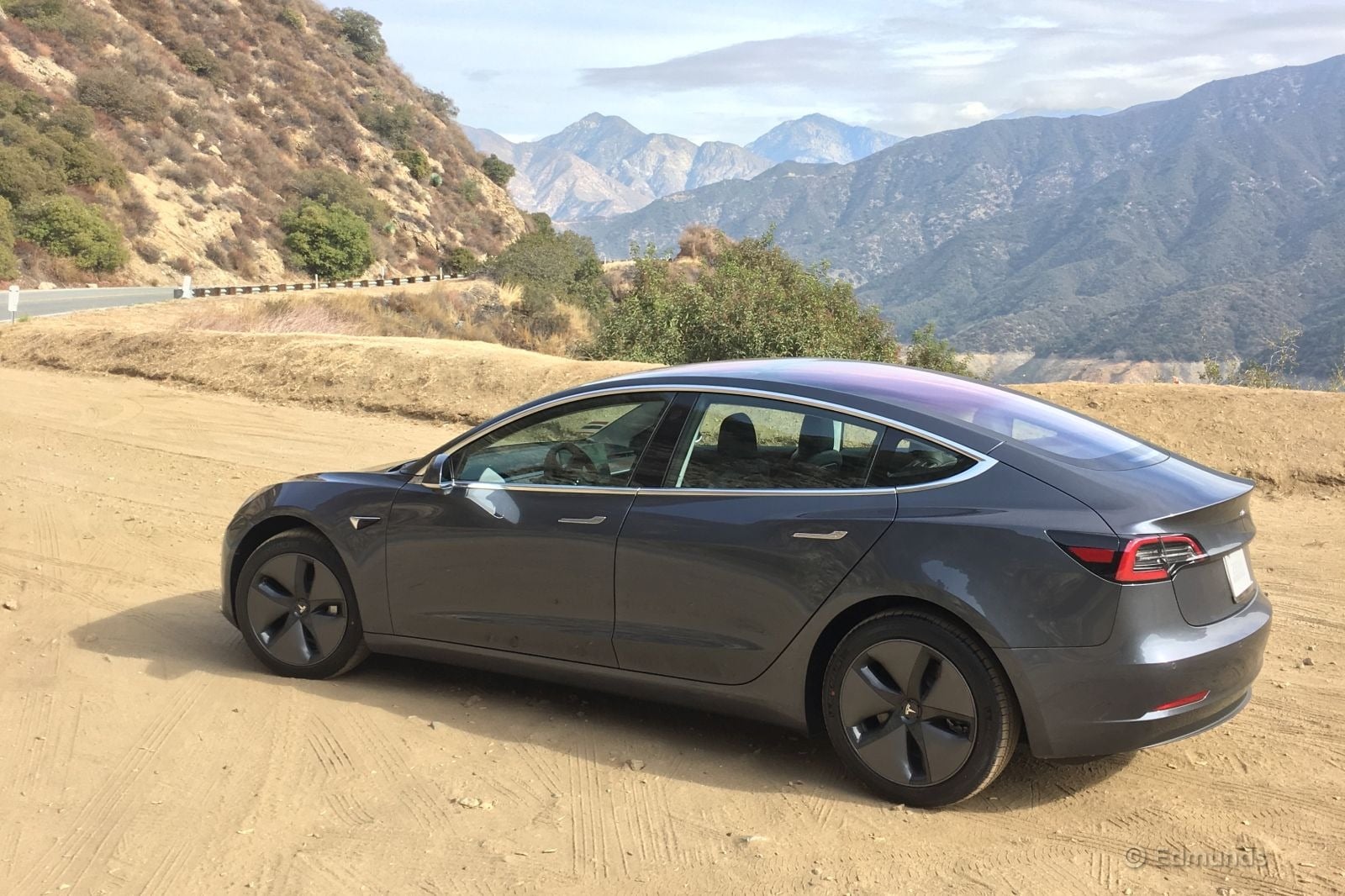
What Kind of 'Fuel Economy' Did It Get?
So far we've charged our Tesla 14 times. That's an average of fewer than 100 miles per charge, which is typical if you've got daily access to a charger at home or at work. With a gas-powered car, it's obviously more convenient to wait for a low fuel level before you fill up. But there's not much point in running the Tesla's charge down if you can plug in every time you park in your spot.
We've also kept the car exclusively in Normal range mode, not Max mode. Max range mode is where the car's 310-mile range comes from, but Tesla suggests saving that mode for long road trips or journeys into unfamiliar territory off the Supercharger network. Tesla recommends Normal mode for daily use because it's better for long-term battery health. This mode tops out at 90 percent of a full charge, which amounts to a working range of 279 miles. That's still impressive; even this partial charge adds more Max range than those of our recently departed P90D Model X and our old P85 Model S.
Of our 14 charges in January, 10 happened in our parking garage using our own high power wall connector (HPWC). We've hooked a meter to it, so we can record the number of kilowatt-hours (kWh) consumed during each HPWC session. Three other charges were handled with 240-volt ChargePoint Level 2 public equipment. That charge data is usually displayed on a screen when a driver unplugs, but if someone forgets to record it, we can log into our ChargePoint account to see the records after the fact.
The final charge occurred at a Tesla Supercharger. Model 3 owners must pay for Supercharger visits, and we can see the number of kWh we were charged for by logging into our Tesla account. We paid $8.20 after filling our battery with 41 kWh of electricity, which works out to 20 cents per kWh.
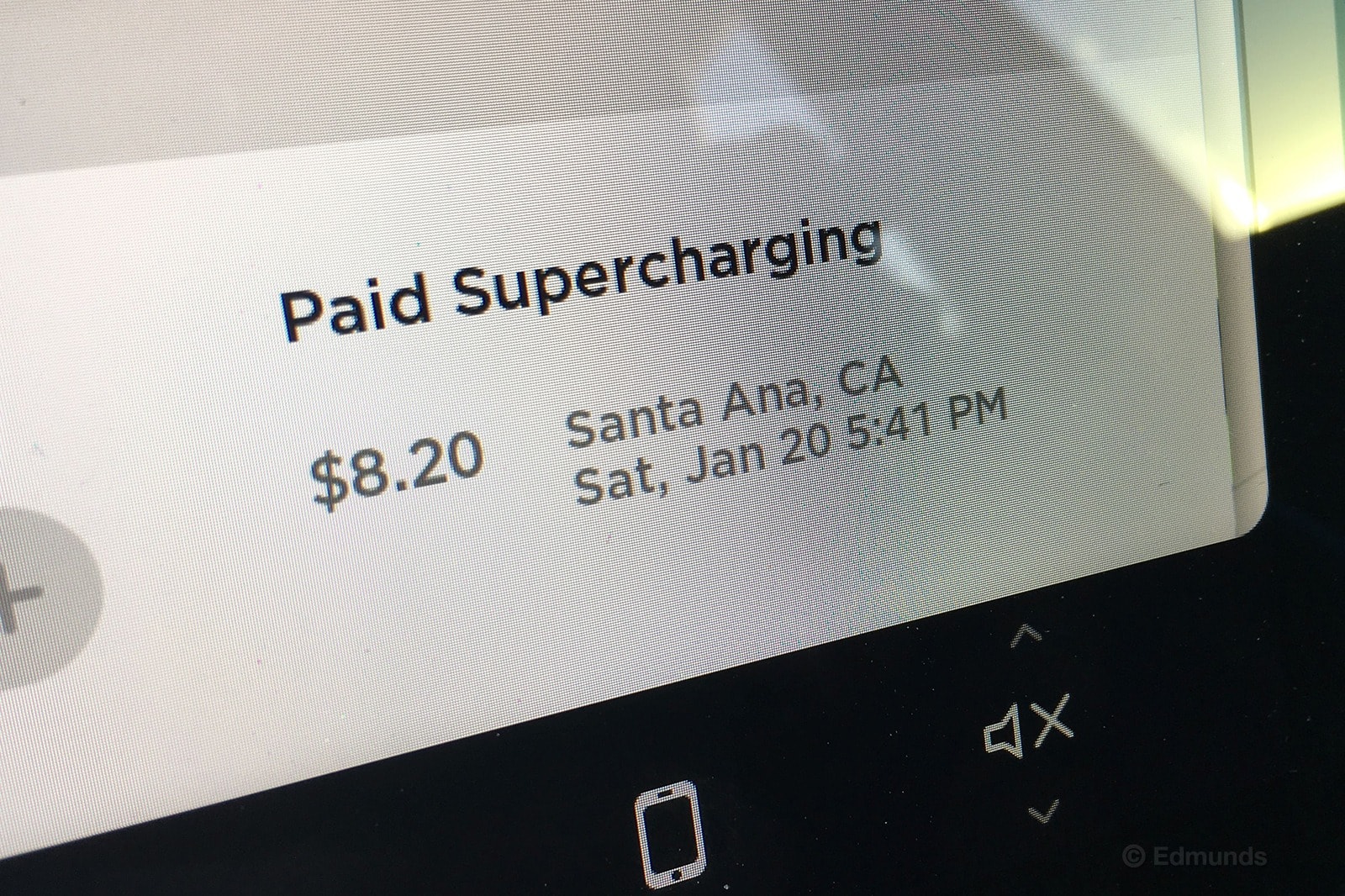
Here's where things stand on the consumption front. Two of the above sessions were excluded because they were tainted by high-speed track testing. As you'll see below, we've beaten the EPA rating on one occasion, but our overall average is lagging behind.
Current odometer: 1,388 miles
Average lifetime consumption: 30.2 kWh/100 miles (111.6 miles per gallon equivalent)
EPA consumption rating: 27 kWh/100 combined (126 mpge)
Best fill: 25.6 kWh/100 (131.5 mpge)
Have I told you how much I hate mpge? You're buying electricity in kWh units, so I'd suggest getting used to kWh per 100 miles. Smaller is better with this unit: Use less and pay less.
Also, Tesla vehicles are set to display consumption in a similar unit: watt-hours per mile (Wh/mi). Tesla owners are quite familiar with this measurement because it's a handy feedback metric that's prominently displayed in the car. You can zero it using the trip odometer, but they've got a "Since Last Charge" screen that automatically restarts the calculation whenever you unplug. This is so handy that I never use Trip A or Trip B meters in the Tesla as I do in gasoline cars.
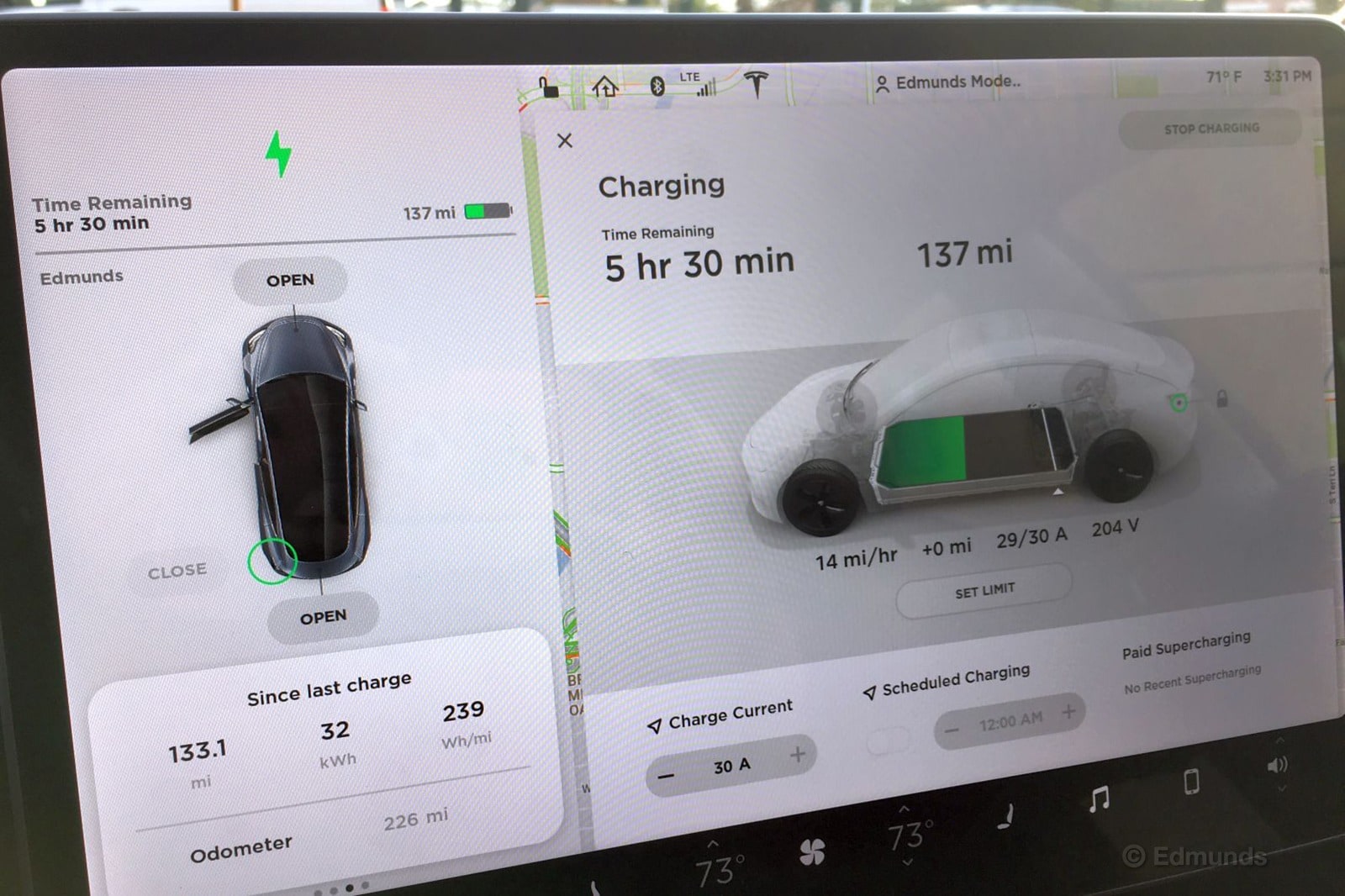
I'm including the Wh/mi figures because they're displayed in the car, but these are imperfect when it comes to actual consumption because they only account for what's flowing between the battery and the electric motor. As pure onboard figures, they do not include the energy lost during the act of charging that battery, which typically ranges between 10 and 20 percent of the total, sometimes more. The kWh/100 miles figures summarized above (including the EPA ratings themselves) do account for such losses. They're based on electricity consumption at the charge station's meter, so they alone account for the amount of electricity you'll actually buy.
Average onboard consumption meter: 251.7 Wh/mi
Best meter reading: 200 Wh/mi
Worst reading (aka The Leadfoot Award): 356 Wh/mi
Right away, it is plainly obvious that the Model 3 is more efficient than the larger, heavier Model S and Model X. With those cars, readings in the high 200s were nonexistent, and we saw many "tanks" consuming Wh/mi in the 400s and 500s.
Both the Model S and the Model X had a detailed energy graph screen with a faint indicator line that showed the target value you'd need to hit to achieve their rated range. That value was 310 in the Model S and about 340 in the heavier Model X. But the Model 3 lacks that graph, so we're not sure of its nominal energy consumption target value.
Our current average consumption of 30.2 kWh/100 miles is a bit worse than the EPA consumption rating of 27 kWh/100 miles, which suggests our average consumption of 251.7 Wh/mi isn't cutting it. I'm thinking it'll take something around 220 Wh/mi to have a shot at achieving the range and consumption ratings of this car.
Our range data supports this theory. Remember, we're using Normal mode for now, so the target for purposes of this month's analysis is 279 miles. But no one runs an electric car to zero — and no driver should. That's why I like to do my analysis using what I call Projected Range, which is a sum of the Since Last Charge trip meter reading and the remaining range reading, two of the values we record each time we plug in.
Average projected range: 269.8 miles
Best projected range: 287.7 miles
90 percent of EPA-rated range (adjusted Normal mode full charge): 279 miles
As we saw with consumption, our best projected range beats the adjusted estimate, while the overall average lags a bit behind. No doubt that's because everyone is still feeling this car out. The situation may yet improve as the newness wears off and the driving becomes more routine. We haven't done any extended drives or road trips yet, either.
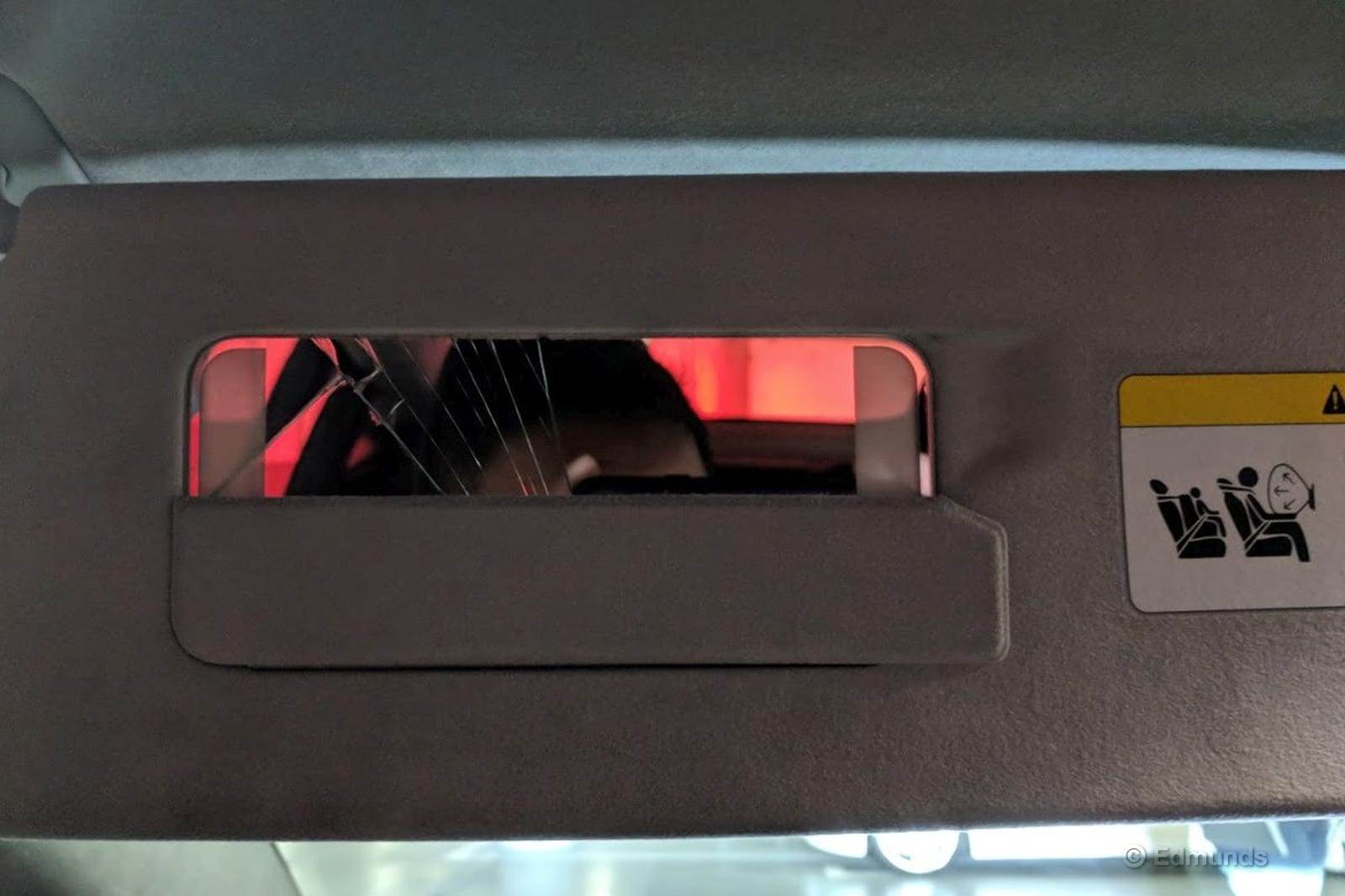
Maintenance and Upkeep
It's too early for any scheduled service, but we've had some issues. Our car was delivered with three flaws, two of which we didn't notice on delivery because neither is the sort of thing you'd think to check. First, the driver's side vanity mirror is cracked. Second, the trim panel that covers the back of the driver's side front seat is loose at the bottom. Finally, one of the frunk hood seams is under-flush by about three-sixteenths of an inch where it runs along the right front fender.
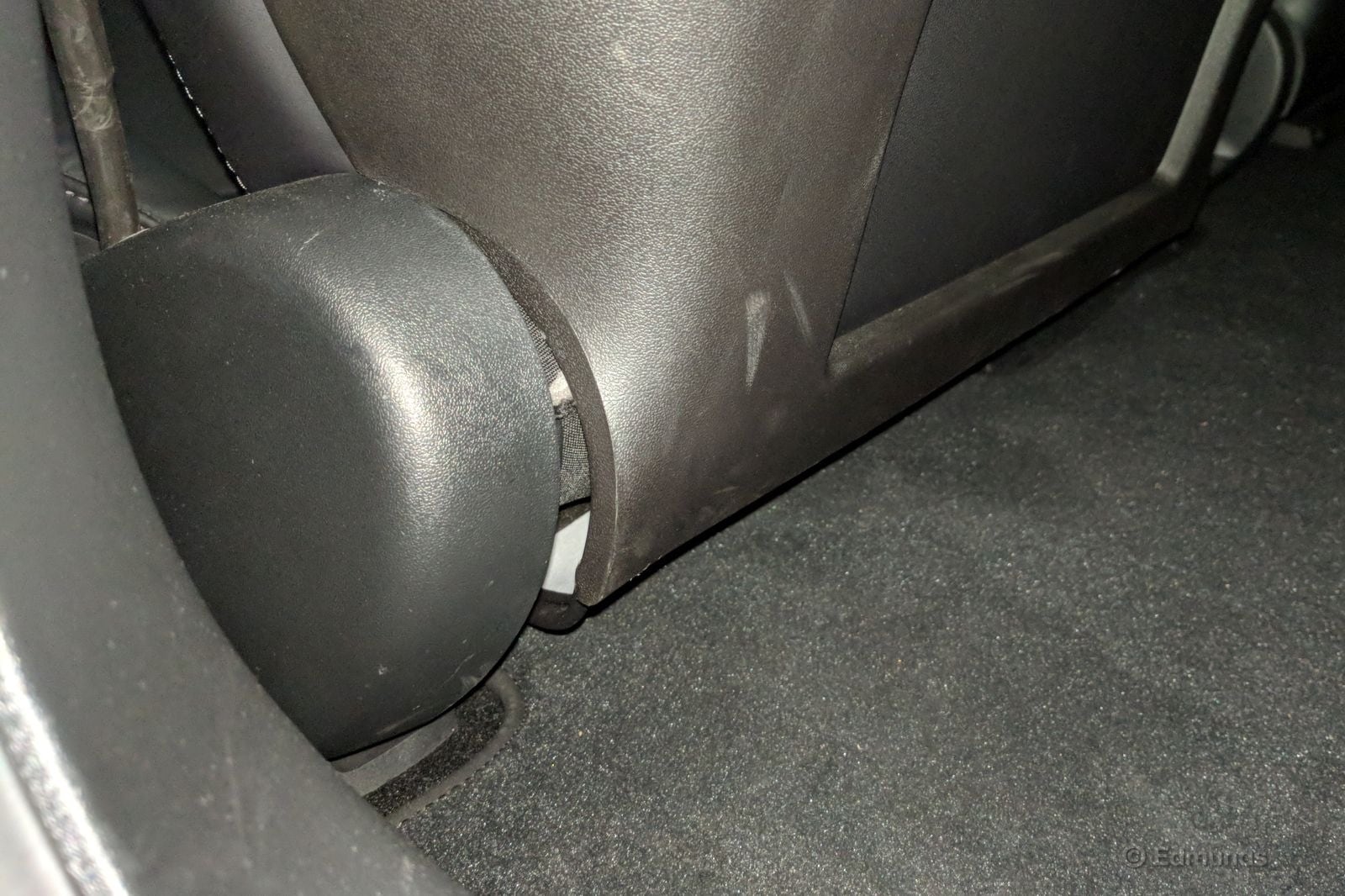
Beyond that, I've experienced odd Bluetooth phone inconsistencies, in which the audio connection failed but the phone connection continued working. A screen reboot was required to get that back on track. On another occasion I saw a "regenerative braking limited" warning for reasons I do not understand. This normally occurs when the battery is 100 percent full, but we've never recharged it past 90 percent, and the battery was lower than that because it happened one morning with 20.1 miles on the trip meter already.
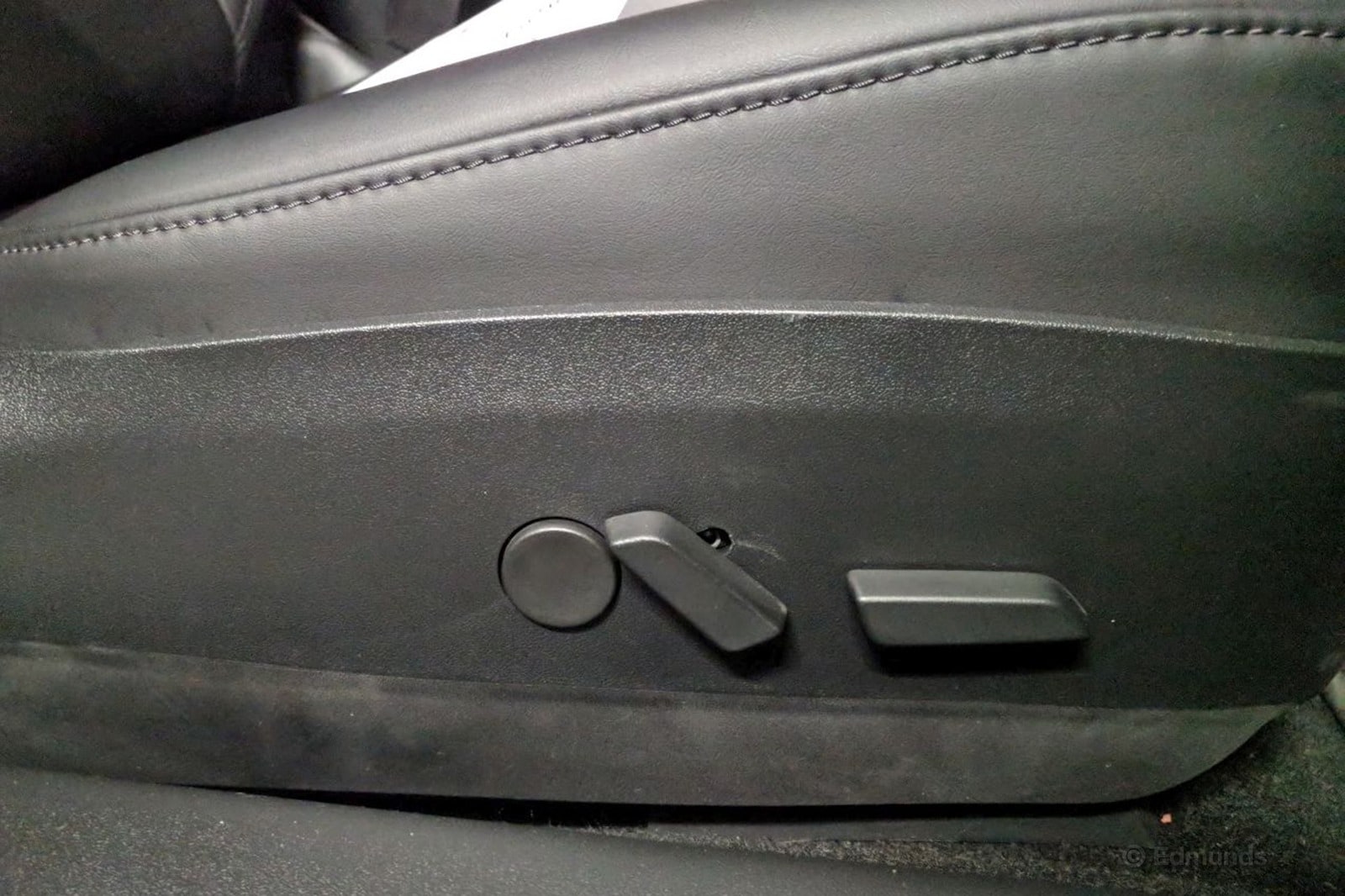
I'm embarrassed to report the final issue because it's my fault. With the door wide open, I crouched onto the passenger doorsill while leaning in to point out some features to a colleague. When I stood up, a belt loop snagged on the passenger-seat recline adjuster and snapped off. At least I think that's what happened. I only heard it let go as I stood up. It'd be easy for me to weasel out of responsibility by saying the controls are flimsy, but I have not examined enough others up close to have an opinion.
Our local Tesla service center knows about all of this, and it has ordered the necessary parts. Who knows how long that'll take in the face of the overall "production hell" build delays Tesla is trying to work through. All we know is we're not handing over the car until the parts arrive.
Logbook Highlights
Performance
"Highway 39 is tight and sinuous, and there's a fair bit of climbing through several switchbacks. Up here this chassis feels really sorted and well-balanced, and I really like the way the steering reacts, as well as the feel of the wheel in my hands. The electric motor delivers plenty of thrust, too. I actually caught up to a pair of sport bikes on the way up and walked away from an Alfa Romeo Giulia." — Dan Edmunds, director of vehicle testing
"The brakes felt smooth and easy to regulate on the way down the mountain from Crystal Lake. But even though I had the regenerative braking set to high, I did find myself using the brake pedal more often than I had when driving the Bolt EV down the same mountain at a similar clip. I suppose it's because the Model 3 is a rear-wheel-drive machine and the Bolt is a front-driver. Stability demands that the bulk of your braking be done on the front end, and that means Tesla can't set the Model 3's regen level quite as high. You'll find yourself using the brake pedal instead of lift-throttle braking more often in situations like this. The end result is an overall loss of harvesting efficiency because some energy that might otherwise be recoverable in a front-wheel-drive EV will be lost as heat in the Model 3's front brake pads and rotors." — Dan Edmunds
Interior
"Wow! The driving position is fantastic. And the view out is immense. Seat, wheel, pedals: They're all in perfect agreement. And so far I don't hate the glass roof at all. Unlike in the X, the 3's windshield, sun visors and rearview mirror are utterly normal, and the sun can't beat down on my forehead any more than it can in any normal car. Ask me again in the heat of summer, but I'm optimistic." — Dan Edmunds
Technology-Audio
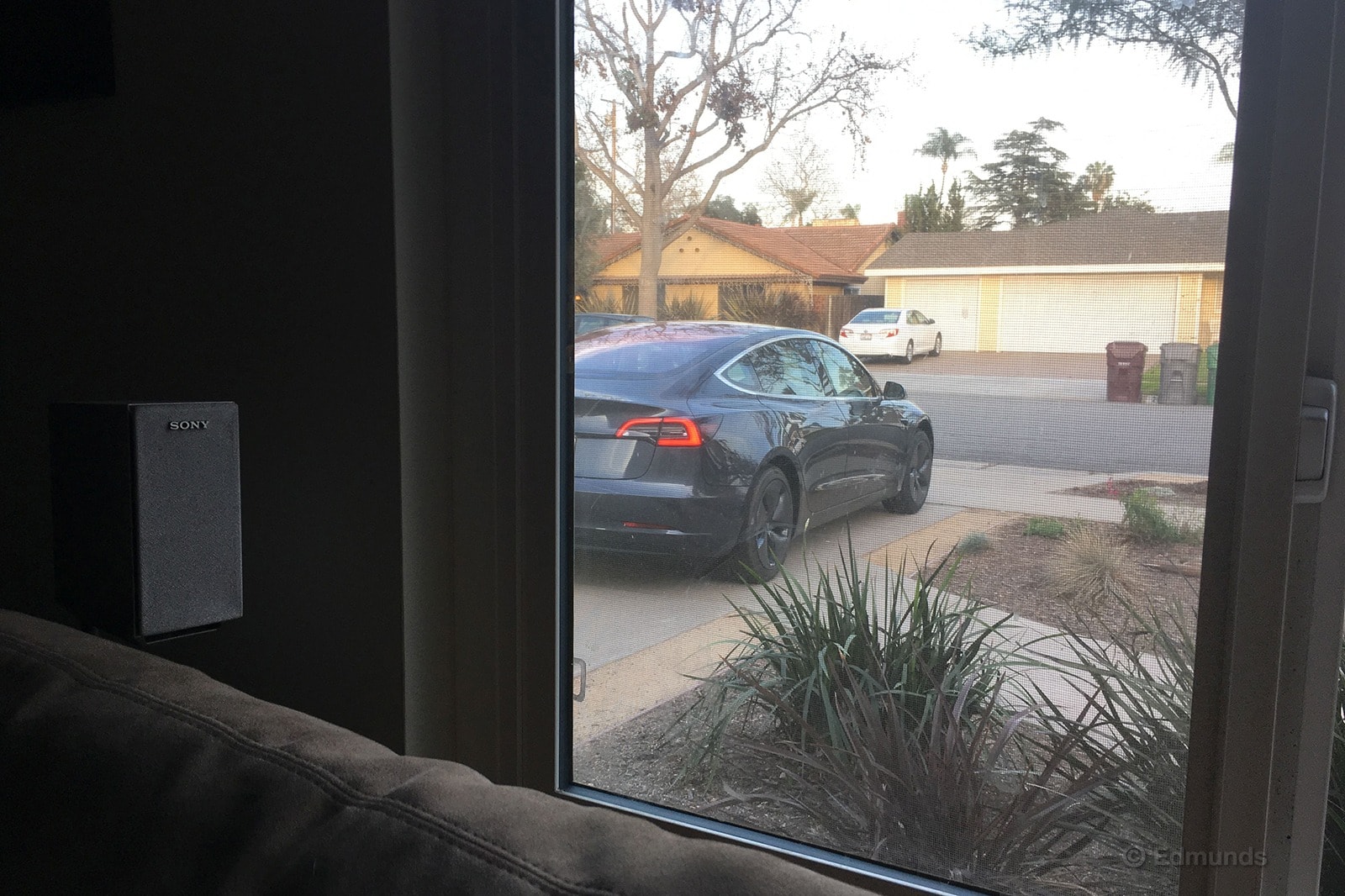
"I really like how I can use my smartphone to function as the key that unlocks the car and allows me to start it without doing anything. But the exterior sensors of the Bluetooth-based system are too sensitive to the point of annoyance. The other day I was standing in the driveway talking with a neighbor after I climbed out of the car. As we spoke, the Model 3's lights flashed and the mirrors folded as it locked and unlocked itself over and over. We moved off a couple of steps, but the distance necessary to keep it from happening was ridiculous.
"Later I was sitting on the couch watching an NFL playoff game. The Model 3 was outside in the driveway about 25 feet away, with a wall and double-pane glass window in between. You guessed it: The mirrors and lights flashed every few minutes. It's currently unlocked. No, wait. There it goes again. Locked now.
"This is ridiculous. I can overcome this by shutting down the Tesla app on the phone. That's fine if you're in for the night, but what if you want to monitor the charge while it's parked in the driveway? What about talkative neighbors who ambush you when you climb out of your car? Any switch you have to flip or app you have to shut off each time you approach or depart the machine erodes the purpose of this otherwise cool hands-free feature." — Dan Edmunds
"The premium audio stereo that comes with the Premium Upgrades package puts out some very crisp, clear, full-throated sound, and I feel zero need to mess with the EQ settings. Sounds great in the default mode. And the sound doesn't distort when you crank it way up. Granted, full volume isn't quite robust enough to satisfy some headbangers I know, but it's more than loud enough for me." — Dan Edmunds

"The Model 3 wiper controls will someday inspire an entire stand-alone post, but for now let's focus on the Auto setting. It has one, but the sensitivity is not adjustable. This would be fine if the system was perfectly tuned, but it's not even close. The windshield gets quite wet before it decides to wipe. I find myself taking matters into my own hands by pushing the one-wipe button on the end of the headlight stalk on a regular basis.
"I've heard rumors of a wiper change in an upcoming Model 3 over-the-air (OTA) software update, but I have no idea if it'll have anything to do with this. But the very existence of OTA updates does mean that certain issues may get fixed. This wiper issue, the Bluetooth stability I've experienced, the odd regenerative braking limitation: All of these could theoretically go away after an OTA update." — Dan Edmunds
Cargo Space
"You've probably already seen how my XL-size 29er mountain bike fits in the trunk. There's not much else I need to say." — Dan Edmunds

Monthly Update for February 2018
Where Did We Drive It?
February represents the first full month that we've owned and driven our long-term 2017 Tesla Model 3. We took delivery of it during the first week of January.
Beyond commuting between Orange County and our Santa Monica office throughout the month, our lozenge-shaped EV made a trek to Borrego Springs, California, to deliver some crappy car parts. It also took part in a comparison test that entailed a good chunk of miles. Mum's the word for now because we don't want to spoil the surprise, but we think you'll be interested in our findings. Stay tuned.

What Kind of Fuel Economy Did It Get?
In February, the Model 3 traveled 1,690 miles and sat on the charger 16 times. As mentioned last month, we use the Normal range mode as often as possible, which is Tesla's recommendation. Only two of February's charges were in Max range mode.
Ten of the Tesla's 16 charges were done in our parking garage using our high-power wall connector. The remaining six charges were on Superchargers to the tune of $28.20 for the month. As for energy consumption, here's how February penciled out:
Current odometer: 2,922 miles
Average lifetime consumption: 30.9 kWh/100 miles (108.7 miles per gallon equivalent)
EPA consumption rating: 27 kWh/100 combined (126 mpge)
Best fill: 25.6 kWh/100 (131.5 mpge)
We're consuming energy at a rate roughly 14 percent higher than the EPA estimate.
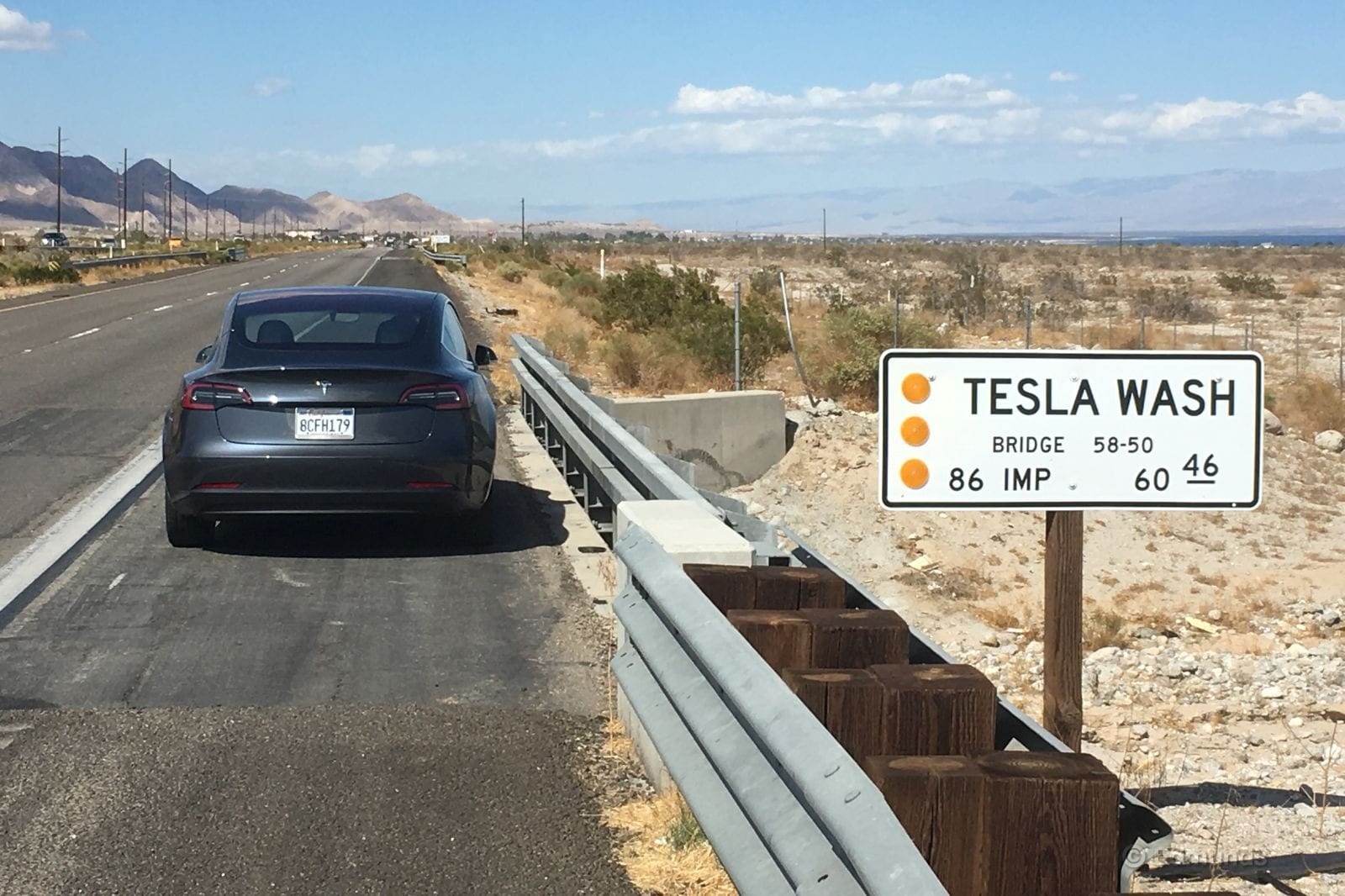
Maintenance and Upkeep
February was also the first month our Model 3 visited the dealer for the repairs described last month. We received a call from the Tesla service center that our parts had arrived and drove over to drop off the car. When we arrived, however, we were told that only some of the parts had arrived.
Slightly annoyed, we wheeled the Model 3 out of the Tesla service center and headed back to the office. Within five minutes, the Model 3's touchscreen blacked out again. By our current count, the screen has crashed 15 times, and a few of these occurred after the latest over-the-air update (version 2018.4).
In the following days, we received three calls from the Tesla service center saying our parts had arrived. But these calls seemed to originate from the parts department, so we wised up and asked to be connected to the service writer. The service writer, in turn, told us to hold off bringing the car in until we received a call from him confirming that all the parts were in.
tl;dr — maybe Tesla's service center will be ready for us in March.
Also, you might notice that some of the photos of our Model 3 show it rolling on 19-inch wheels instead of its original 18-inchers. In February we swapped out the wheels and tires to quantify the impact on performance and range and to see the effect, if any, on the ride quality. We'll post a stand-alone piece on the results of that test in the coming weeks.

Logbook Highlights
Comfort
"I love adaptive cruise control. The ability to consistently maintain the distance to the car in front is such a blessing. When there's a slight uphill and the vehicle in front crests the hill, however, the Model 3's adaptive cruise thinks that there's no vehicle present and speeds up! It made for a close call for me. Luckily, I was able to jump on the brakes fast enough to avoid hitting the rear of the vehicle in front. Yikes. A good reminder that no technology is perfect; you still have a responsibility to control your vehicle." — Rex Tokeshi-Torres, vehicle testing technician
Performance
"The Model 3 definitely steers and handles better than, well, any other EV, frankly. Feels more satisfying to drive than a Bolt, Leaf, etc. The ride's a bit too busy, however, in a way that makes me think they need to make another pass at the damping. It's not harsh, but it's not spot-on, either. Still, thumbs-up for making an EV that doesn't mind a fun road." — Jason Kavanagh, senior road test engineer
Interior
"Not loving the one-screen-to-do-everything approach. It inherently requires much 'glance time' to use. Try operating the Model 3's wipers, cruise, headlights, climate control, etc., without looking at the controls. Now do the same thing in any other car. Guess which one requires less (or zero) time spent with your eyes averted from the road. Hard controls exist for a reason, people." — Jason Kavanagh
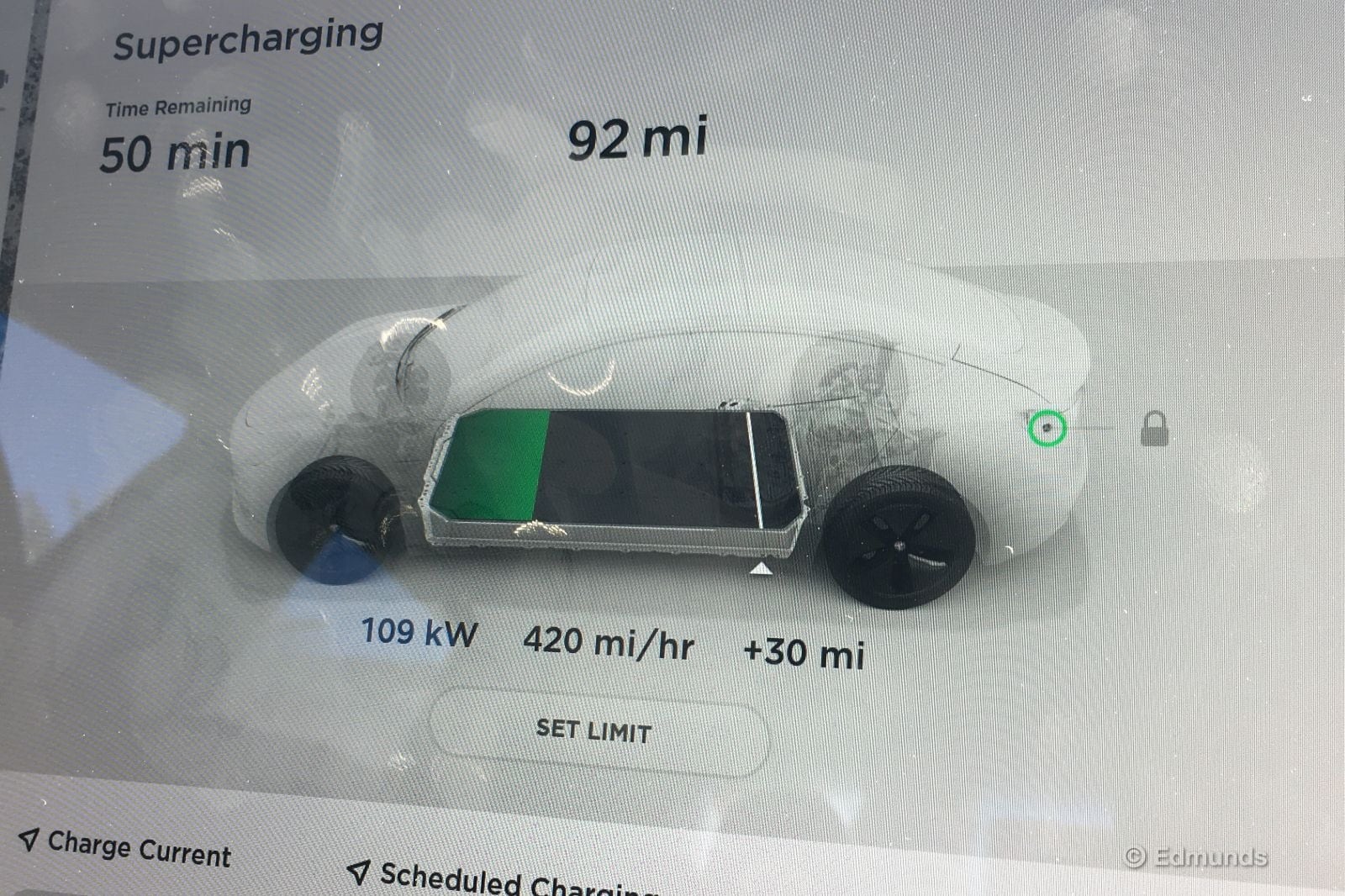
Miscellaneous
"The Model 3 charges really fast at Superchargers. Its 420 'miles per hour' peak rate is way quicker than the Model S or X rate. Why? It's a more efficient vehicle for a given unit of electricity, so the recharging rate will appear faster from a miles perspective even if it isn't any faster from a kWh perspective. The charging rate peters out as the battery fills, naturally, but I feel confident in saying that no Model S (you can forget about the X entirely) can beat a Model 3 in an L.A.-to-NYC cross-country race. I bet each stop would be 5-10 minutes quicker in the Model 3. Multiply this by a dozen stops and you'd win by an hour or two." — Dan Edmunds, director of vehicle testing
"Supercharger-ing costs money, but in California, it's only 20 cents per kWh — a good bit less than I would pay at home. The rates are not uniform across the country, so lower rates will probably be found in states with cheaper electricity. But I've charged at four different locations in SoCal, and it's 20 cents everywhere I've checked. The cool part is that we can log in to our Tesla account to get a receipt, and that receipt includes data that lets us measure Supercharger consumption and charging losses. Never had that with our S or X." — Dan Edmunds

Monthly Update for March 2018
Where Did We Drive It?
It was a busy month of learning with our 2017 Tesla Model 3, which meant it was also a busy month for Vehicle Testing Technician Rex Tokeshi-Torres, who was its primary chaperone. Between vehicle repairs, software updates and learning what it takes to simply remove a wheel (news flash: it isn't simple), it's been an exciting few months so far.
Miles logged in March were mostly local, though we still managed to cover a decent amount of ground for an EV. Our Model 3 comparison test video is about to go live in just a couple weeks, so be sure to keep an eye on the YouTubes for it. Even better, subscribe to the Edmunds YouTube Channel and get notified the moment it's posted.
What Kind of Fuel Economy Did It Get?
In March, our Model 3 covered 1,015 miles over nine charges, seven done at Edmunds' high-power wall charger and the other two at standard 240-volt stations. Our month's energy consumption stats follow:
Current odometer: 3,937 miles
Average lifetime consumption: 31.7 kWh/100 miles (106.4 miles per gallon equivalent)
EPA consumption rating: 27 kWh/100 combined (126 mpge)
Best fill: 25.6 kWh/100 (131.5 mpge)
Our average kilowatt-hours used per 100 miles increased from the previous month's 30.9 kWh/100 miles, meaning we're driving less efficiently. This is 17.4 percent higher than the EPA's estimated consumption, which is atypical of EVs (other than Teslas) we've previously tested.
Maintenance and Upkeep
When we took delivery of our Model 3, there were a few items broken or damaged at the outset. This month we had several of them fixed or replaced at no cost. The repairs included a cracked driver vanity mirror (goodwill), broken trim on the driver seat bottom (warranty), a broken front passenger seat adjuster (warranty), driver-side door trim by the speaker (warranty), and front passenger-side door trim (warranty).
The service center also replaced our front stabilizer bar links due to a service bulletin warning of the possibility of the ball joint studs cracking.
Logbook Highlights

Technology-Audio
"Just updated the software last night. The wiper function has been improved. I like the new setup with four speed settings and an auto mode. The auto mode is also less erratic." — Rex Tokeshi-Torres, vehicle testing technician

"Seems like the unlock door function takes a little while to get going right after a software update. Even though the phone app was on and I had the key card with me, the door would not unlock until after I restarted the phone app. Once I did that, the car audibly fired up (I heard the soft humming of the power unit) and the doors unlocked." — Rex Tokeshi-Torres
"I haven't yet worked up the courage to leave the Model 3 key card at home and rely solely on the 'key' stored in my phone. The walk-up unlock/walk-away lock feature works only on occasion, and usually when you're not intending to go anywhere. Stand near the car and it will sometimes continue to lock and unlock itself until you move out of key proximity. Trusting that the car is going to lock when you walk out of Bluetooth range is another thing. I often just use the key card to lock it manually; that way there's no question. I'm probably better off disabling my phone key at this point since it causes more headaches than it is a convenience." — Jonathan Elfalan, road test manager
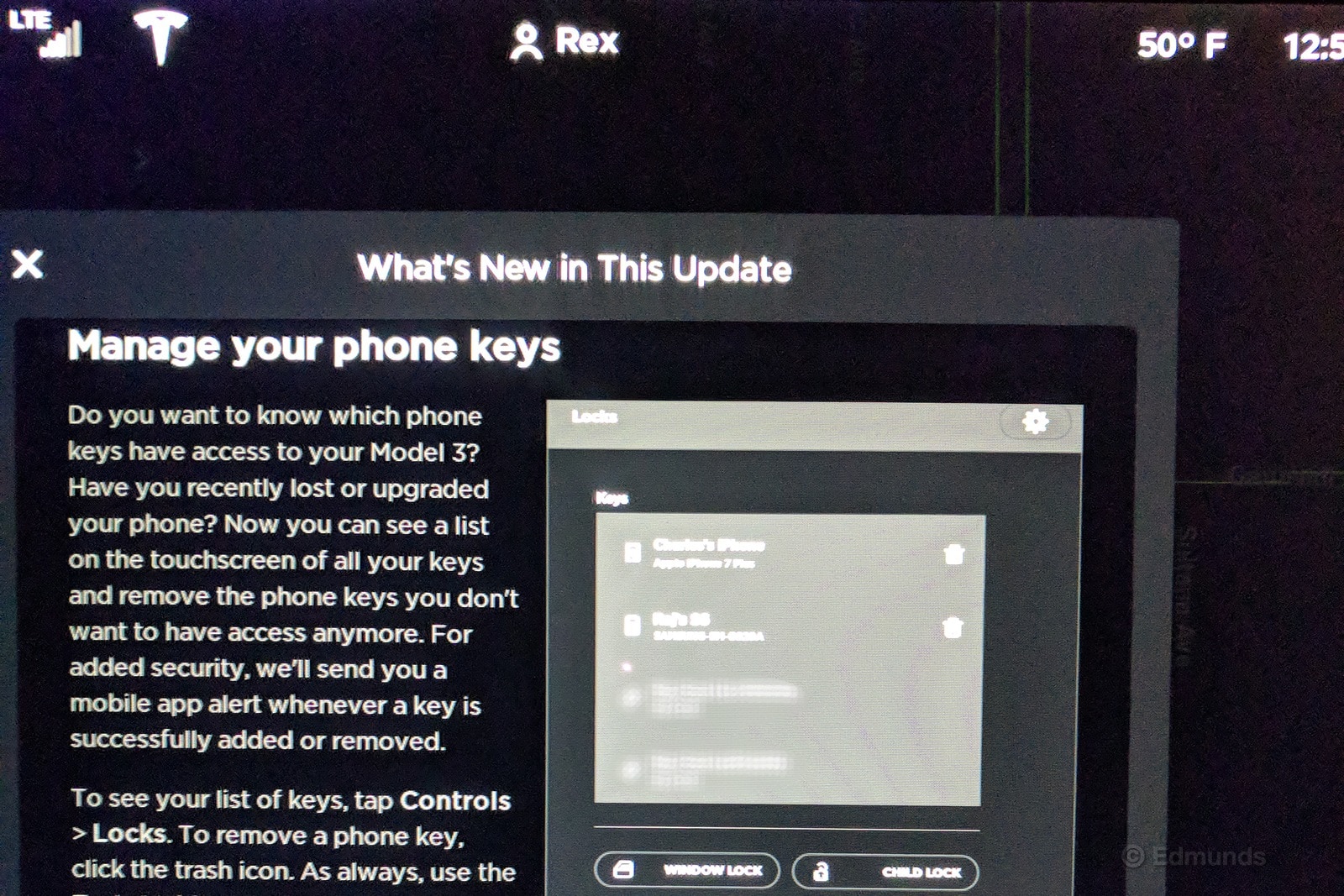
"I really appreciate the Model 3's sound system. I'm no audiophile, but it sounds really clear. It works well with all the music I listen to and doesn't distort." — Rex Tokeshi-Torres
Maintenance
"On today's episode of 'Adventures in Model 3 Land,' we find out what it takes to remove a wheel. It turns out that's not an easy thing to do. We recently received a set of 19-inch factory wheels and summer tires from Tesla in order to do some back-to-back evaluation with our stock 18-inch wheels with all-season tires. Looking underneath the car for the proper spot to place the jack, I found a few holes that looked like jacking points, but they were very small and nearly flush with the body. It didn't appear like any standard jack would fit, so I rummaged through the Model 3's frunk and trunk areas for anything resembling an adapter. Nothing. A quick online search turned this up.
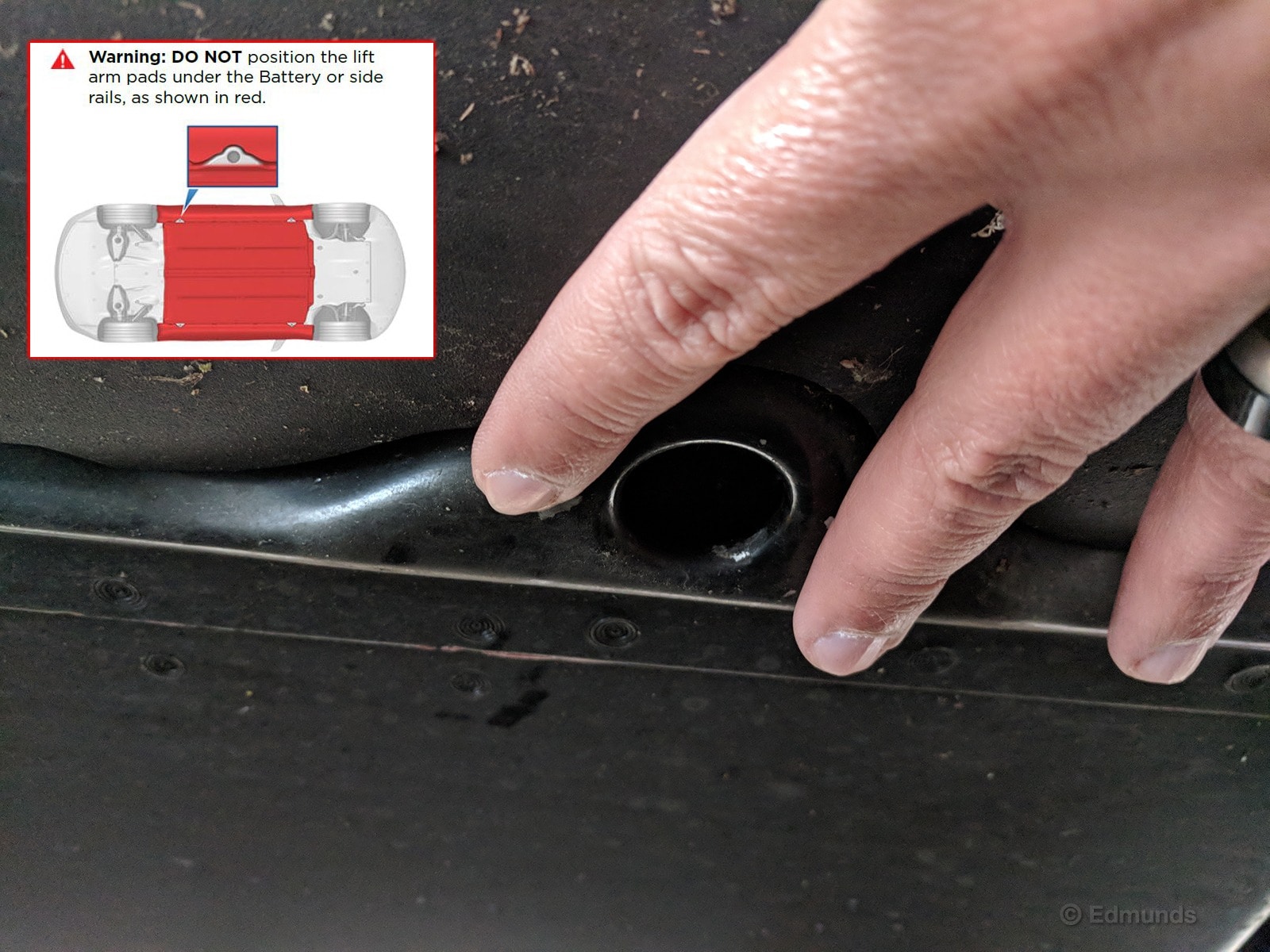
"Like a mine technician trying to clear a field, the tiny jack points are surrounded by a sea of red 'do NOT jack' points. There is no adapter that comes with the car, likely because Tesla would prefer to have any repair or maintenance work, including wheel removals, done at a Tesla service center. There are third-party companies making adapters such as this, which is something even the basic do-it-yourselfer may want to invest in." — Rex Tokeshi-Torres
Miscellaneous
"A 19-inch upgraded performance wheel-and-tire combo only weighs 1 pound more than our stock 18-inch combo. That's pretty cool, and worth it." — Rex Tokeshi-Torres
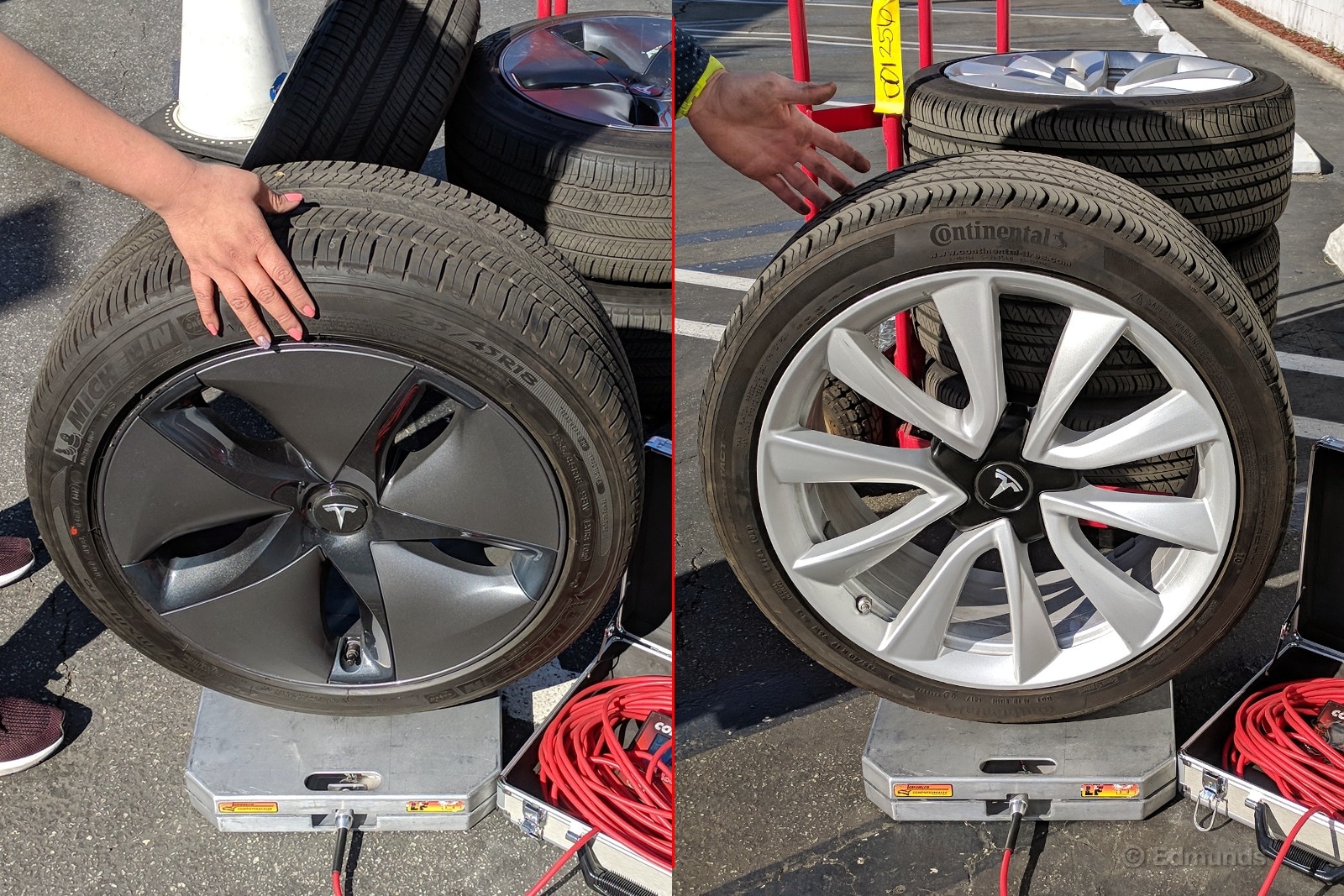
Performance
"I'm with others on the subpar performance of Enhanced Autopilot. This weekend I experienced a couple fails. One was the system failing to recognize that it changed lanes around a slight bend in the highway. It kept wanting to travel over another lane. The second was not recognizing a car in the adjacent lane, and it nearly pulled a [jerk] maneuver on my behalf when I asked it for a lane change in autosteer mode. The moral here is you can't yet trust this system to do all the thinking for you because you never know what it's going to do, or not do, next." — Jonathan Elfalan
Cargo Space
"Had to pick up a couple sets of king-size bed slats. At the purchase counter I hesitated a bit after I saw how long the boxes were since I wasn't sure they'd fit in the Model 3. Turns out they fit with zero issue, and might've even accommodated the longer Cal-King-length slats. That's pretty awesome." — Jonathan Elfalan
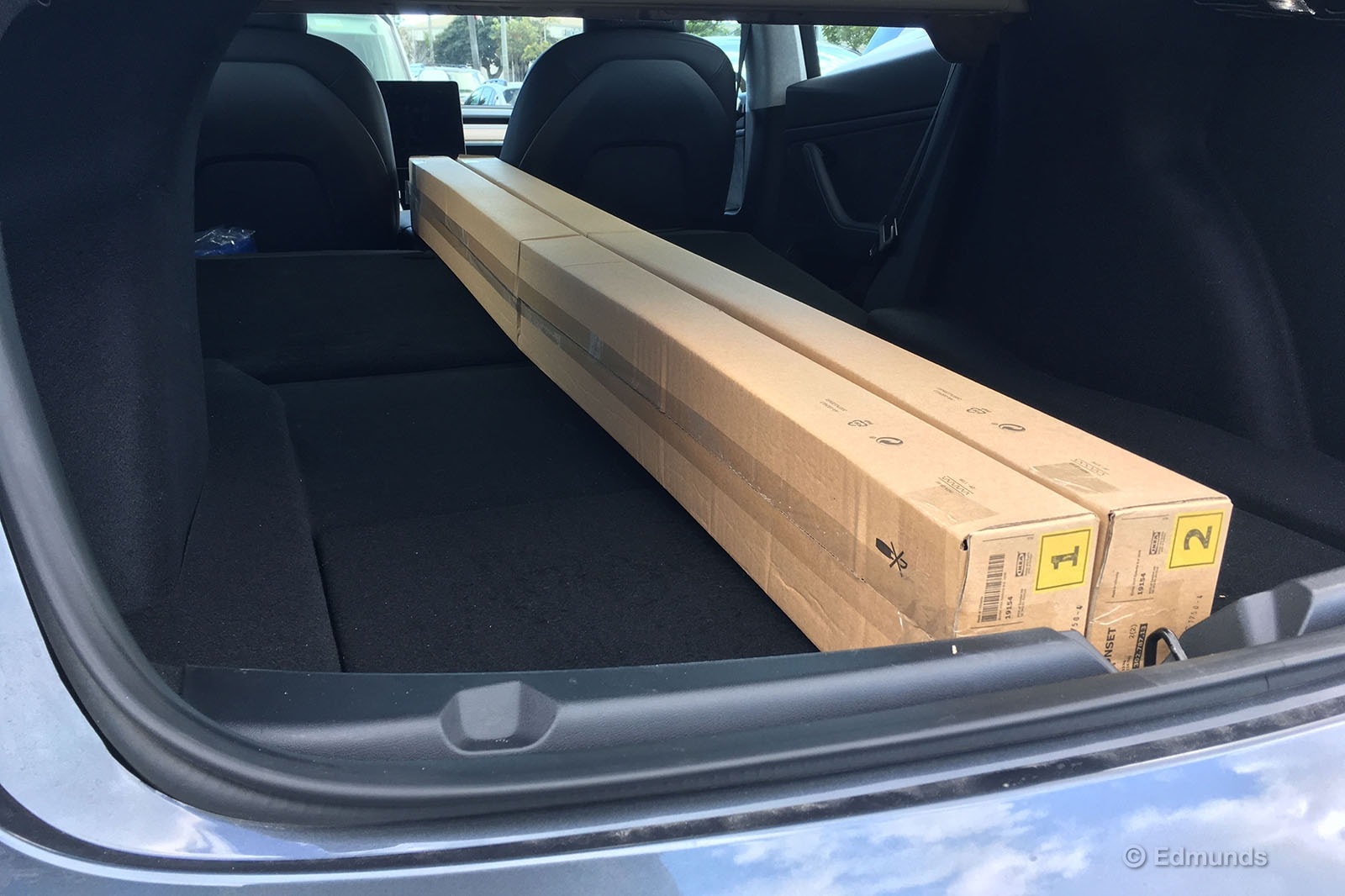
Monthly Update for April 2018
Where Did We Drive It?
Where we drove our long-term 2017 Tesla Model 3 in April is a bit less relevant than what happened while we were driving it. We did local commuting and a few freeway journeys, sure, but everywhere we went the car was fraught with problems. Sixteen weeks into ownership, we've had so many issues with our Model 3 that we started a shared Google Doc to catalog various warning messages, necessary screen resets and general failures.
Forget that this is a "cutting-edge" EV with a cult following. That's irrelevant if Tesla wants to be anything more than a footnote in automotive history. Our Model 3 cost us $56,000, and by that standard alone, the ownership experience so far has been unacceptable. But this is no ordinary $56K car. We put down a $1,000 deposit to get on a two-year waiting list for this car and it's falling apart.
Early adopters who could spend six figures on a car such as the Model S might've given Tesla a bit of extra leeway. Maybe they figure it's a small price to pay for such a technologically advanced car. Maybe it's a sacrifice they're willing to make to avoid using fossil fuels and get free access to the carpool lane. This far into its run, though, and with a car intended for mass appeal, Tesla should have the bugs worked out. It clearly doesn't.
What Kind of Fuel Economy Did It Get?
We put down 1,120 miles in April, up a few miles from last month. That's a bit shorter than our monthly goal of around 1,700 miles so we'll have to plan a few Supercharger-fueled road trips to catch up. We plugged in at the Edmunds high-powered wall charger 12 times in April and used just one Supercharger station. Here's what that looks like in terms of energy consumption:
Current odometer: 5,257 miles
Average lifetime consumption: 31.7 kWh/100 miles (106.3 miles per gallon equivalent)
EPA consumption rating: 27 kWh/100 combined (126 mpge)
Best fill: 25.6 kWh/100 (131.5 mpge)
This is the second month in a row that our average kilowatt-hours used per 100 miles increased, but we're still doing better than the EPA combined estimate (the lower the energy use per 100 miles, the more efficient you've been driving). As a side note, Supercharger energy got more expensive this month. Tesla upped the price from 20 cents per kWh to 26 cents per kWh. That's more than some of our editors pay to charge the Tesla at home, but not outrageous. When you consider the cost of installing a Level 2 charger at home, Superchargers are still a relatively good deal.
Maintenance and Upkeep
Based on many issues we had early in the month, we took the Model 3 in for service. The most annoying of those issues was a repeated, uncontrollable increase in stereo volume, sometimes when we weren't even in the car. Basically, the stereo would suddenly go to full volume without explanation. This and other issues are cataloged from our notes below:
• Would not recognize keycard in or on the console and hence would not go into gear. It did, however, unlock the car. Workaround was to force quit the app and restart the app. Then it would allow the choice of Drive or Reverse.
• The backup camera screen did not appear when reversing.
• Nav screen going haywire: zooming, scrolling, pinching, pixelating all at once.
• Audio system turning on by itself at full volume.
• Audio display randomly moving up and down the screen without any command from a human.
• Audio system came on and went to full volume all by itself while the car was off, locked and unoccupied. I heard it from 100 yards away. "Who is that joker playing his stereo so loud I can hear it from here?" Oh, it's Elon. I turned it down, but it kept wavering up and down as I started driving, working against my repeated attempts to dial it down. Then it blasted all the way to maximum. My ears are still ringing two hours later. Fixed after reboot. Not sure about hearing damage.
• Audio page leaping up and down rapidly like the up-caret button to expand the source menu was being played with by a kid who ate too much candy. Concurrent with the volume problem above. Same reboot.
• Icons on the map screen flickering.
• The passenger vanity mirror fell off completely. Installed and held on only by double-sided tape. Reinstalled by pressing really hard on the mirror.
• The screen went completely dark on startup, no music or operation. Restarted the car. The screen worked; the backup camera did not.
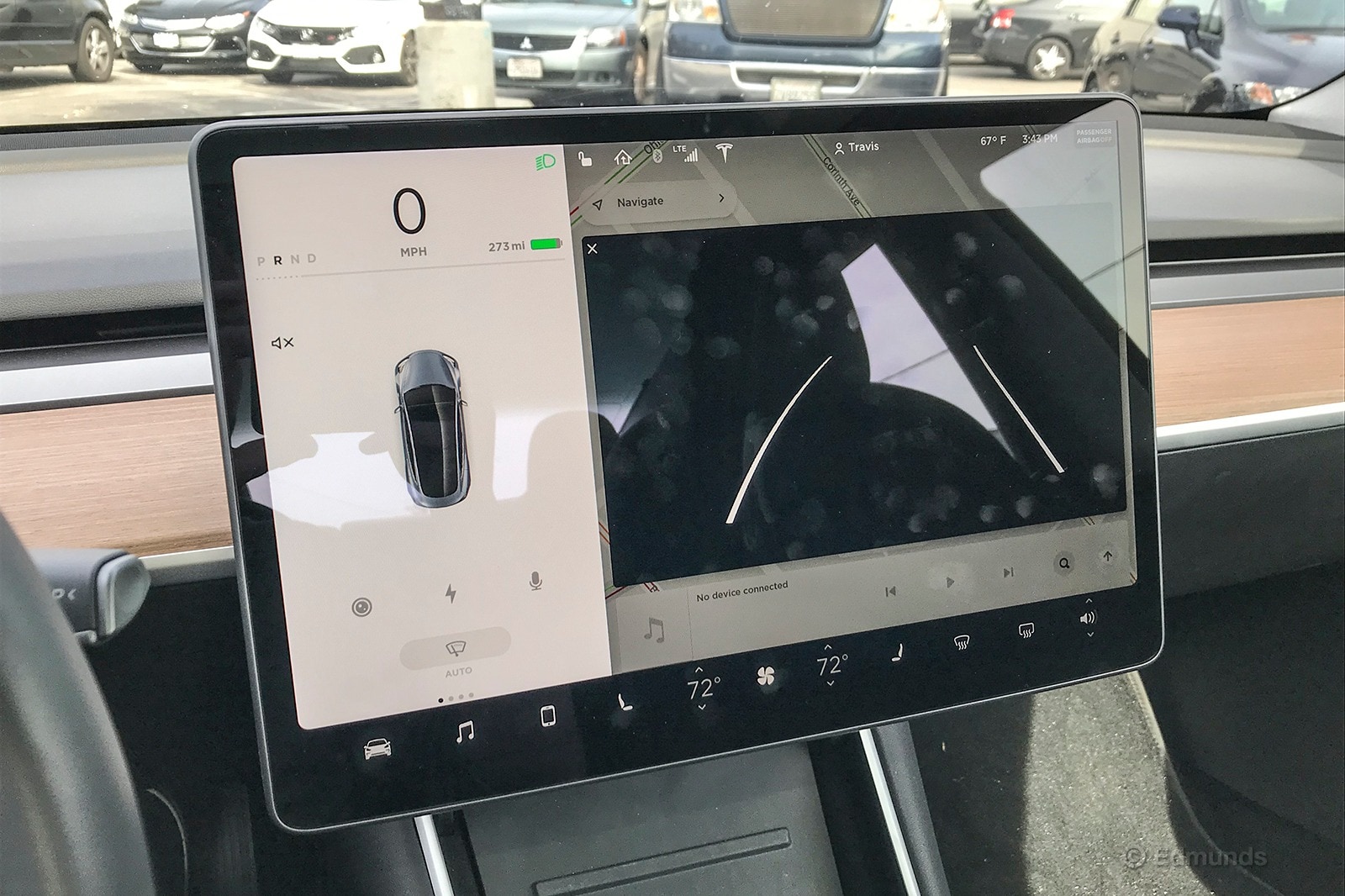
After diagnosing the car's problems, we took the Model 3 to the service center mid-April. The service center replaced our center screen, updated our firmware, and sent us on our way. That trip to the service center also included a software update, which was meant to address some very specific problems we were having with the Autopilot system. For more on that update, check out this video. The entire process at the service center only took about three hours, so we waited and drove the car home the same day. The service was free and we haven't had the volume issue again, but there were several warnings in the following two weeks:
• The car will not shift into Drive or Reverse upon startup. "Vehicle Systems Are Powering Up. Shift Into D or R After Message Clears." Have to wait for it to power up. A loud click comes from the rear of the car as if a drive shaft is engaging and the message on the screen goes away.
• The car displays a new message: "Cannot Maintain Vehicle Power. Car May Stop Driving or Shut Down." No shutdowns yet, but keeping an eye out.
• With 170 miles of range, the car displays a "Regenerative Braking Limited" message. Plenty of available space to store regen power. Logged the issue, then reset the screen with a reboot. The message has not displayed since.
• While the car was parked, the passenger sun visor was left down and the mirror fell out. Pressed back into place. Hoping it won't fall out again.

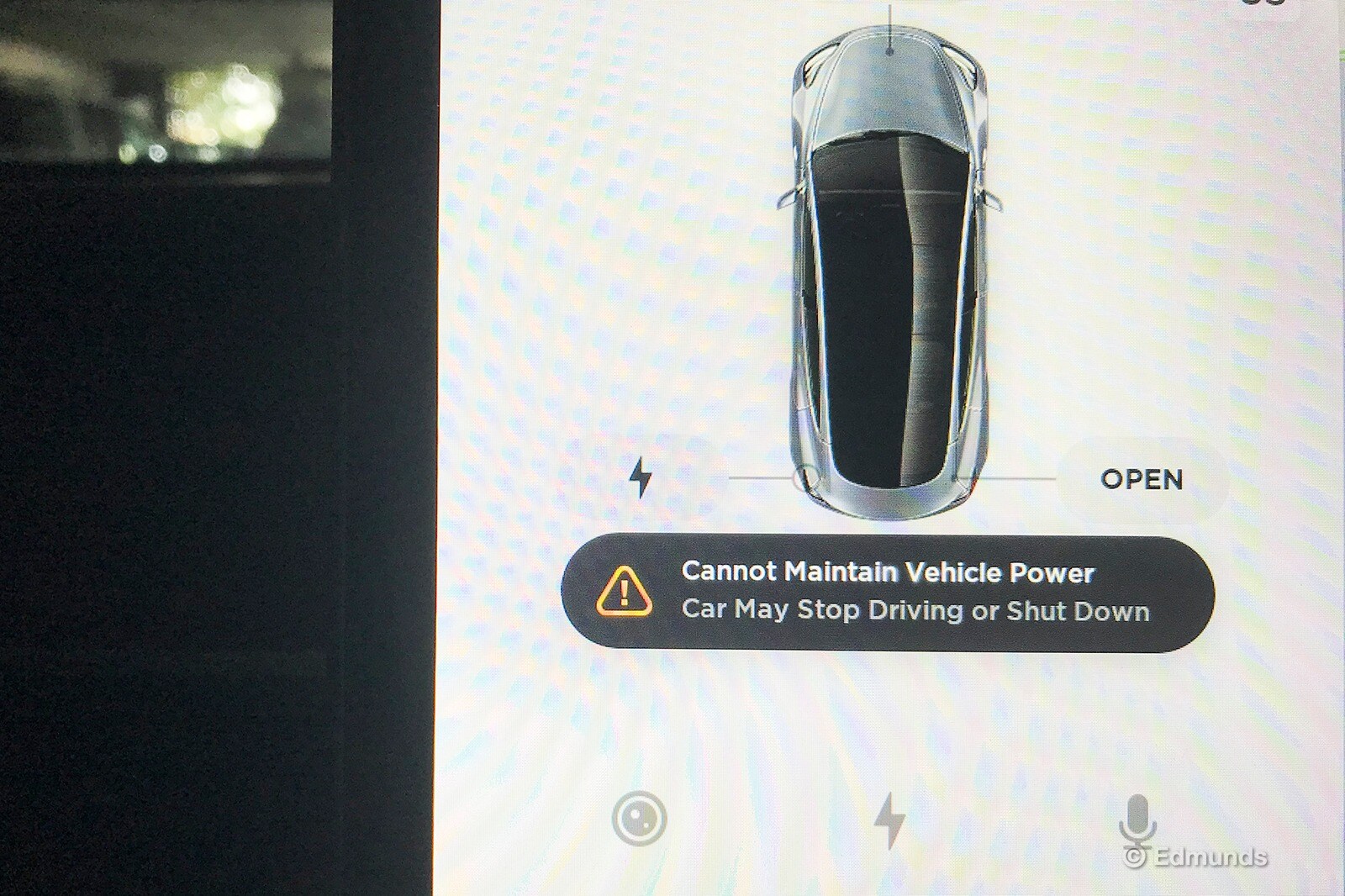
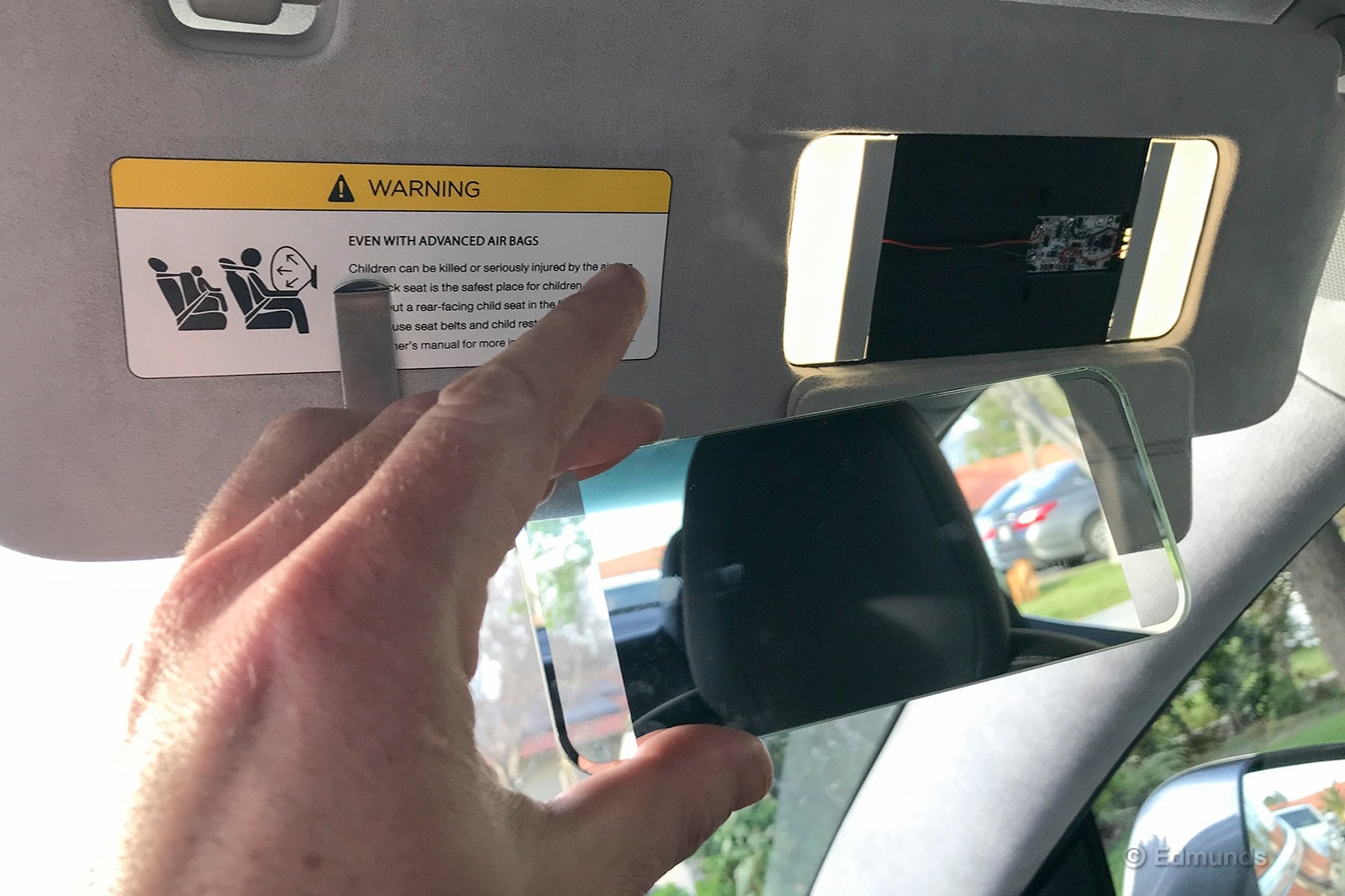
Just to recap, this has all happened in the past four weeks, less than four full months into our yearlong test. We've already scheduled a third service visit for next month, and our collective patience with this car is wearing thin.
Days out of service: 0
Logbook Highlights
Cargo Space
"I was recently transporting a large record collection, along with a few boxes of CDs, and the Model 3 was the car I had for the job. I was impressed by the Model 3's storage ability relative to its size, with the space to fit four massive storage containers and several cases of CDs with space to spare. The weight on top of the rear seats, however, set off the seat sensor, telling me there was something in the back seat. It did this, on a constantly displaying basis, for over 100 miles. Seems to me like there should be some sort of secondary sensor that knows the seat is folded down before it warns me that the plastic totes aren't wearing their seat belts." — Travis Langness, staff writer
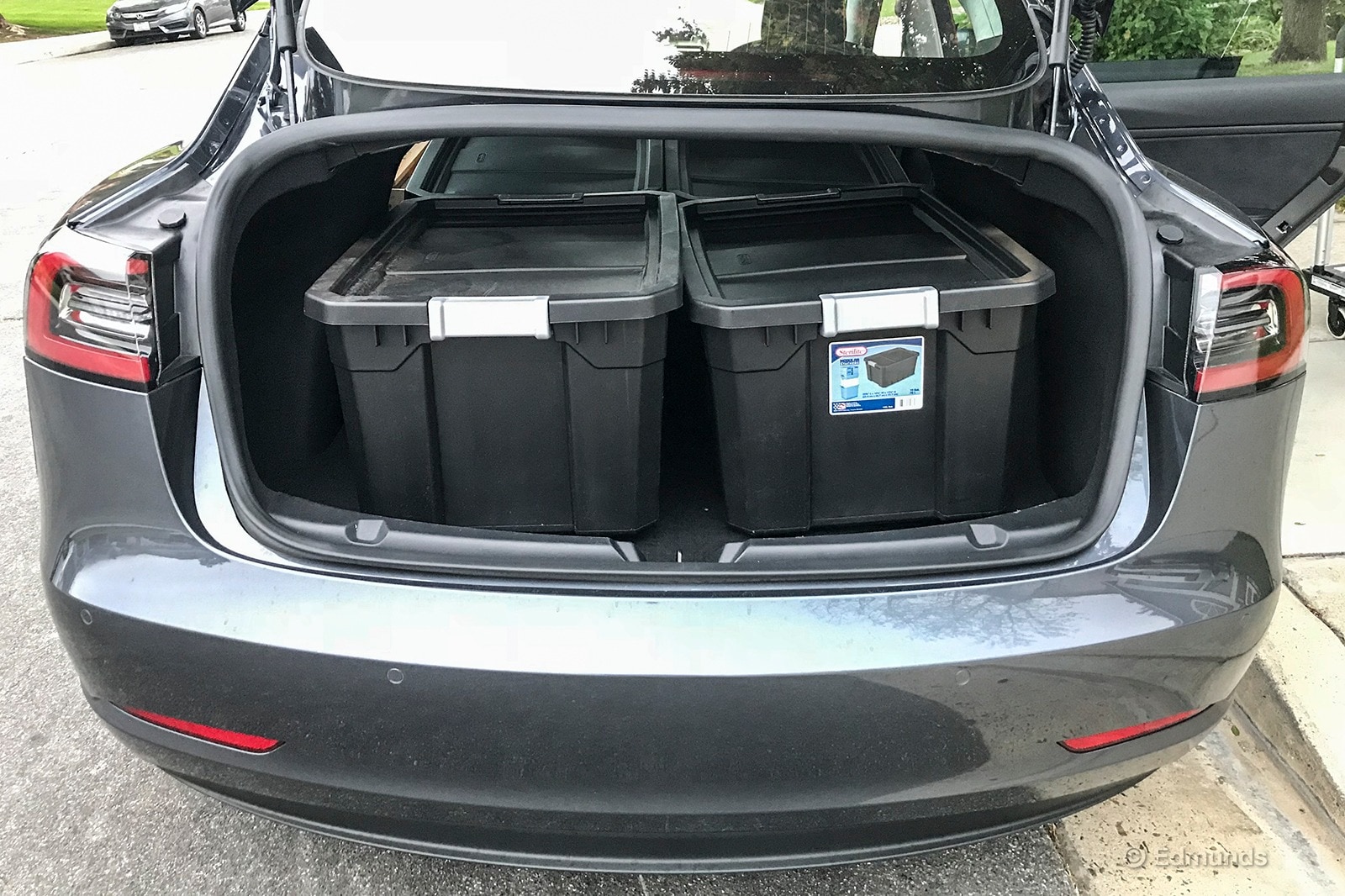


Technology-Audio
"Technology is supposed to make things easier, right? Right? That is so NOT the case with the Tesla Model 3. Simple things are hard to figure out at first glance. I've complained about this issue in our Model X before. I want to change the radio station. On the screen all I get are icons of the preset radio stations, some of them have the actual radio station dial numbers and others are just tiny thumbnails of bands (?). The station I'm currently listening to isn't even anywhere obvious on the display.
"Cut to me trying to get out of the car from the passenger side while parked in a dim garage. Where is the handle/button/lever to open the door? 'It's that dim LED light there,' said editor Jay Kavanagh from the driver's seat after having watched me feel blindly around on the passenger door. Ugh, why is everything so hard? I just wonder what it's like for those who actually own this car. It must get easier. It has to." —Caroline Pardilla, senior copy editor
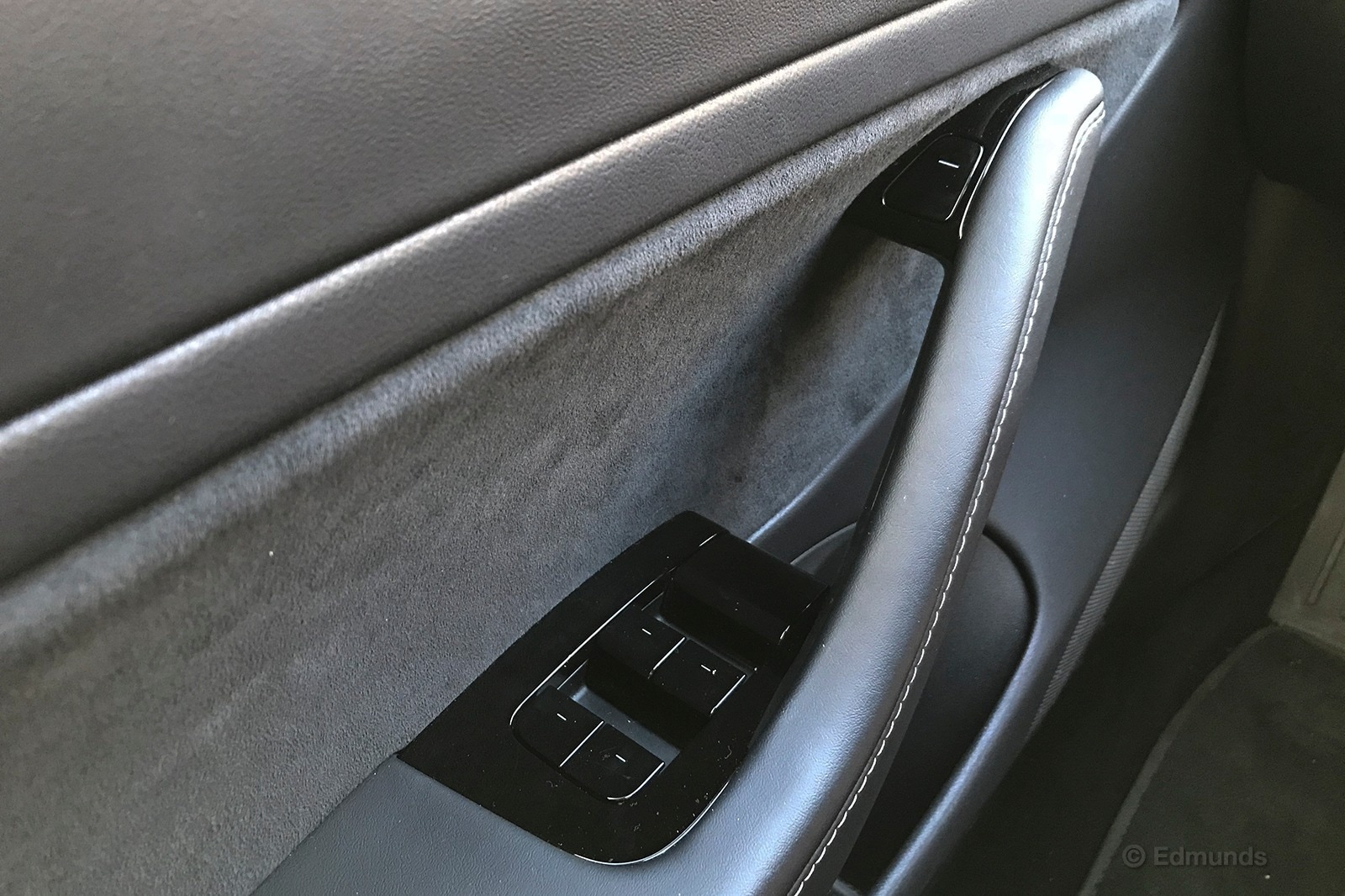
"Weird glitch with the new screen on our Model 3. I was greeted with a blank screen in the morning. The car was on, but the screen was black. I put it in Drive and intended on going to work with the faulty screen. For kicks, I figured I'd give my Bluetooth audio a try, so I'd have something to listen to. This seemed to jumpstart the screen back to life. It functioned as intended for the rest of the weekend." — Ron Montoya, senior consumer advice editor
Comfort
"Backseat comfort review from the two adult passengers riding in the Tesla Model 3: They said the car rode extremely rough over imperfections in the road and it was not comfortable at all. It quickly burst their 'Oh, look at this cool Tesla!' bubble." — Ron Montoya
Performance
"This car is a joy to drive on Angeles Crest Highway, and I don't say that lightly. Angeles Crest is a famously demanding road that winds up into the San Gabriel Mountains north of Los Angeles. You need brakes, power and a taut, balanced chassis to do it right. The Model 3 has it all. Body roll is minimal, the brakes don't complain, the steering is gratifyingly precise, and there are gobs of instant torque on tap. Plus, the regenerative braking function means you use the actual brake pedal less often.
"It's a new kind of fun to lift off the throttle ahead of a corner and realize you've already scrubbed enough speed without even touching the pedal. After my drive, a friend of mine asked me how the Model 3 compares to the current BMW 3 Series, and I told him I'd rather have the Tesla. He laughed. I wasn't kidding." — Josh Sadlier, senior manager content strategy
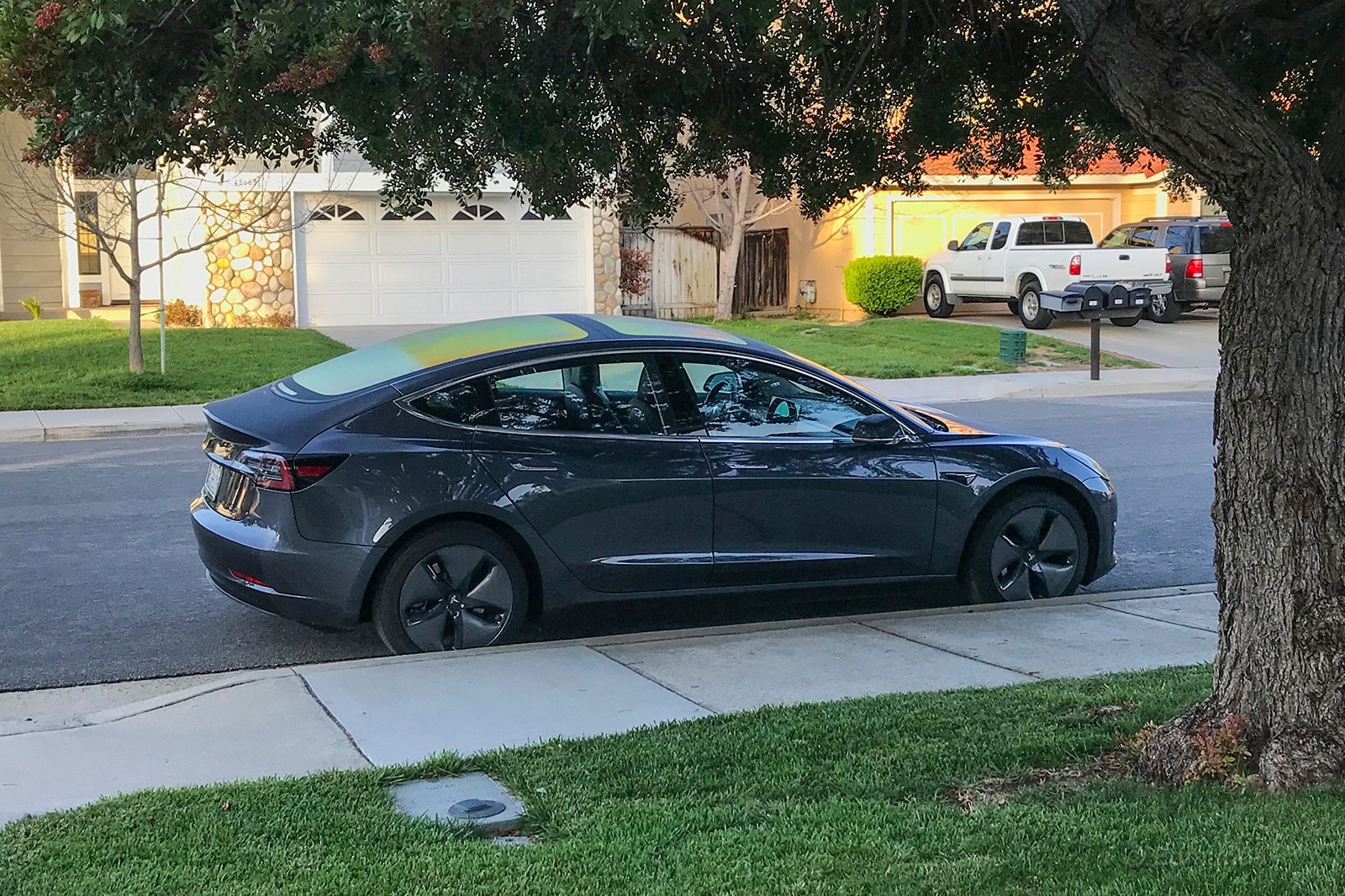
Interior
"No matter how much time I spend in the Model 3, I am still not used to form-over-function door handles and interior door buttons. Every new passenger is confused about how to get into and out of the car. Even me, the driver, I have a hard time remembering how to get in from time to time. And even when I do remember, pushing in and then pulling out the door handles adds an extra step that I don't need. Why reinvent the wheel, Tesla? Make some normal door handles, Elon. Your customers will thank you." — Travis Langness
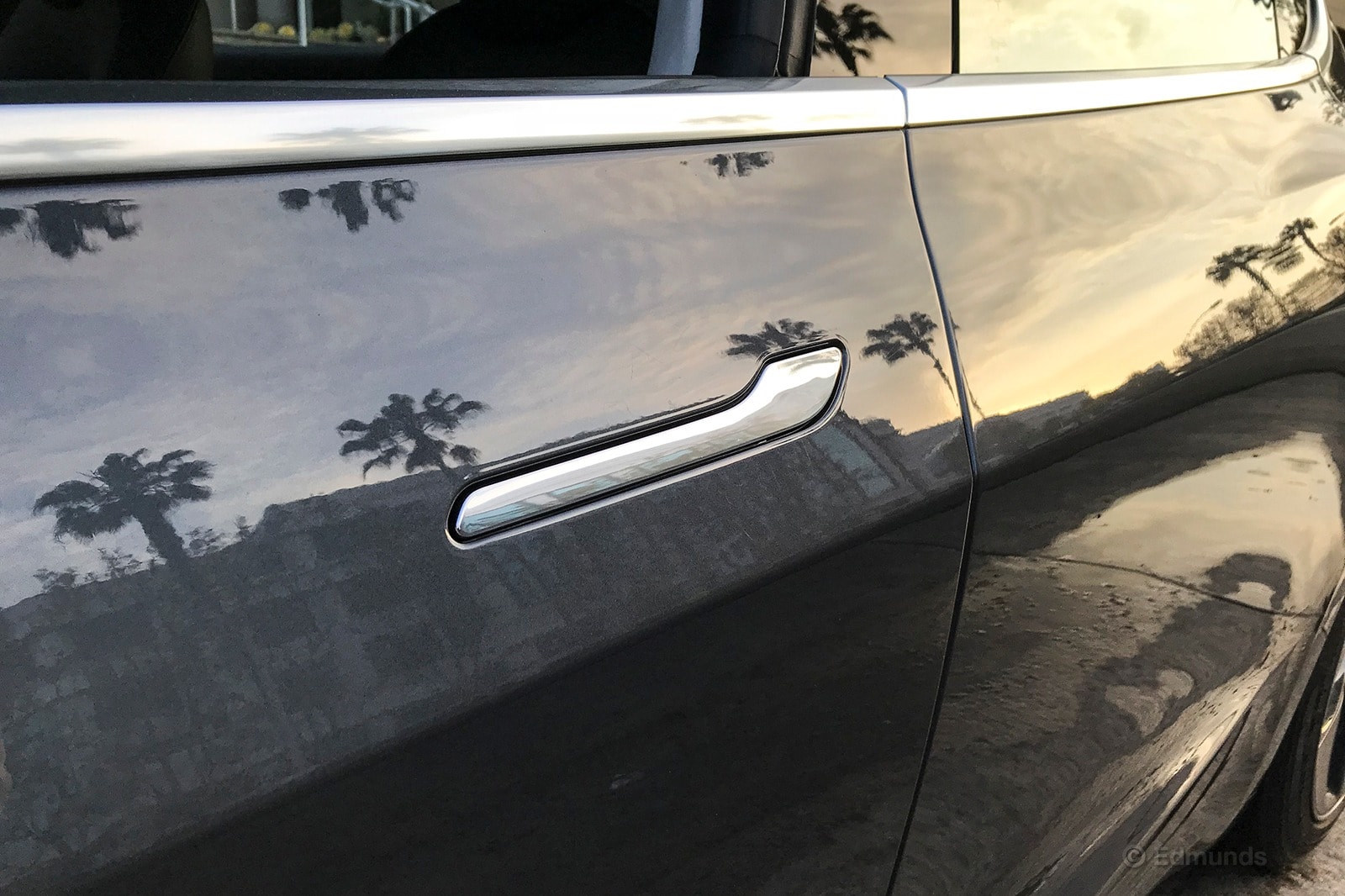
Stopping Distance and Grip With 18- and 19-inch Tires
You've probably heard the recent news that Consumer Reports tested its Tesla Model 3 and proclaimed it severely lacking in the brake department. This was based in large part on a 152-foot result it reported after conducting a series of 60-0 mph panic stops. We don't know the ins and outs of CR's test procedure or the condition and texture of the asphalt at its test facility in Connecticut. What we do know is that, like us, Consumer Reports privately bought its test car; it's no press loaner. Its car also has the standard 18-inch wheels and tires that we bought.
CR's ghastly result was a big surprise to us. We recorded a fairly normal 60-0 mph panic-stop distance of 133 feet when we tested our 2017 Tesla Model 3 on our own test track. While our result is perhaps a few feet longer than we typically see on mass-market cars with all-season tires, it's fairly typical of hybrids and electric vehicles fitted with low-rolling-resistance tires designed for maximum range and efficiency. Mildly disappointing, but not headline-worthy.
Our testing program does not stop at braking, if you'll pardon the pun. Our Tesla Model 3 accelerated to 60 mph in 5.3 seconds, and it produced a respectable 0.85g of grip when orbiting our skidpad. We also feel out a car's handling by lapping it around our test track, and here the Model 3's front end displayed mediocre grip when entering corners, followed by subtle yet persistent traction control interventions on the way out.
This wasn't viewed as a huge liability, though, because a) it's natural to push a car harder on a closed track and b) no one — myself included — thought ill of the Model 3's brakes or handling after driving it on their favorite mountain road.
Still, the full-ABS stopping distance and the iffy track grip made us wonder about the optional 19-inch tires. Should we have bought them? Are they worth the $1,500 price tag? To find out, we borrowed a set and headed back to the track to repeat our tests.
The standard 18-inch bits fitted to our car (and CR's) are 235/45R18 Michelin Primacy MXM4 tires mounted on aluminum alloys covered by aerodynamic snap-on plastic wheel covers. The optional 19-inch setup consists of uncovered aluminum alloys wrapped with Continental ProContact RX tires in size 235/40R19.
You'll notice that both have the same tread width of 235 mm, so the 19-inch tires are no wider. Also, both are all-season tires, so there's no difference there. But there was still reason to proceed since the 18-inch Michelins have a treadwear rating of 500, which suggests a harder tread than the 19-inch Contis and their 400-rated tread. In addition, Tesla recommends 45 psi for the 18-inch Michelins but 42 psi for the 19-inch Contis.
This is odd. The 18-inch tires have a higher load rating in keeping with their taller sidewall and larger air volume, so they shouldn't need extra air to support the car. Tesla's higher air pressure specification seems expressly intended to reduce the footprint of the tire to improve rolling resistance and maximize EPA-rated range and consumption.
These facts made it seem likely that the 19-inch tires would outperform the standard 18-inch tires, but testing was the only way we could confirm this theory and see if the measured difference — if any — was worth it.
The difference was bigger and broader than expected. The 19-inch Continental tires made our Model 3 launch more smartly to produce a better 0-60 mph acceleration time (5.1 seconds instead of 5.3), stop shorter from 60 mph (128 feet instead of 133), and generate a lot more grip around the skidpad (0.93g instead of 0.85g).
Beyond the numbers, this simple tire change absolutely woke up the Model 3 on the handling circuit, where all of the above objective data points came together to produce a more engaging driving experience. It turned into bends more precisely, hung on through corners more tenaciously, and allowed the driver to roll onto the throttle with more authority on the way out.
In short, the 19s made our 2017 Tesla Model 3 a lot more fun, and by a considerable margin. But this was more than a performance and fun-to-drive upgrade. A shorter panic stop can reduce the likelihood or severity of a rear-end collision. Sharper track handling reflexes also translate into better accident avoidance on the street. And we also found that ride comfort and road noise — attributes seemingly unrelated to tire grip — improved considerably.
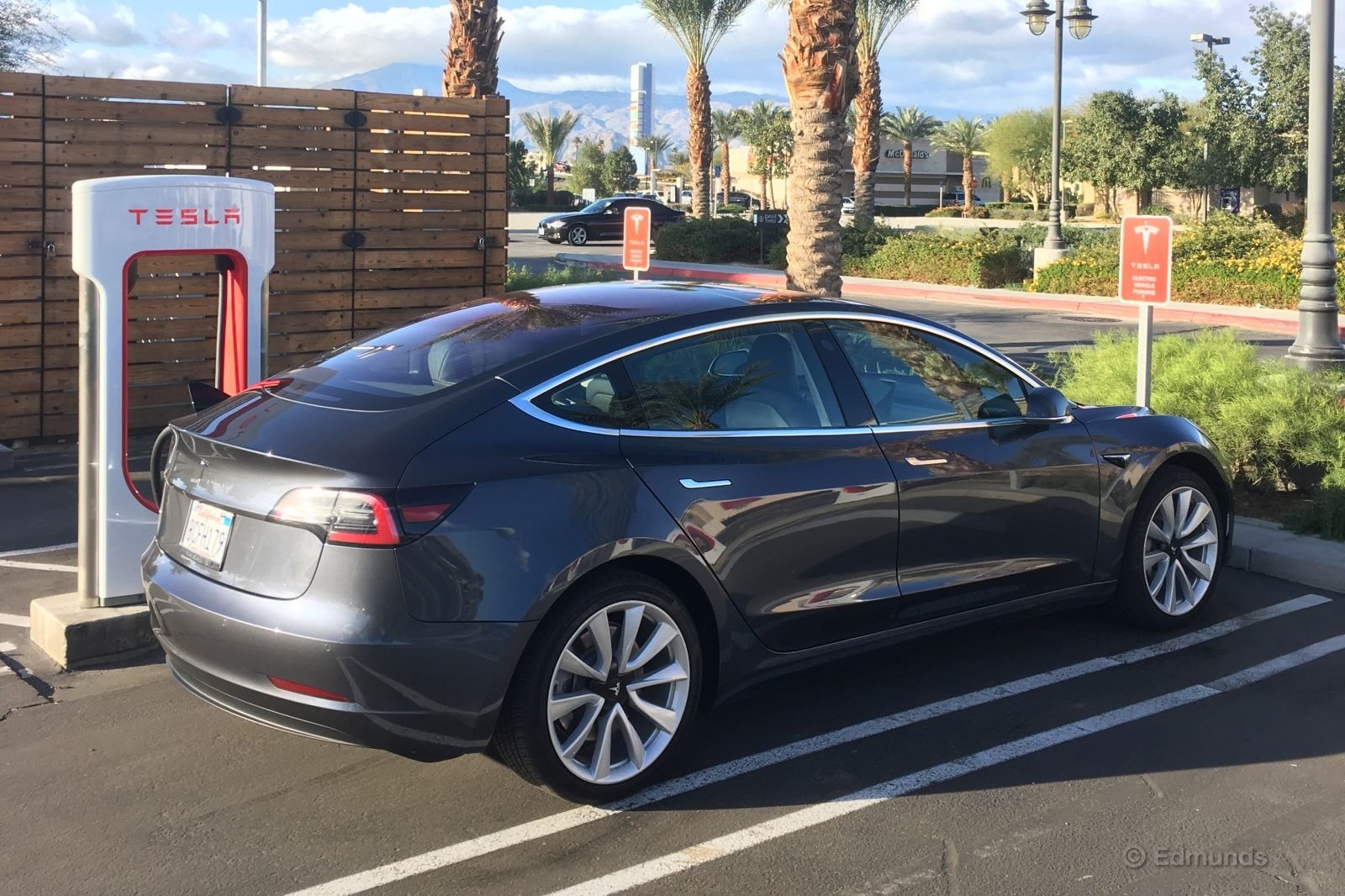
Grippier tires could be expected to worsen consumption and range, but we didn't see any measurable ill effects. The tire break-in period included a 400-mile road trip that seemed as normal as any other we've taken. We can't say for certain that there are no losses on this front, but we can say that the benefits are far more obvious and clearer than any imagined drawbacks.
All of this got me thinking about a career I had before coming to Edmunds. I used to tune the suspension and tire packages of prototype vehicles, and our results lead me to believe that the Model 3's optional 19-inch tire may well have been the reference tire used by Tesla engineers when they tuned the suspension and the ABS and traction control systems.
Not only does the car objectively perform better and stop shorter, it generally feels more agreeable and pleasant to drive in a wider range of conditions. Whether that theory is true or not, I can say the $1,500 for the optional 19-inch Continentals is money well spent.
That said, the Continentals are still all-season tires. Our 19-inch retest suggests the Model 3 chassis has even more to offer. If performance is truly all you care about, and you are willing to sacrifice some range and flirt with the idea of swapping tires in winter (assuming you live where that's even a thing), your best option might be to order your Model 3 with the 18-inch Michelins. And then use the $1,500 you save to offset the cost of aftermarket wheels and stickier tires of your own choosing.
If that's not you, configure your Model 3 with the 19-inch Continentals. I sure wish we had.
Monthly Update for May 2018
Where Did We Drive It?
May was a light month for our 2017 Tesla Model 3 sedan. Our drivers only managed to add 752 miles to its odometer. We charged it just five times.
Part of the reason why that is: Our Model 3 spent four days in the shop getting the issues detailed in last month's update looked at. On three other occasions, it sat idle because no one chose to sign it out — over a three-day weekend, in one case. What's up with that? These added up to 10 days with absolutely zero driving miles.
Of those who did drive it, most were commuters. One staffer who drove it over Memorial Day — a person who was in the last-to-pick slot this month and saved it from another idle weekend — didn't stray too far from home. He did manage to add some 200 miles during his Memorial Day trip to the next county, though.
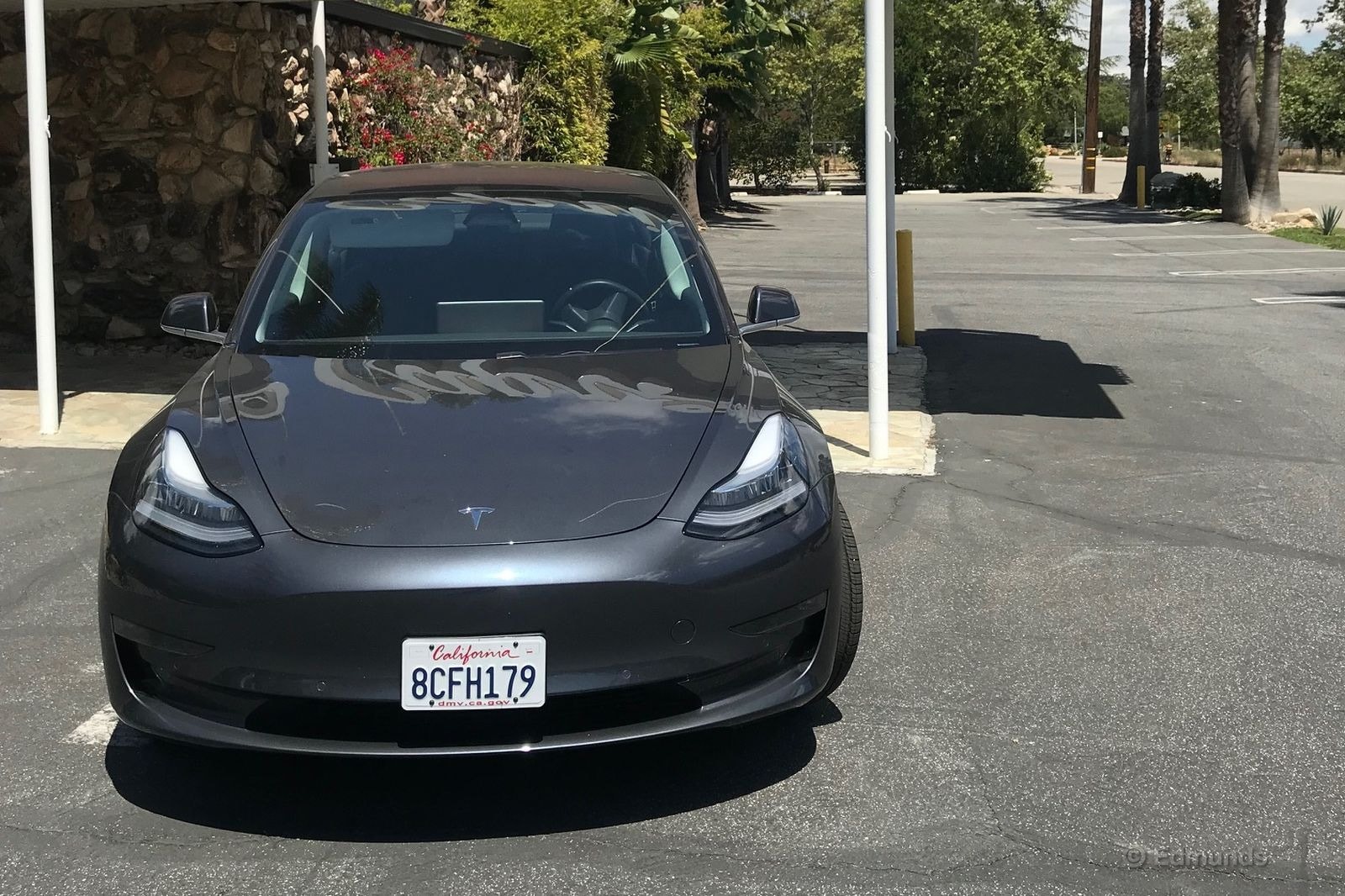
What Kind of 'Fuel Economy' Did It Get?
Our Tesla may not have accumulated many miles this month, but its average consumption came in at 29.5 kilowatt-hours per 100 miles — a tidy figure that makes May its most economical month so far. That figure is still a ways off from the Model 3's EPA rating of 27 kWh/100 miles, but it nevertheless improved the car's lifetime average consumption. May started off at 31.7 kWh/100 miles, but by month's end that average had dropped to 31.4 kWh/100 miles. Not a huge improvement, but we only had 752 miles to work with.
There were other bright sparks in the data, too. The car's Average Energy reading — the figure the car itself reports to indicate the consumption rate between charge events — hit a new low this month. Our previous best stint was 200.8 watt-hours per mile, but early in the month someone brought that down to 195 Wh/mi. That new record only lasted a couple of days before I turned in an even thriftier performance of just 177 Wh/mi over a coincidentally similar distance of 177.1 miles.
By all rights that should have produced a new lowest consumption record after the recharge data was analyzed, but that chance was lost because the charge prior to my stint had been less than a full fill. In cases like that, we have no choice but to add the two charges together and analyze them as a pair, which was unfortunate because the guy before me had been a bit of a leadfoot.
Current odometer: 6,009 miles
Average lifetime recharge electricity consumption: 31.4 kWh/100 miles (107.4 mpge)
EPA consumption rating: 27 kWh/100 combined (126 mpge)
Best single fill, this month: 28.5 kWh/100 (118.2 mpge)
Best single fill, lifetime: 25.6 kWh/100 (131.5 mpge)
Best onboard consumption meter reading: 177 Wh/mi
Average meter reading: 248.3 Wh/mi
Worst reading (aka the leadfoot award): 323 Wh/mi
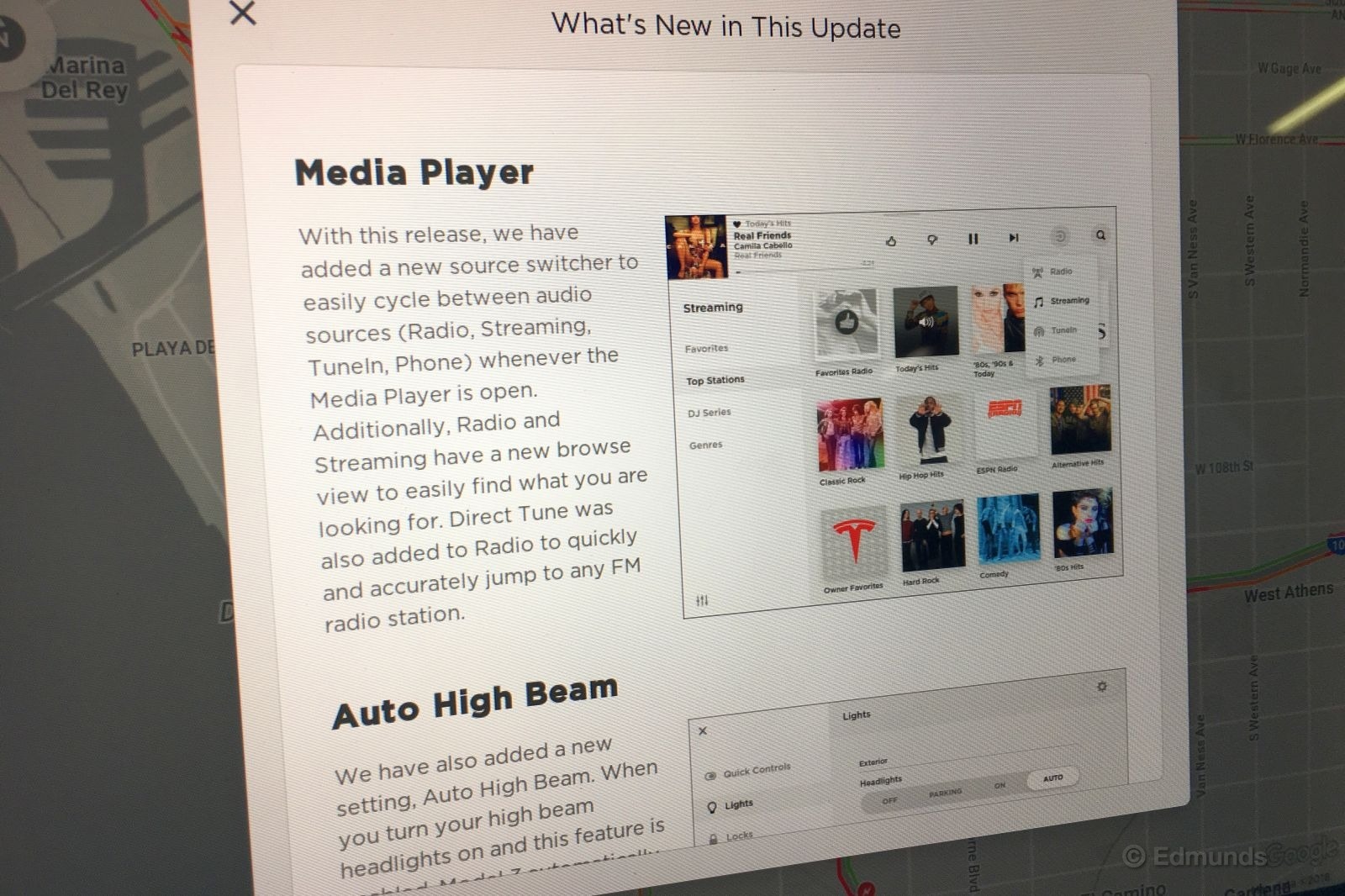
Maintenance and Upkeep
Our car was in the shop over a four-day stretch as they analyzed Travis' issues with odd warnings such as "Vehicle systems are powering up" and "Regenerative braking limited" and, my personal favorite, "Cannot maintain vehicle power. Car may stop driving or shut down."
That last one apparently led to a lot of back and forth between the service center and headquarters, so they may have been diagnosing an unfamiliar issue and testing new solutions. In the end, they uploaded a new set of firmware and gave the car back to us. We haven't seen these messages since.
I was driving the car about a week later, and another firmware update occurred when I had the car parked at the airport. This one came with an explanation in the "release notes" that described changes to the media player, the relocation of the in-car owner's manual within the menu structure, and the addition of an auto high-beam headlight feature. Cool.
But that wasn't it. Yet another firmware update known as Version 2018.18.13 was sent to our car on Friday, May 25, this time with no explanation of its purpose in the release notes. But Elon Musk himself tweeted the next day that the Friday release had been the brake software change the automaker had promised in the wake of the car's poor showing in Consumer Reports testing.
CR had seen stops in the 150-foot range, but our own 60-0 mph panic-stop testing had produced a stop of 133 feet. Our result is clearly less alarming than CR's, but it's still not very confidence-inspiring. We plan to retest in early June to see if we see any benefit.
None of this cost us any money, of course.
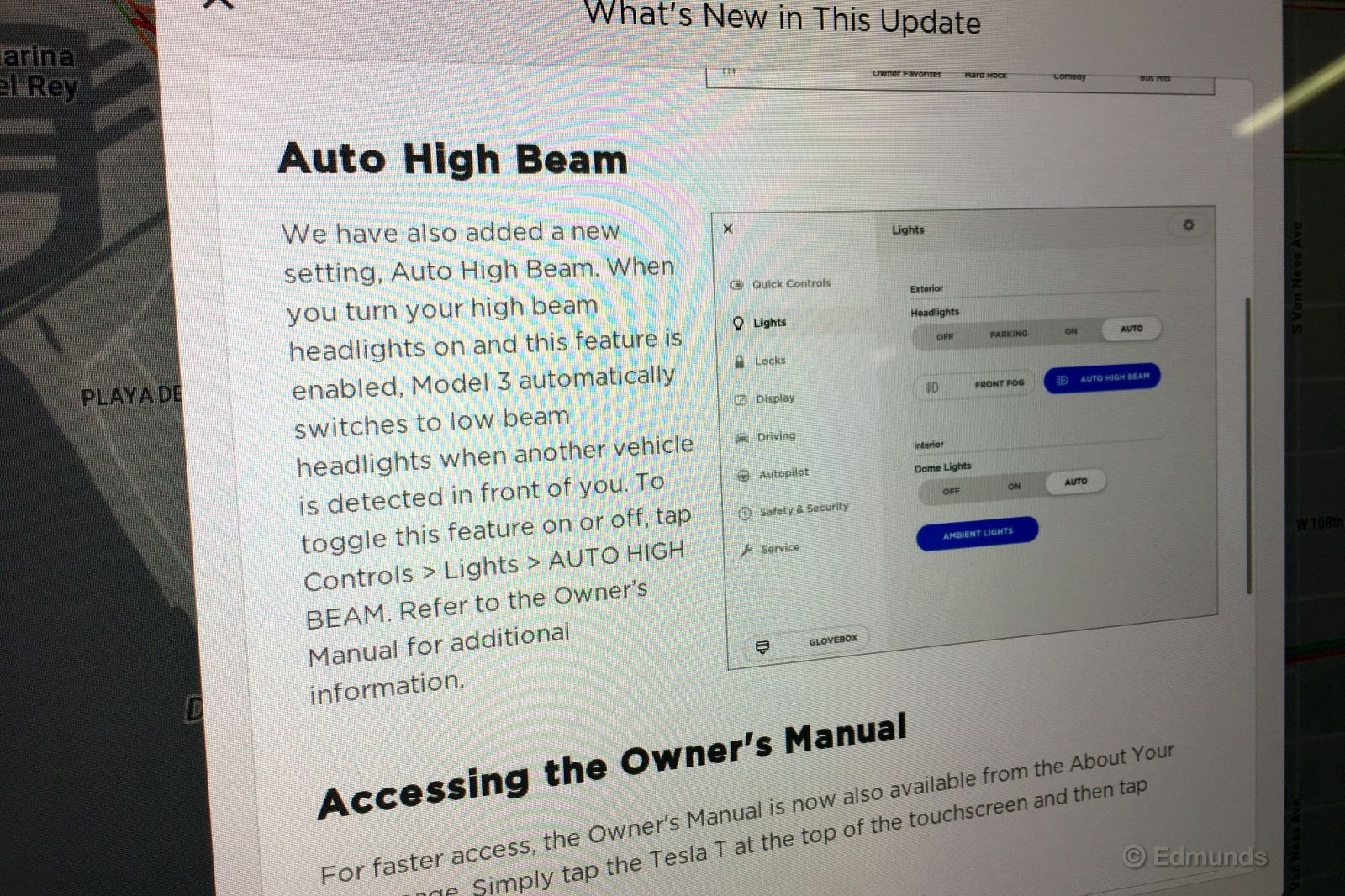
Logbook Highlights
Performance
"It's a shame this car is so intensely infuriating in so many ways because the driving dynamics are excellent. This car's steering and handling are in another galaxy compared to the other two long-term EVs in our fleet (Bolt and Leaf). Of course, our Model 3 (like everyone else's so far) is also in another galaxy, pricewise, too. Will the $36,000 version ever materialize?" — Jason Kavanagh, senior road test engineer
"The Model 3 is a great car to take on a road trip. There's plenty of cargo space in the trunk and frunk. It handles well. Thanks to the instant torque, you can dart through gaps in traffic with ease. And with one-pedal driving (thanks to regenerative braking) as well as adaptive cruise and Autopilot, the Model 3 makes heavy traffic tolerable and relaxing." — Rich Kuras, content strategist
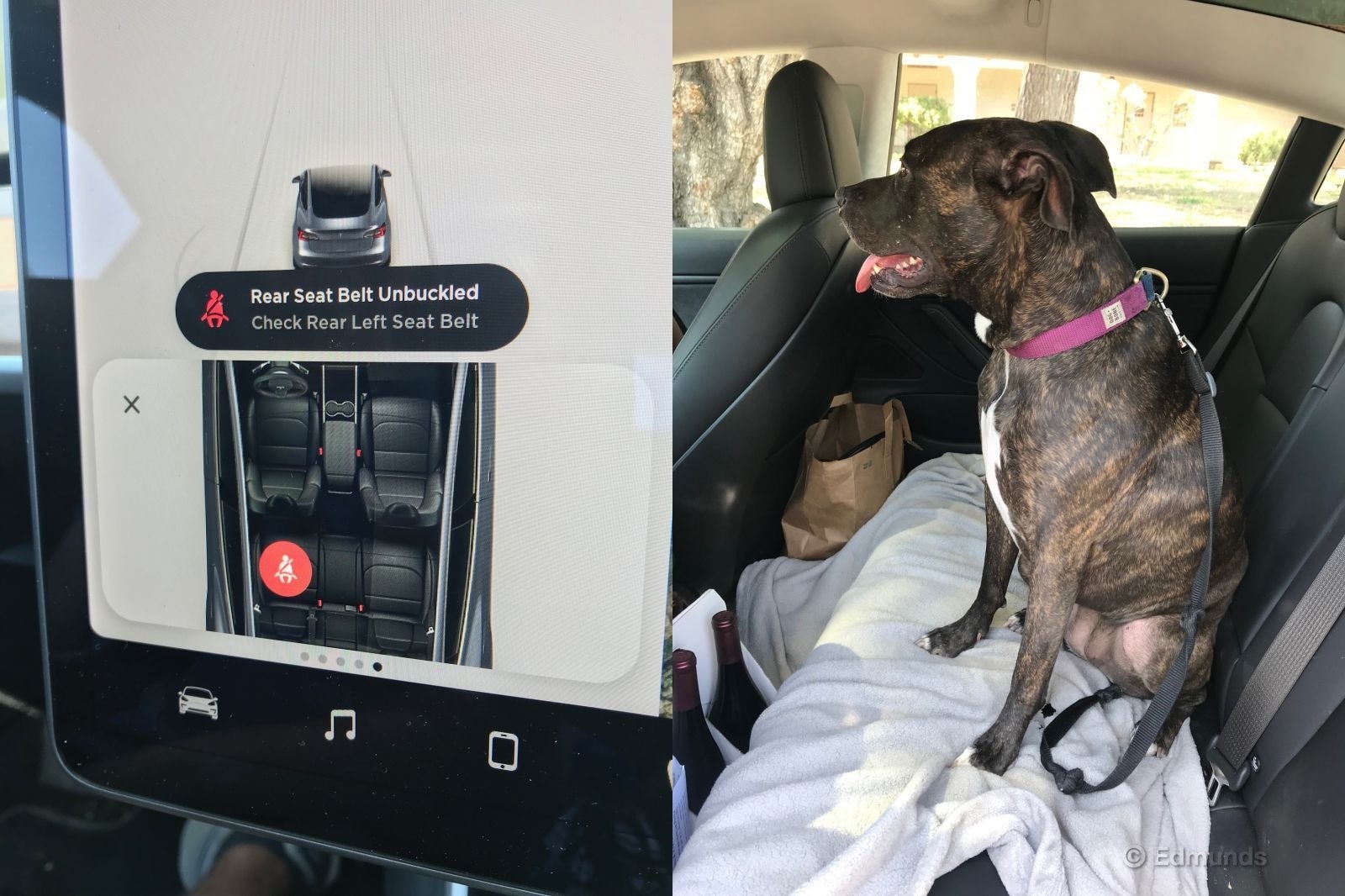
Interior
"The tall rear deck hampers rearward visibility. Sure, there's a backup camera for reversing (a truly terrific one ... when it works), but in traffic the cars aft of the Model 3 are much more obscured in the rearview mirror than in most other cars. And this is coming from a tall guy who enjoys a better vantage point than do." — Jason Kavanagh
MPG
"Paperwork snafus have prevented us from obtaining our HOV lane access stickers, so I found myself wading in amongst the regular traffic the past couple days. Two 88-mile round trips to work in L.A. slow-and-go traffic really does keep the speed down. But it wasn't total stop-and-go, so I was able to maintain a fairly steady pace that usually settled around 35 mph (and never dropped below 10 mph or exceeded 55 mph as the mass of cars ebbed and flowed). This is where EVs really shine, especially if you rely on regenerative braking, look far ahead and hang back a couple extra lengths to smooth out your speed transitions. My reward: an average of 177 Wh/mile and enough remaining juice to easily execute a third round trip. But I was flying out on a business trip. Maybe next time." — Dan Edmunds, director of vehicle testing
"The glass roof is pretty nice to have, but in California I think that feature makes it really hard to hit the expected range, at least in warmer weather. I went to Ojai and temps were moderate for SoCal (low 80s, sunny) and you can just feel the radiant heat through the glass. As a result, you got to continuously crank the air, which is going to affect the overall range.
"Leaving it outside a hotel in the sun all day, I also saw a bit of battery drain.
"Coming back from a hike, I could see from the Tesla app that the interior temp was 108. I turned on the air to cool the cabin. It's an amazing feature to have but, again, you start chipping away at the range. From a 265-mile charge, it looked like I lost around 10-12 miles of range with air, battery drain and an extra passenger." — Rich Kuras
Miscellaneous
"One good thing about the Tesla Model 3? If you drop your phone while seated, there really is no place for it to go other than the footwell floor. The space under the seat is pretty tight, tight enough to thwart any errant phone from slipping in. I misplaced my phone and thought it slipped out of my purse while I was riding in the Model 3 on the way to work. Unfortunately, as soon as we got to work, Tesla arrived to pick it up and whisked it away to the dealership to fix some issues.
"We notified the dealership and asked them to search for my Google Pixel while we called it (but the ringer was off). Meanwhile, I drove down there, 20 minutes from Edmunds HQ, convinced that I'd do a more thorough search than anyone. But when I was hunting around the car, I saw that, if it wasn't on either side of the seat, then chances were it wasn't there at all. The space under the passenger seat is so narrow that I could barely wedge my hand in there. After I swept the area with a flashlight and didn't see anything in the small patch of underseat carpet, I gave up the search. I'm not going to say where I ended up finding my phone but, yeah, it wasn't in the Model 3." — Caroline Pardilla, senior copy editor
Stopping Distance Retest After an ABS Firmware Update
We test 60-0 mph panic stops because it's an important safety criteria. Cars that can stop in a shorter distance are less likely to rear-end the car ahead. In cases where a crash is inevitable, they can bleed off more speed before contact is made. Besides the brakes themselves, three criteria affect braking performance: the grip available from the tires, the surface friction and quality of the road, and the proficiency of the antilock brake system (ABS).
Our initial 2017 Tesla Model 3 full-ABS panic-stop measurement of 133 feet was indeed below average. But it didn't seem outrageous, especially given the characteristics of the standard 18-inch tires. They're hard (with a treadwear rating of 500), they run at an abnormally high tire pressure (45 psi), and their 235 mm tread width isn't generous considering the car's 3,884 pounds of weight. It all seemed to fit, but that was before Consumer Reports reported a 60-0 mph stopping distance of 152 feet, nearly 20 feet longer than ours.
Location is the main difference between our tests. Our Southern California track is smooth and well cared for. Consumer Reports' test track is in Connecticut, where there's real winter. It isn't open to the public, but I'm imagining it has a suitably grippy surface that is looked after. But with a certain amount of unevenness and maybe even a few cracks brought about by the rigors of winter, CR's has the inevitable surface irregularities we know our track doesn't have.
I didn't suspect ABS calibration after our test because, frankly, that's hard to screw up. And the obvious safety implication involved means that ABS calibrations are typically optimized to the nth degree before a car goes on sale. But ABS tuning nevertheless seemed more likely after Consumer Reports announced its alarming figures, especially considering my suspicions about its track. Tesla removed any remaining doubt by announcing the imminent release of a new over-the-air firmware update that it said would address the issue.
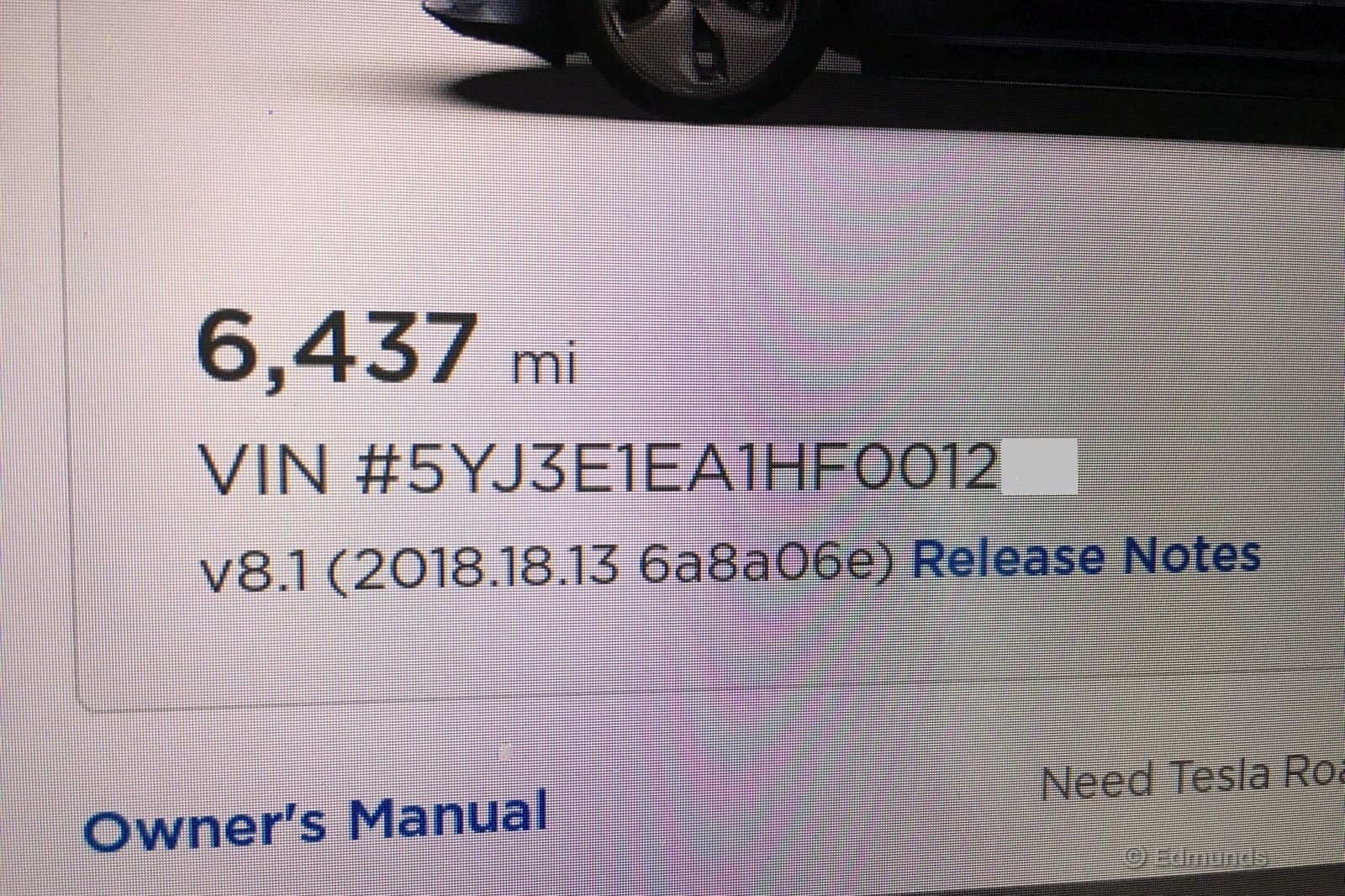
We recently confirmed that our car was updated with version 2018.18.13, the firmware version that according to Tesla "improved the calibration of the antilock braking program to be more effective across variations in usage and environmental conditions." We took this as our signal to take our Model 3 back to our test track.
With this new firmware, CR saw a near 20-foot improvement to 133 feet — the same distance we measured in our initial pre-fix testing. Tesla's revised ABS calibration did indeed lead to shorter stops on its test track, and the significant magnitude of the improvement suggested that Tesla's initial Model 3 ABS tune wasn't very good.
Thing is, we know our test track is smooth and utterly free of cracks. And since our initial results were identical to CR's improved ones, we had no idea if we would see any improvement on our home turf.
But we did.
Our first stop with the revised firmware measured 123 feet, exactly 10 feet shorter than our previous best. The second stop came in slightly better at 122 feet. In terms of feel, the initial "bite" of the brakes was more positive, and the ABS system pulsing was smoother throughout the stop. Our Tesla Model 3's stopping distance is now right where we'd expect it to be. Not better or worse than average, but solidly midpack.
As welcome as this was, it was still hard to take. Our result tells us that Tesla missed the ABS calibration mark in nearly ideal conditions, not just less-than-perfect ones.
In our track test video, I struggled with this and tried to come up with an alternate explanation. I theorized that the handoff from regenerative to friction braking might be in play — a unique issue that electric vehicles must deal with. This possibility seemed especially plausible in light of the Model 3's rear-axle-only regenerative braking and rearward weight bias.
EVs attempt to recover as much energy as they can using regenerative braking, a scheme wherein the electric drive motor is reconfigured to be a generator when the driver wants to slow down. Regenerative energy recovery is something you want to do as much of as possible to maximize range. During a panic stop, however, it's best to switch it off and let the brake pads and rotors work alone with the ABS system to execute the shortest stop possible.
This alternative explanation was apparently bunk. Tesla has since reached out to say my handover theory was not the issue. The carmaker put it all down to ABS calibration. I'd say it was a particularly bad ABS brake calibration if we could measure such a sizable difference on such a smooth surface.
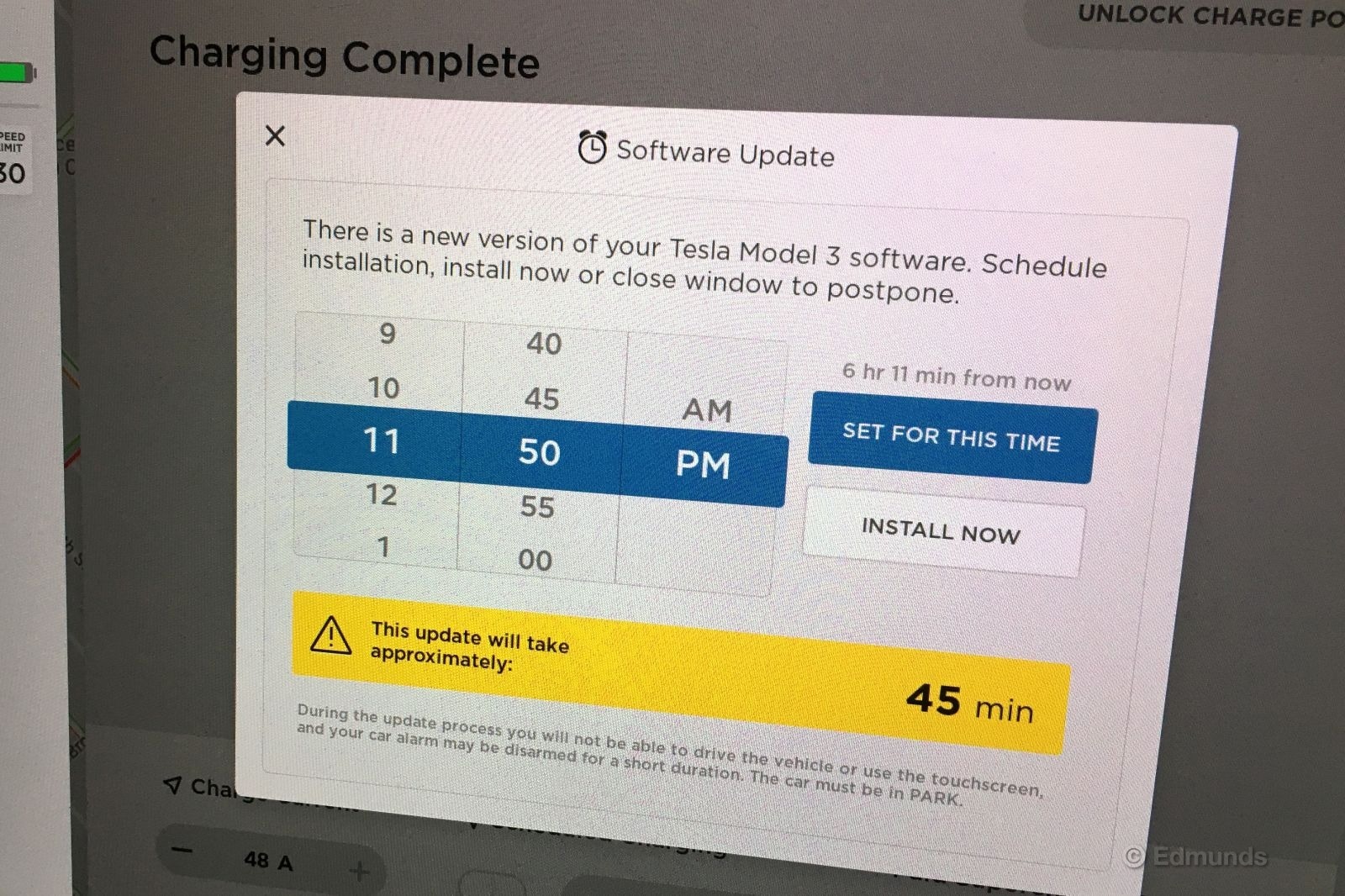
The second biggest positive to come out of this was the ease with which our car was updated. Over-the-air firmware updates just happen, and Tesla is the only car company that swears by them. Because of this, no trip to the service center was involved. We got notified that an update was about to occur overnight via an on-screen message, and it was done when we got in the car the next morning. With any other company, this would have been a formal recall that could have dragged on through a lengthy review process before a dealer-installed remedy was made available.
The only trouble with what is being called "the brake fix" is that it wasn't described in the on-screen "Release Notes" that typically accompany major updates. At first we didn't know if our car had been updated or not. It turns out that 2018.18.13 was indeed the one, but that download came with no explanation or description whatsoever. I received confirmation from Tesla public relations after the fact.
If you own a Model 3, your car has almost certainly been updated. Check your car's software version number to be sure. The "18" in the middle of the number sequence refers to the 18th week of the year, and the 13 refers to the 13th software iteration of that week. Any sequence number that reads 18.13 or higher means you are up-to-date.
This is a critical update, but don't expect to notice any difference in daily driving. The ABS calibration only comes into play during very hard emergency stops or when braking aggressively on unusually uneven, dirty or wet surfaces. The main exception, of course, is wintertime driving on snow and ice, but we're months away from knowing how that might have changed.
It's great that such a significant problem resolution was so easily made with no effort on our part. But this should not have happened in the first place. It's kind of like watching a driver get all sideways in a race and then miraculously keep it out of the wall. "Great save! What skill," they'll say. I'm the one who will reply, "Skill? Aren't you forgetting that he botched the corner in the first place?"
Monthly Update for June 2018
Where Did We Drive It?
In case you missed it last month, we returned to the Edmunds test track with our long-term2017 Tesla Model 3 to retest braking performance following an over-the-air software update that Tesla pushed out in late May. This software update was in response to various production Model 3s returning less-than-stellar emergency braking performance during instrumented testing. You can read all about it (and watch it!) by following the link above.
The rest of the month was spent mostly around the Los Angeles area, with a couple of short weekend trips north to the Ojai Valley. Thankfully, we encountered very few issues in June compared to months prior. Let's hope it's a sign of the times and more stable firmware.
What Kind of Fuel Economy Did It Get?
Our Model 3 continues to accrue mileage at a relatively conservative rate, covering just 650 miles in June. June also proved to be a much less efficient month, due to either a bunch of lead-foot drivers at the wheel or, more likely, increased dependency on the A/C system with the warmer days upon us.
Compared to our most efficient consumption average from May — 29.5 kilowatt-hours per 100 miles — June clocked in at a shameful 36.8 kilowatt-hours per 100 miles (91.6 miles per gallon equivalent), our worst month to date.
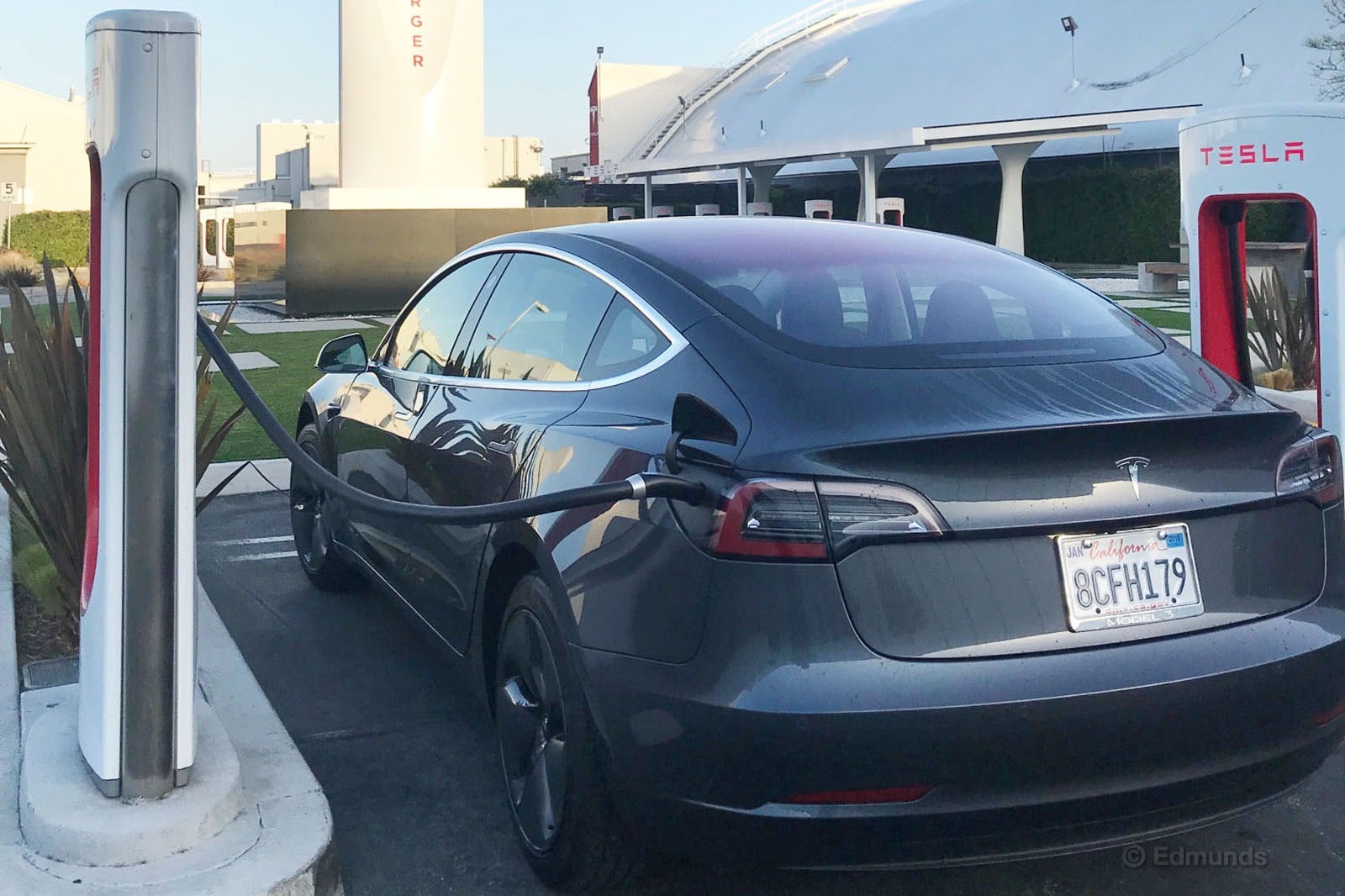
Aside from higher overall monthly average, moving us further from the EPA consumption rating, there were no single-charge records set this month, good or bad.
Current odometer: 6,659 miles
Average lifetime recharge electricity consumption: 31.8 kWh/100 miles (105.9 mpge)
EPA consumption rating: 27 kWh/100 combined miles (126 mpge)
Best single fill, June: 28.6 kWh/100 miles (117.8 mpge)
Best single fill, lifetime: 25.6 kWh/100 miles (131.5 mpge)
Best onboard consumption meter reading: 177 Wh/mi
Average meter reading: 250.3 Wh/mi
Worst reading (aka "The Leadfoot Award"): 323 Wh/mi
Maintenance and Upkeep
Aside from the over-the-air software update mentioned above, our Model 3 underwent no maintenance and upkeep this month.
Logbook Highlights
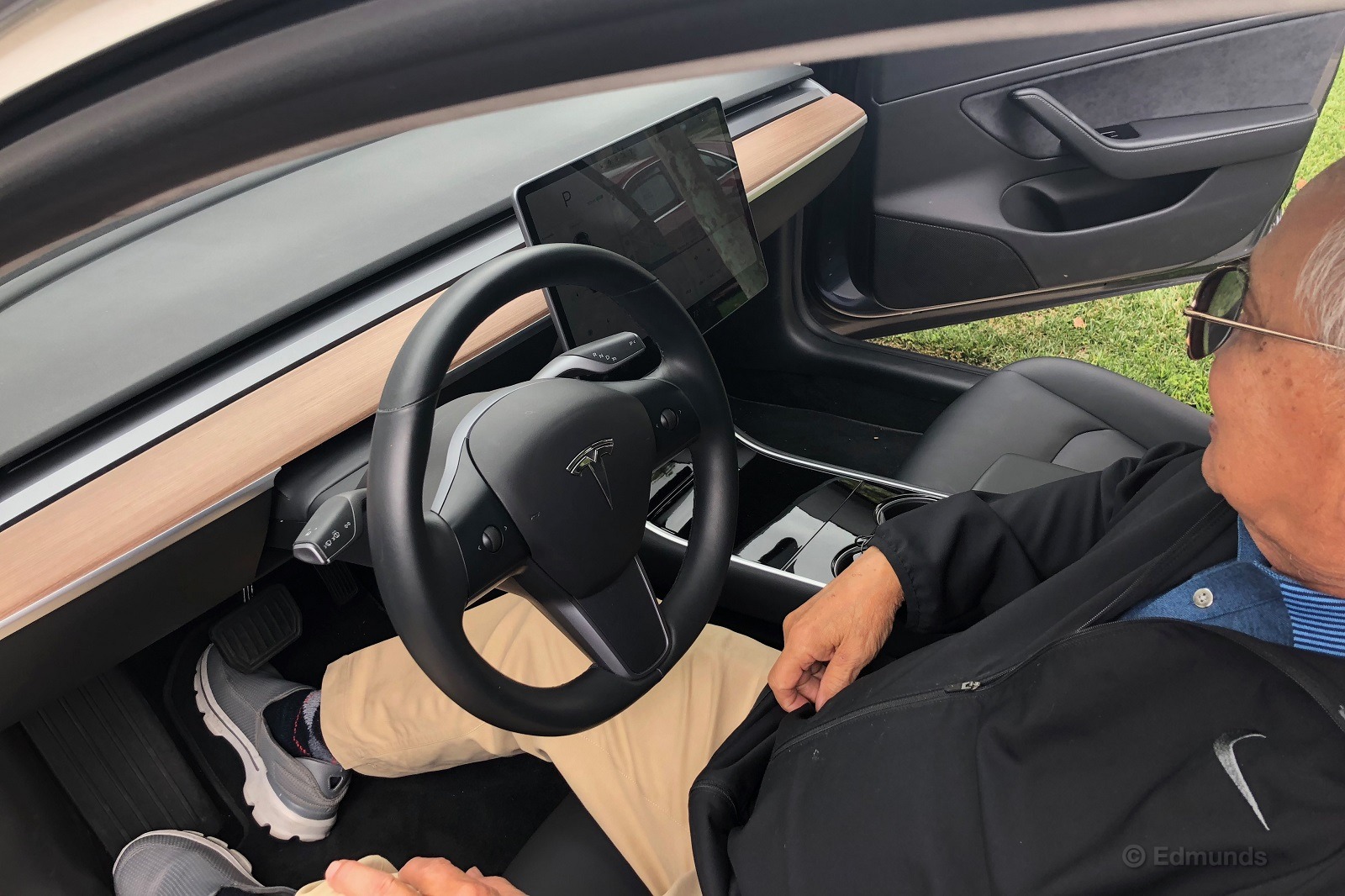
Miscellaneous
"What an 80-year-old thinks of the Tesla Model 3: For Father's Day I borrowed the Tesla Model 3 figuring my dad would get a kick out of it. He suffers from gadget lust. First thing he remarked about the Model 3 was how expensive-looking and beautiful it was. Other things he dug: that glass roof, the 'iPad controls' and the frunk.
"'It's very clean and plain,' he said, commenting on the interior's Apple store aesthetic. The only thing Dad seemed bummed about, besides its lack of Ludicrous mode, was that there wasn't an engine he could gawk at." — Caroline Pardilla, senior copy editor

"This weekend I've discovered a new reason I want to yell at our Model 3 to 'get off my lwn': that key card. First, it doesn't always work when you want to unlock the car. You're supposed to tap it on a specific spot on the B-pillar [side roof pillar] to unlock the door. But that never worked for me, so I always had to first boot up the app on my phone to unlock it. And then when you want to start driving you have to place the card or your phone on the center console near the cupholders. But I wonder if other Tesla owners actually find this preferable to an actual key or key fob? And if so, in what way?" — Caroline Pardilla
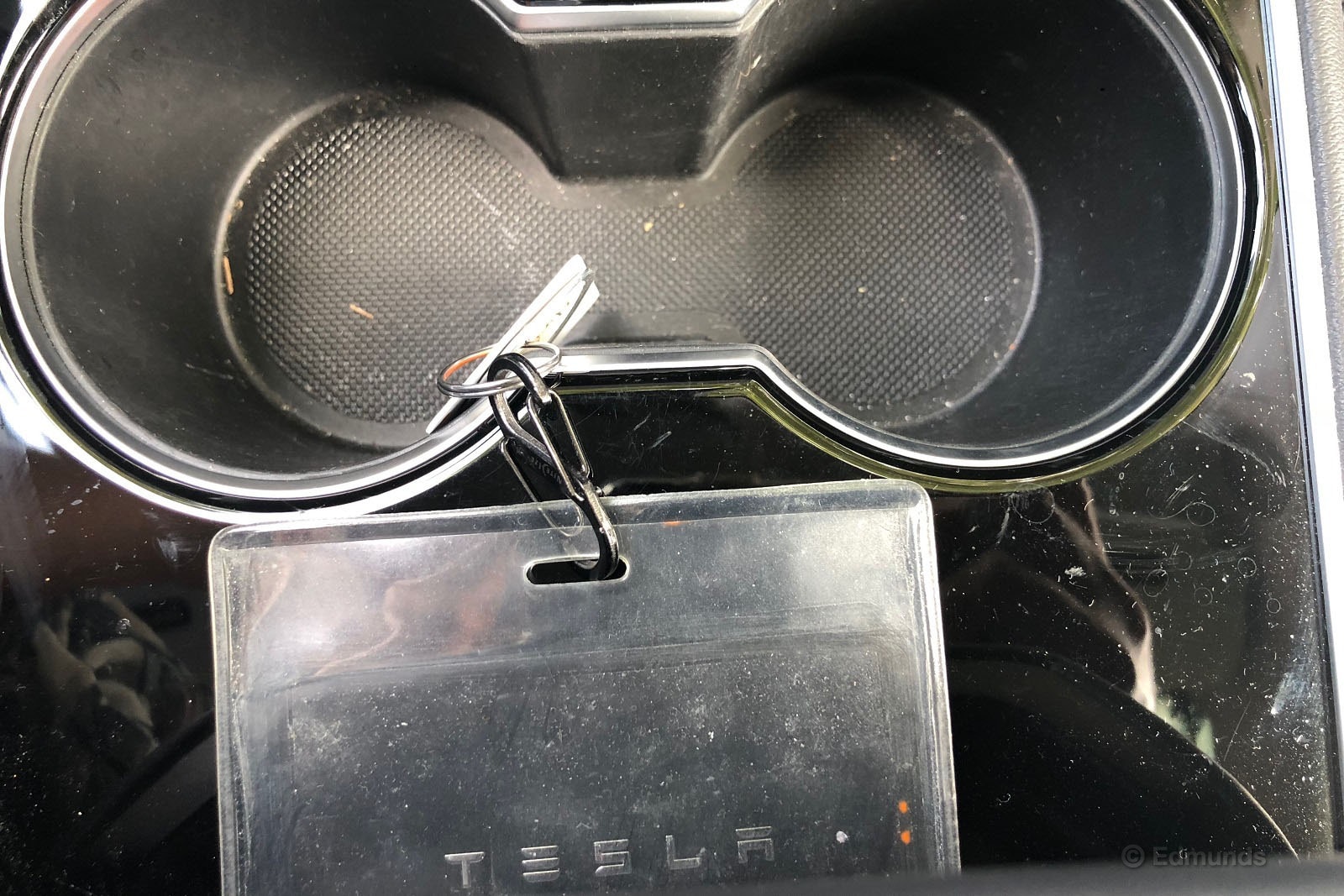
Technology
"For as high-tech as the Model 3 purports to be, the lack of Apple CarPlay and Android Auto is still a glaring omission. Yes the Model 3 has Google Maps and music streaming, but I prefer the integration of my music services, podcast apps, and the ability to send and receive texts via voice." — Ron Montoya, senior consumer advice editor
Monthly Update for July 2018
Where Did We Drive It?
Besides the usual daily commutes, our long-term 2017 Tesla Model 3 spent some time in Central California with editor Brent Romans. And it also co-starred in a video where it performed flawlessly during a day spent touring L.A. in search of great food. In a rare instance, the Model 3 was trouble-free for all of July and didn't require any maintenance visits this month. That's right — seven months into ownership and it seems like the turbulence has cleared.
Have all the problems been fixed? We hope so.
What Kind of Fuel Economy Did It Get?
We added 1,020 miles to the Model 3's odometer in July. About 400 miles of that was Brent driving to and from Fresno, California. Despite setting a new record for worst efficiency (400 watt-hours per mile), our lifetime average improved ever so slightly to 31.7 kilowatt-hours per 100 miles. It was 31.8 kWh/100 miles in June. There was an errant data block that delivered a shocking 570 Wh/mi, but it turns out that it was just a switch from normal to extended range at our charger.
Current odometer: 7,679 miles
Average lifetime recharge electricity consumption: 31.7 kWh/100 miles (106.2 miles per gallon equivalent)
EPA consumption rating: 27 kWh/100 combined miles (126 mpge)
Best single fill, July: 28.0 kWh/100 miles (120.4 mpge)
Best single fill, lifetime: 25.6 kWh/100 miles (131.5 mpge)
Best onboard consumption meter reading: 177 Wh/mi
Average meter reading: 250.9 Wh/mi
Worst reading (aka "The Leadfoot Award"): 400 Wh/mi
Maintenance and Upkeep
None.

Logbook Highlights
Interior
"I really don't like how there are no hard buttons in the Model 3 to adjust the side mirrors. It's a tedious process that you can't do on the fly. I often need to be parked to navigate the various button presses on the screen and on the steering wheel. Even if you're not like us, who switch drivers on a regular basis, mirrors are something that often need to be adjusted from the car wash or the valet." — Ron Montoya, senior consumer advice editor
Technology-Audio
"I keep forgetting that the Model 3 doesn't have satellite radio. It's not much of an issue when I'm driving alone and listening to podcasts, but my friends and family don't enjoy listening to Adam Scott Aukerman talk about U2 as much as I do. In that case, satellite radio is the way to go, especially on long road trips where I can tune it to Alt Nation and not think about music for a few hours.
"Tesla didn't include satellite radio on the Model S and X, and this trend, unfortunately, continues with the Model 3. Tesla does offer internet radio through the touchscreen, however, and there are a ton of channels to choose from. If you absolutely must have Howard Stern or the curated channels that pop up throughout the SiriusXM band, there's a workaround. You just have to download the Sirius app and stream it to the car via Bluetooth. Of course, you'll have to keep an eye on your data usage in this case." — Cameron Rogers, staff writer
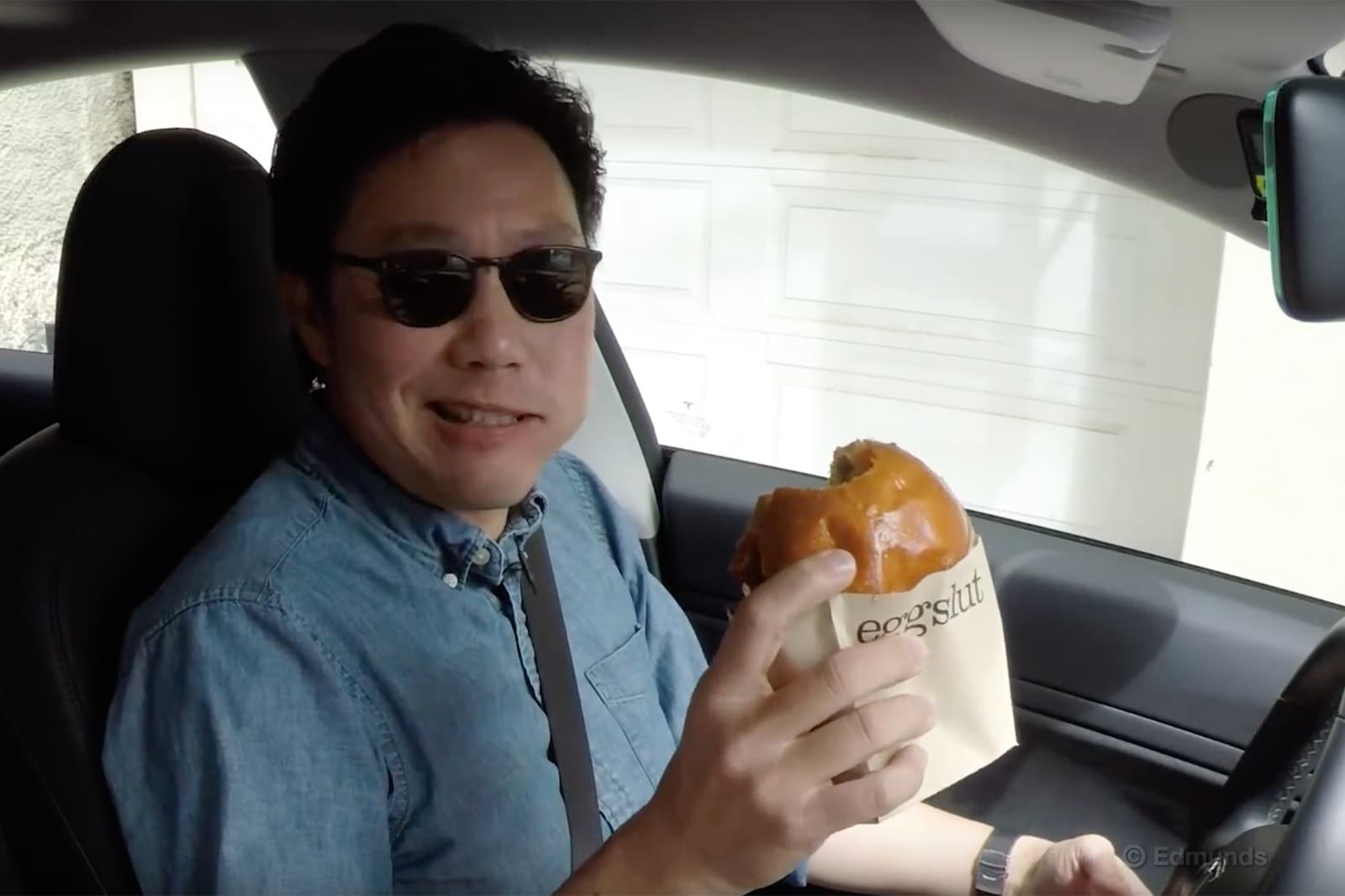
Monthly Update for August 2018
Where Did We Drive It?
Like last month, our long-term Tesla Model 3 spent most of August quietly covering miles under the stewardship of Brent Romans. Unlike last month, the experience wasn't flawless.
What happened? The switch on the passenger-seat recline broke during operation. Regular readers will remember this switch broke back in January, potentially due to user error. We had it repaired, but alas it's happened again.
Otherwise, Brent reports on getting used to the idea of leaving the physical key at home and using his phone to access the car. It's a neat process — when it works. Otherwise, we enjoyed the handling, though found the turning circle a bit larger than we expected.
What Kind of Fuel Economy Did It Get?
Our Model 3 covered 1,502 miles this month, which is a pretty strong result. We set a new longest-trip record by a hair, at 204.7 miles. Lifetime average energy consumption continues to improve as well, now at 31 kWh/100 miles.
Current odometer: 9,329 miles
Average lifetime recharge electricity consumption: 31 kWh/100 miles (108.8 miles per gallon equivalent)
EPA consumption rating: 27 kWh/100 combined miles (126 mpge)
Best single fill, August: 26.7 kWh/100 miles (126.2 mpge)
Best single fill, lifetime: 25.6 kWh/100 miles (131.5 mpge)
Best onboard consumption meter reading: 177 Wh/mi
Average meter reading: 247.6 Wh/mi
Worst reading (aka "The Leadfoot Award"): 570 Wh/mi
Maintenance and Upkeep
None.
Logbook Highlights
Comfort
"The Model 3 will turn on its climate control system as you approach the car (with your phone) and open the door. Even if it's just a few extra seconds, getting the air conditioning automatically cranking is a neat feature to have on a hot summer day." — Brent Romans, senior editor
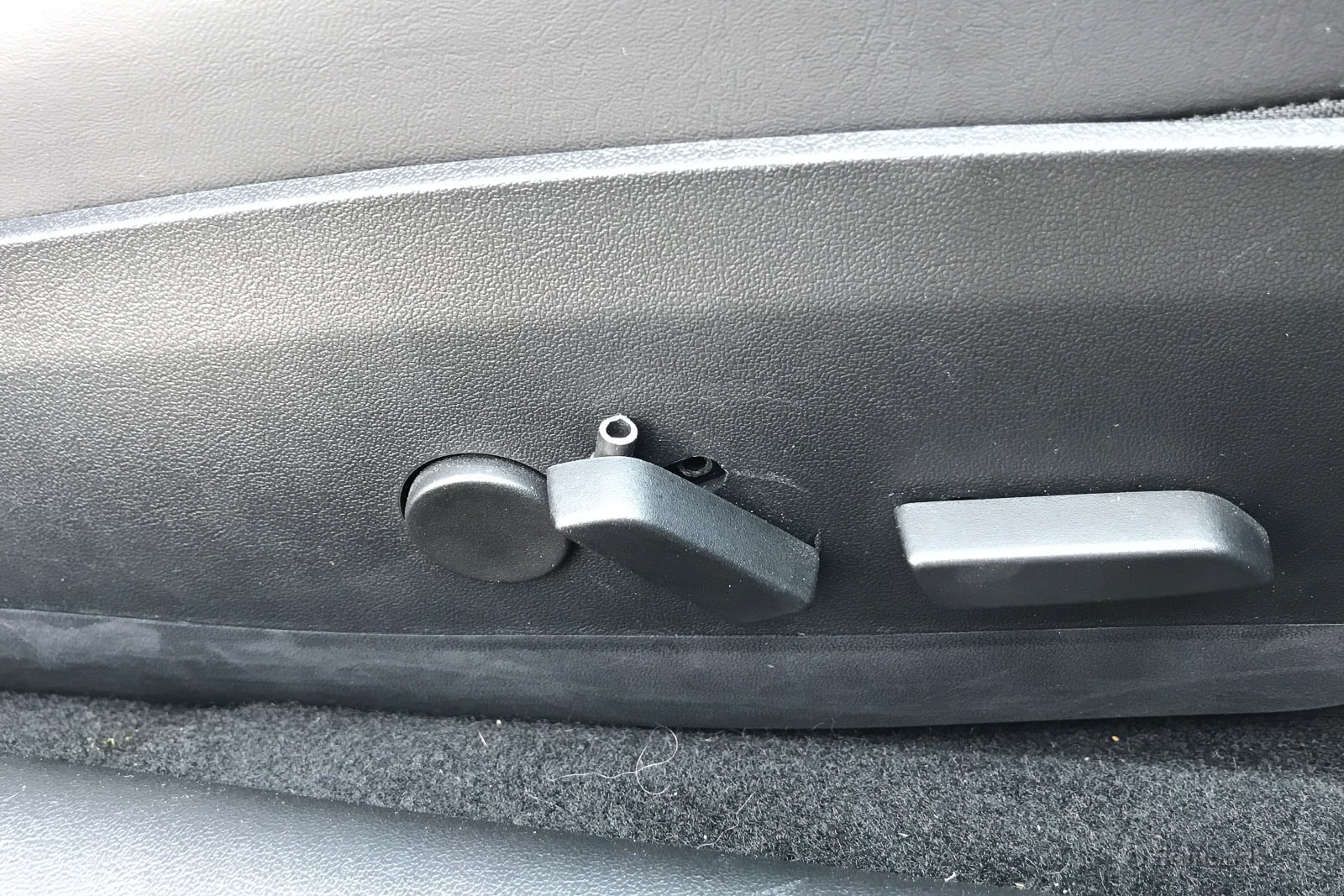
Maintenance
"The front passenger seat's backrest angle adjuster switch broke. Again. If you'll recall, it broke back in January. I was adjusting the seat, and a little internal plastic piece that connects to the outside adjustment switch snapped. No worries, Tesla. This kind of thing happens all the time on Toyotas, I hear." — Brent Romans
Technology-Audio
"I've been driving our Model 3 for about two weeks straight. For the first few days, I kept the key card with me because I didn't trust the phone-based access system. (We had some issues with the phone-based system not working properly early on.) But it always seemed to work for me, so I started leaving the key card at home. It is nice not having to carry around a key, especially when I'm going to the gym. All I need is my phone." — Brent Romans
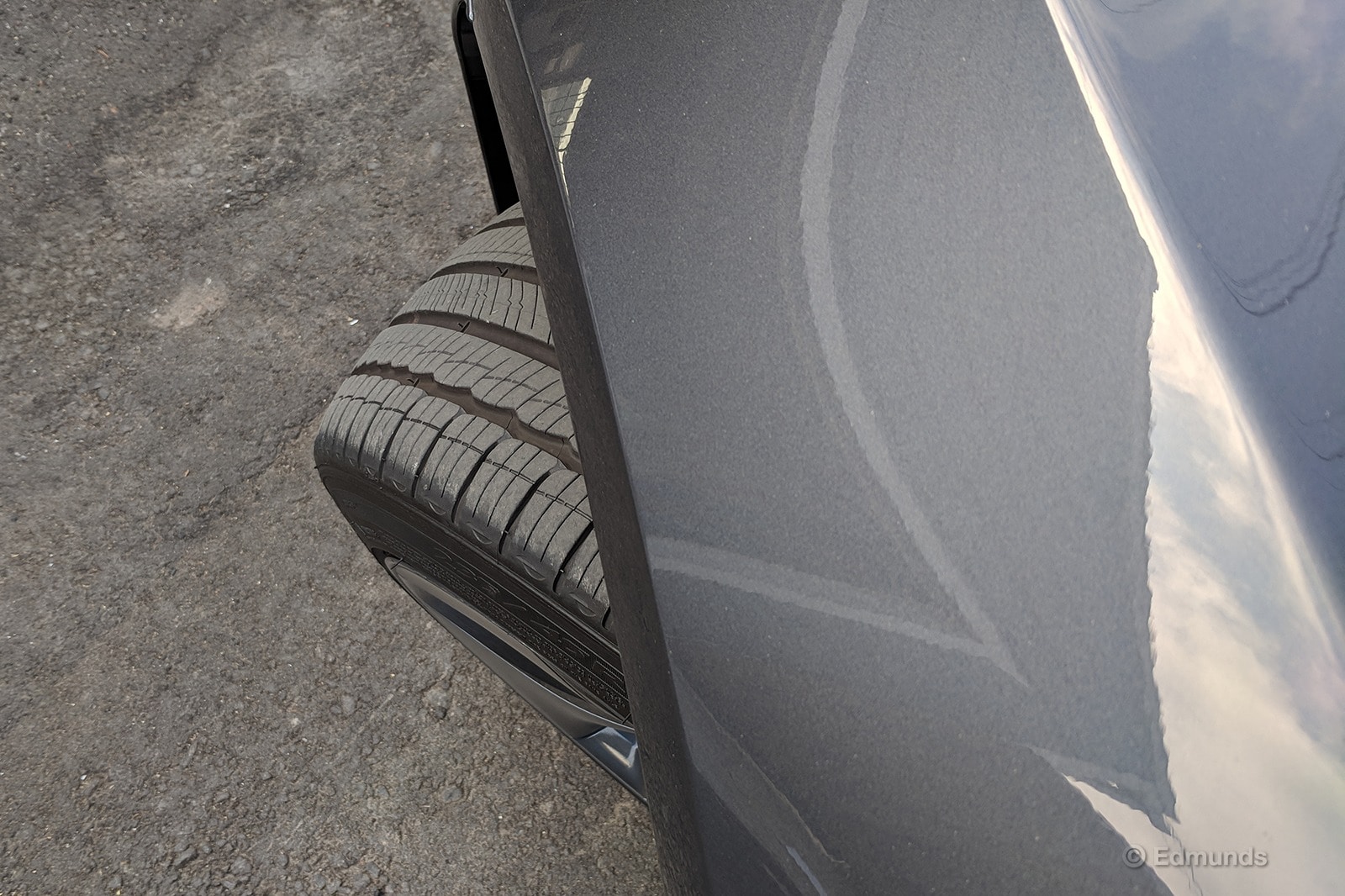
Performance
"The Model 3's handling is impressive. Jay and Josh have commented about this previously, and they're right. The 3 is a lot more fun to drive around turns than the Chevy Bolt, VW e-Golf and Nissan Leaf. It turns in willingly and has a pleasing amount of grip. It's better than the BMW i3, too. The i3 is nimble, but it doesn't have the same handling balance and grip as the Model 3." — Brent Romans
"I expected the turning circle of the Model 3 to be a little tighter than it is, seeing as it doesn't have a traditional engine and transmission in the front end to get in the way. But I was caught off guard a few times not being able to pull straight into parking spots, or even my garage, without having to back up and take another shot at it. It's not exactly a huge inconvenience, but as I said, I expected a car of this configuration and size to have a smaller curb-to-curb turning circle. Because I know you're interested, it's 38.8 feet. For comparison's sake, the 2018 Chevrolet Impala, 2017 Lexus LS 460 AWD and 2017 Acura TLX V6 also take 38.8 feet. The 2017 Cadillac XTS Funeral Coach (a hearse) can do it in 38.7 feet, the 2017 BMW M3 does it in a whopping 40, the 2017 Lexus GS needs 34.8 feet, and the 2017 Mitsubishi Mirage only needs 30.2 feet." — Kurt Niebuhr, road test editor
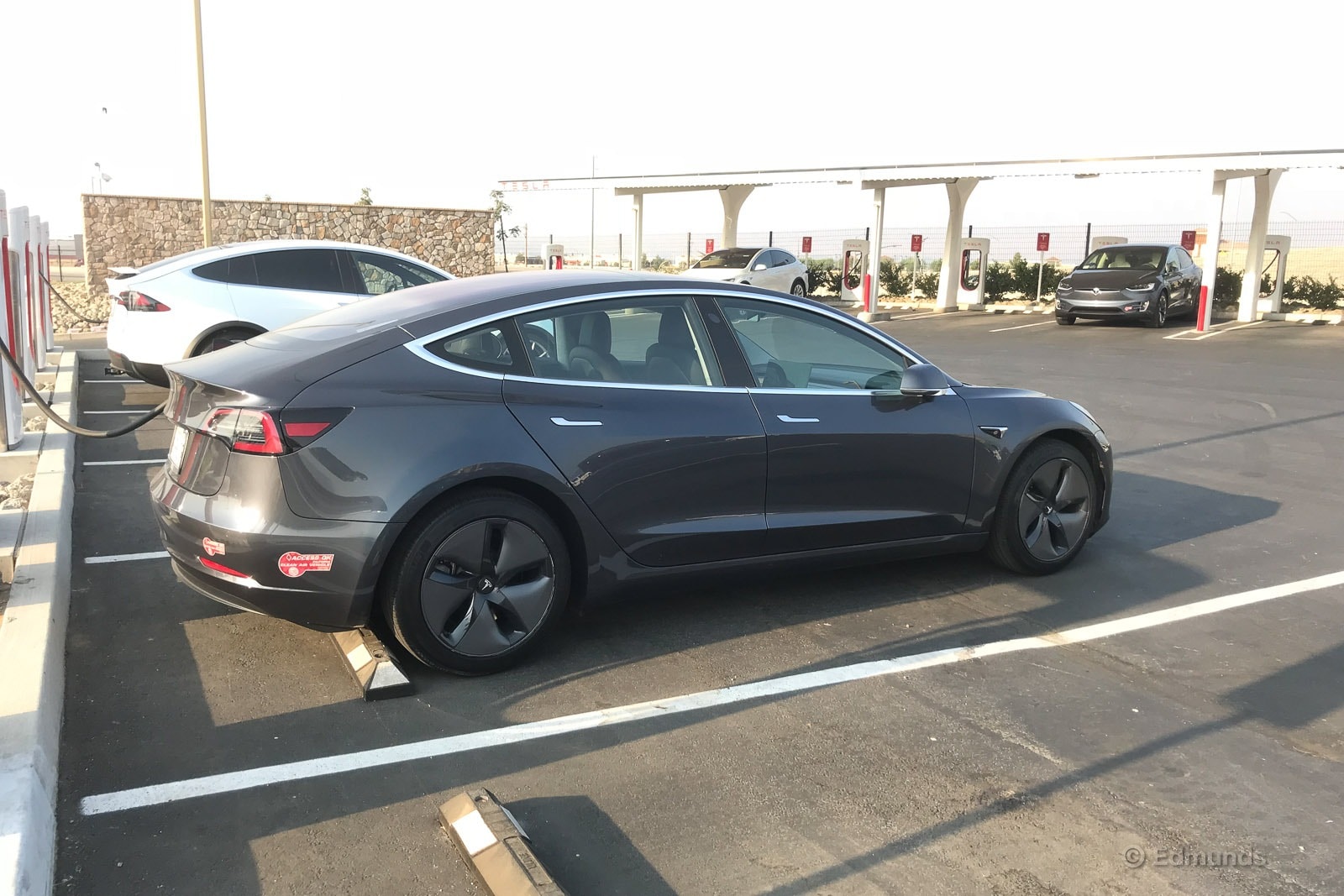
Monthly Update for September 2018
Where Did We Drive It?
September marked an important milestone for our long-term 2017 Tesla Model 3: It reached 10,000 miles on the odometer. While we neglected to commemorate this accomplishment, we are happy to report the passing of another month without a mechanical or technical fault. Now that's cause for celebration.
Our Model 3 spent the month commuting to and from the office. Dan Edmunds commented on the difficulty of achieving the electricity consumption needed to meet the rated range in comparison to other electric vehicles, and surmised the car's true value rests in the scale of Tesla's Supercharger network.
What Kind of Fuel Economy Did It Get?
We put almost exactly 1,000 miles on our Model 3 in September, and little changed with regard to "fuel" economy. We traveled between 50 and 145 miles between charges and our most efficient journey on a single charge came in at 28.0 kWh/100 miles (120.4 miles per gallon equivalent). That didn't affect our average electricity consumption too much, though; it remains at 31.1 kWh/100 miles.
Average lifetime consumption: 31.1 kWh/100 miles (108.5 mpge)
EPA consumption rating: 27 kWh/100 combined miles (126 mpge)
Best fill consumption: 25.6 kWh/100 miles (131.5 mpge)
Best range: 204.7 miles
Current odometer: 10,307 miles
Other fun facts:
Best onboard consumption meter reading (aka "The Featherfoot Award"): 177 Wh/mi
Worst reading (aka "The Leadfoot Award"): 570 Wh/mi
Average meter reading: 247.0 Wh/mi
Maintenance and Upkeep
None.
Logbook Highlights
MPG
"Unlike other electric cars in our fleet, I feel like I have to pedal the Model 3 especially softly to approach its rated electricity consumption and range ratings. Approach is the key word here, because I never quite reach them. Meanwhile, I find it very easy to meet and exceed range and consumption bogeys for the Bolt and the Leaf. What gives, Tesla?" — Dan Edmunds
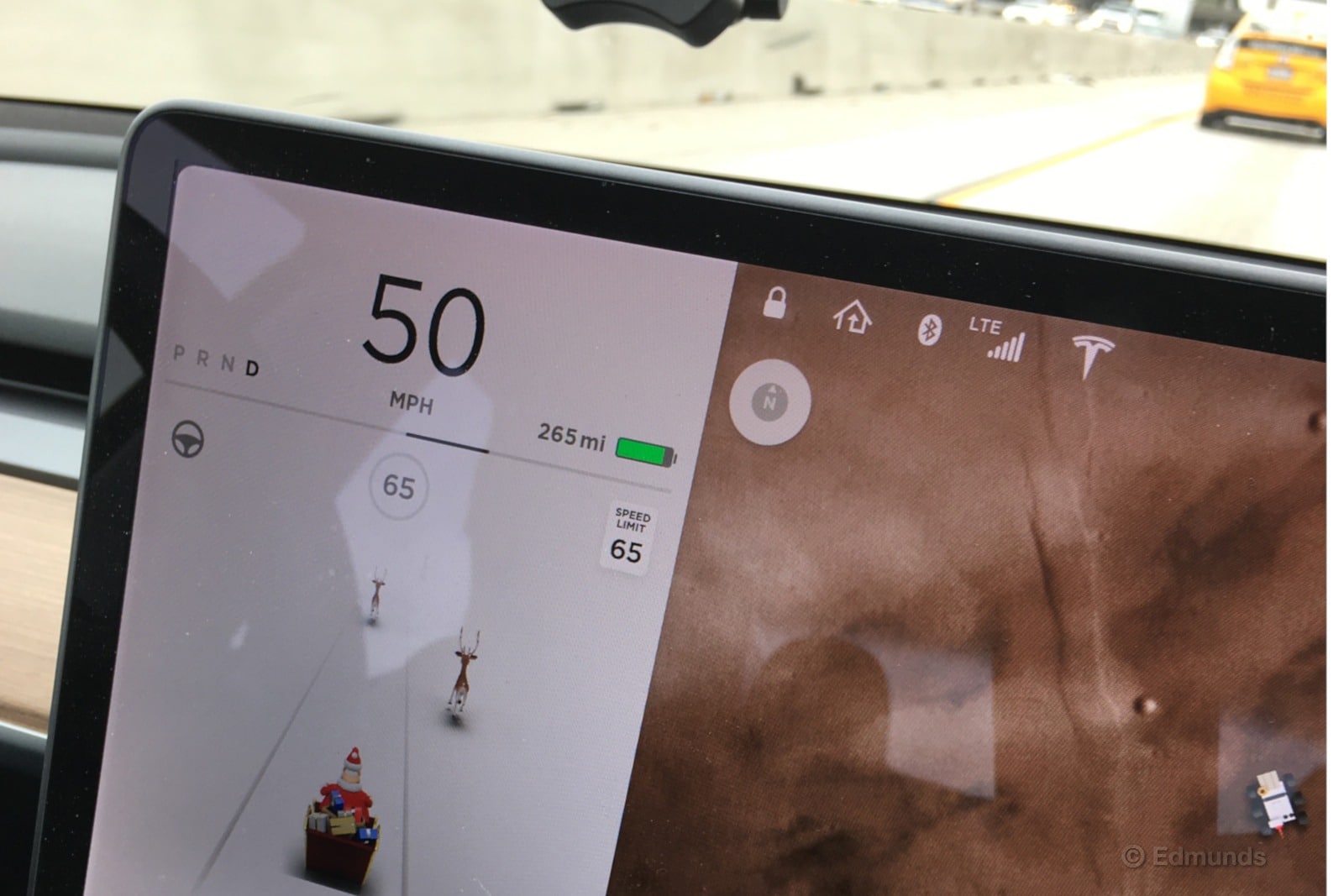
Interior
"I hate the lack of straight-ahead gauges in a Prius, and I would be remiss if I didn't echo that complaint here. Center-mounted instruments and readouts pull the driver's eyes away from looking forward with eyes on the road. Sure, it looks cool, but any conceptual artist can do that if they ignore day-to-day human interaction. I'll take more function and less form any day of the week." — Dan Edmunds
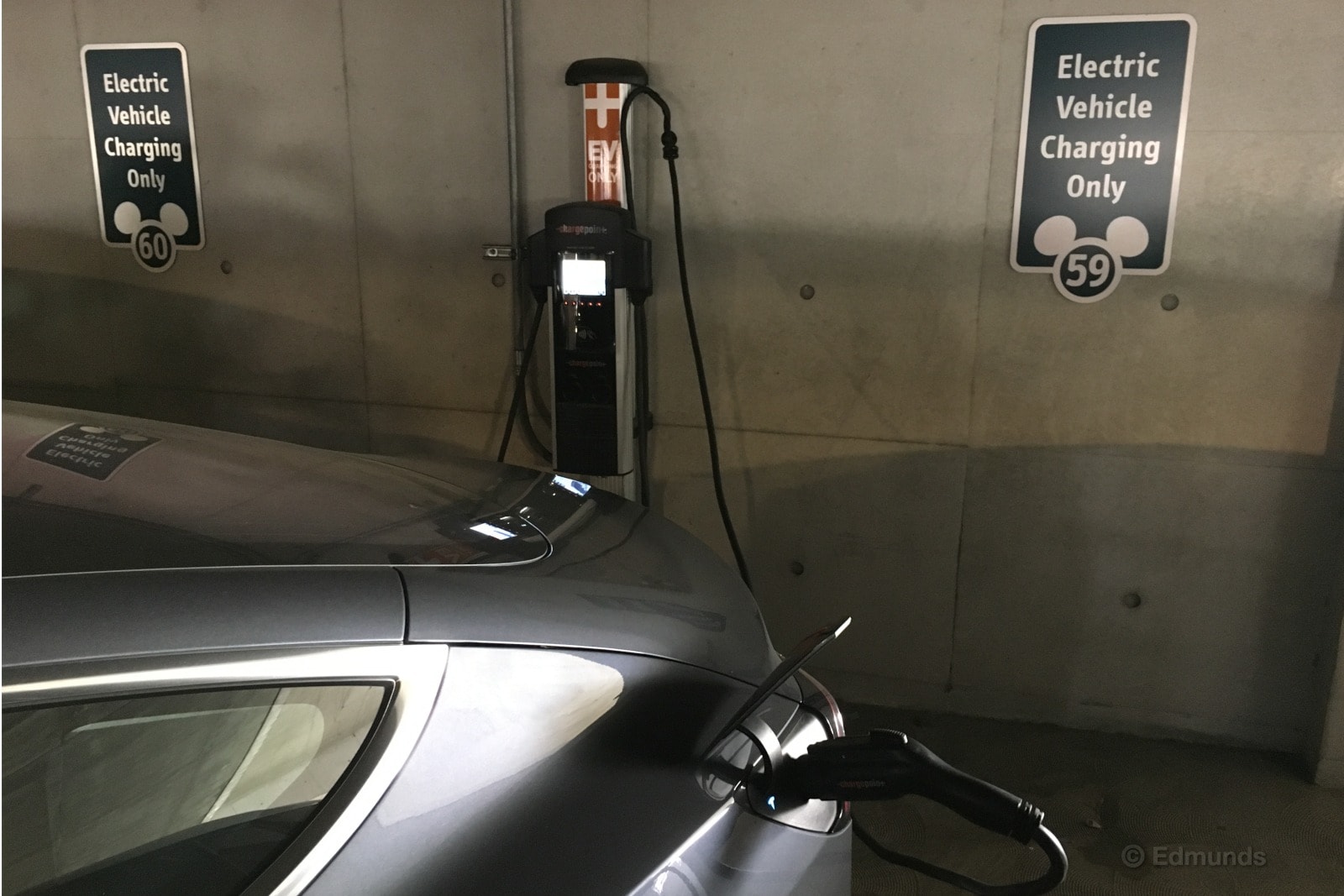
Technology
"You know what the best part of any Tesla is? It's not the car — it's the Supercharger network. Fast charging is something most competing EVs can support, but that capability is largely theoretical because vast SAE Combo and CHAdeMO networks do not exist. Such chargers are sprinkled around seemingly at random, and each location can only support one car at a time, maybe two if you're lucky.
"Meanwhile, I'm sitting here charging at a 12-bay Supercharger, and from here I could drive to the corners of the country on a whim — Seattle, New York, Key West, even. The promise of decent range isn't enough. Quick charging capability doesn't do it either. No, the key here is the network of charge points with the promise of little or no waiting when you arrive. The Supercharger network is what makes Tesla stand apart — not the cars or Elon Musk." — Dan Edmunds, director, vehicle testing

Monthly Update for October 2018
Where Did We Drive It?
Our long-term 2017 Tesla Model 3 went through a transformation in October. If the photographs surrounding this text haven't already given it away, we got it wrapped. Look for more detail about that process and photos of the result soon.
Before going under the knife, it was a normal month for the Model 3. Travis Langness detailed the many party tricks it offers first-timers, from the funky door handles to the ability to move the car from your phone with the Summon feature.
What Kind of Fuel Economy Did It Get?
The wrap installation took a few days, so we didn't put as many miles on the Model 3 in October as we'd have liked. We charged the Model 3 eight times this month, and distances between charges ranged from 63 to 163 miles. Average energy consumption improved to 30.8 kWh/100 miles versus the 31.1 kWh/100 miles figure we reported last month.
Average lifetime consumption: 30.8 kWh/100 miles (109.3 mpge)
EPA consumption rating: 27 kWh/100 combined miles (126 mpge)
Best fill consumption: 25.6 kWh/100 miles (131.5 mpge)
Best range: 204.7 miles
Current odometer: 11,174 miles
Other fun facts:
• Best onboard consumption meter reading (aka "The Featherfoot Award"): 177 Wh/mi
• Worst reading (aka "The Leadfoot Award"): 570 Wh/mi
• Average meter reading: 244.9 Wh/mi
Maintenance and Upkeep
None.
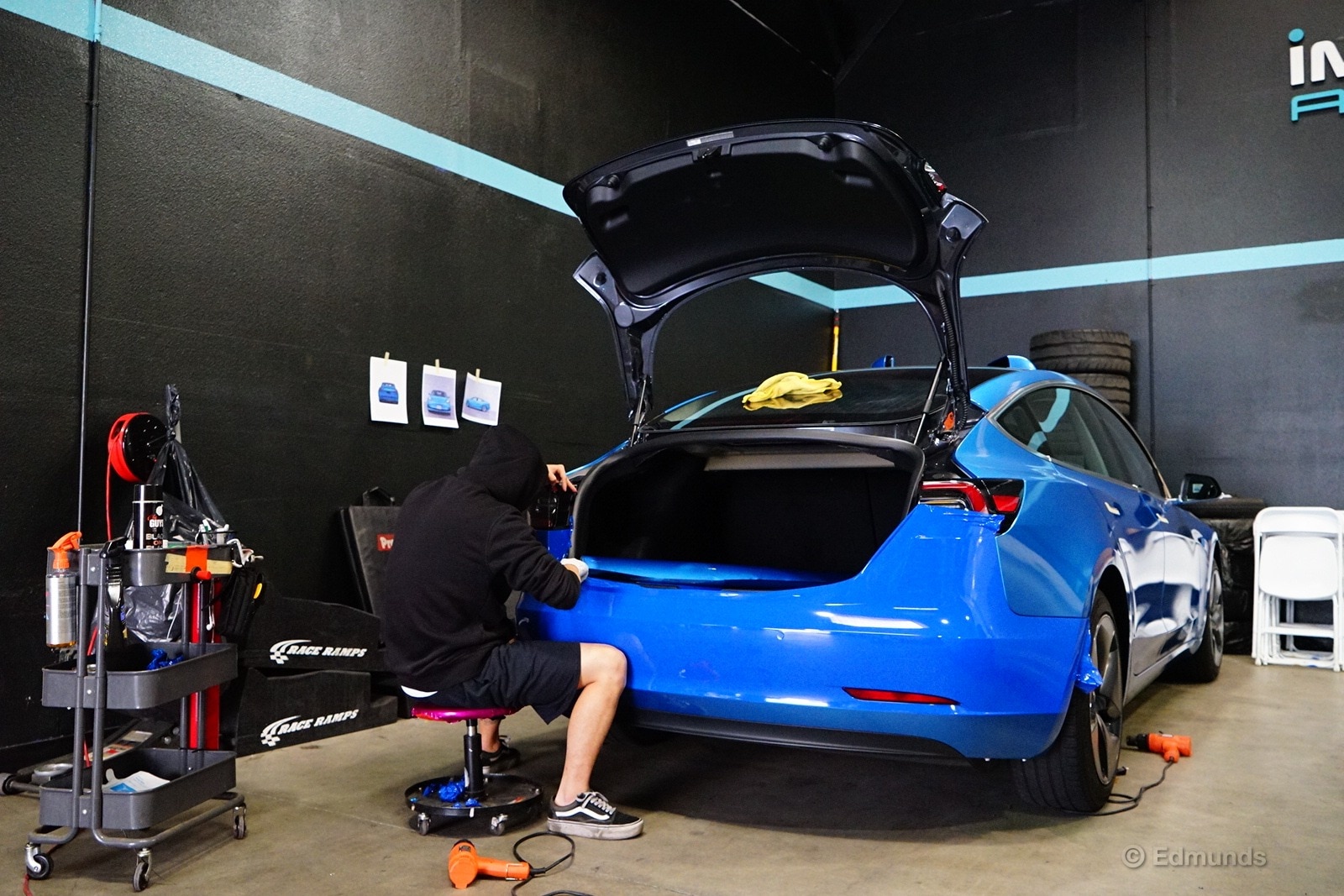
Logbook Highlights
Technology
"The Model 3 has no shortage of party tricks.
"Party Trick No. 1: Take your friends out for a ride, and 75 percent of them will ask how to use the door handles.
"Party Trick No. 2: Autopilot. This irresponsibly named cruise control system is fun to use momentarily, showing people that the car can drive itself. (Note: It can't, and it shouldn't be treated that way, but it's fun to pretend.)
"Party Trick No. 3: The pick-whatever-song-you-want internet radio feature. It's a great way to start a four-person karaoke session.
"Party Trick No. 4: The sheer performance. This car has lots of on-demand torque, and it's fast through the corners. Even car people aren't used to that without the associated noises such as exhaust and engine revs. It's freaky and a bit fun.
"Party Trick No. 5: The Summon feature. You can move the car forward and reverse it with your phone. Do it way before you get to the car, though. Otherwise, you'll be standing around for five minutes waiting to show off a trick while your passengers stand in the rain. Performance assessments aside, if you're looking to impress people, this is certainly a fun car to do it with." — Travis Langness, reviews editor
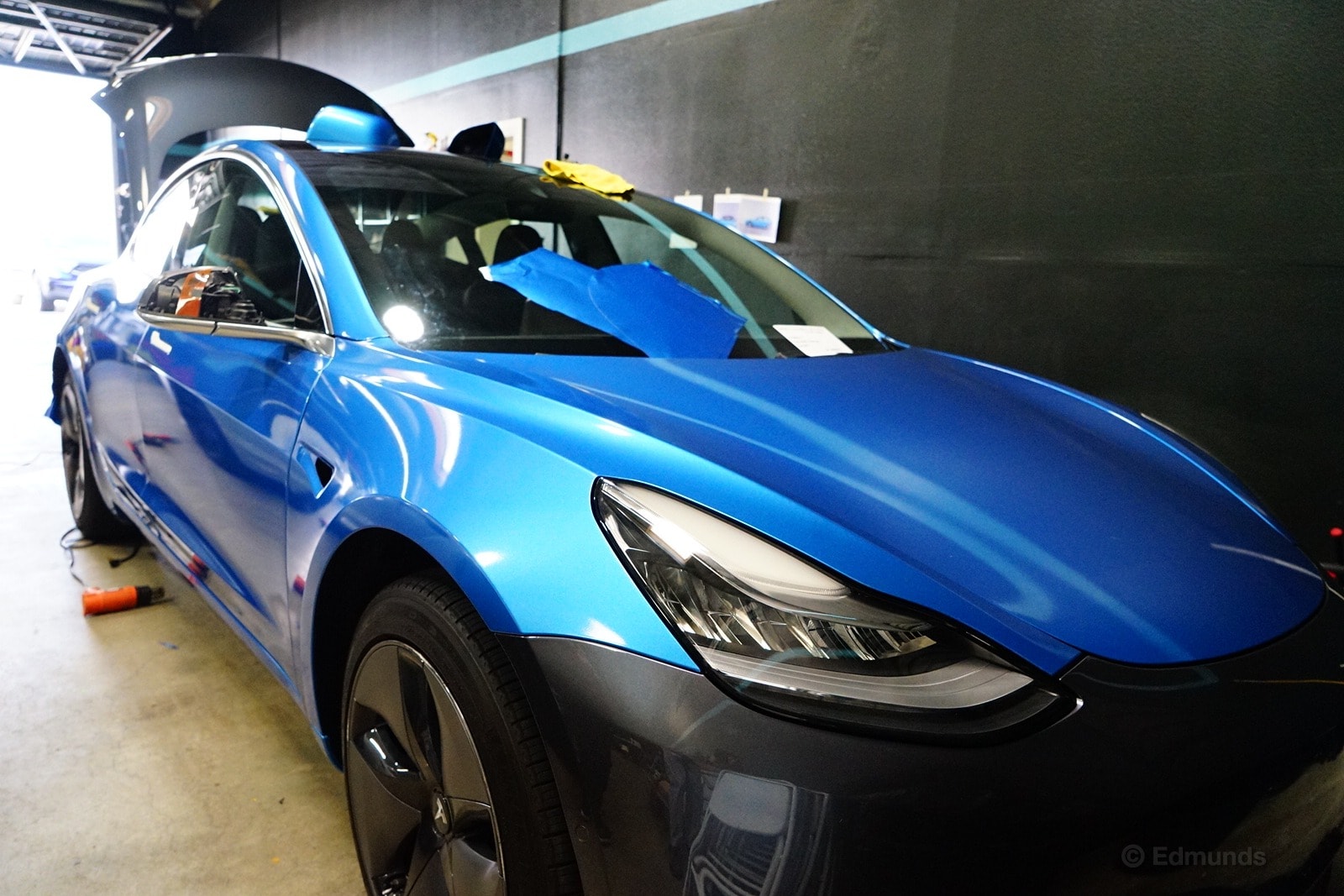
Monthly Update for November 2018
Where Did We Drive It?
The constant string of software updates regularly arriving to our long-term 2017 Tesla Model 3 means there's always something new to discover. One of the updates this month included Tesla's new Navigate on Autopilot feature, which claims, after the driver's consent, to be able to make lane changes and connect on freeway interchanges by itself. Dan Edmunds, our head honcho of vehicle testing around these parts, found the system doesn't live up to its promise.
Also, the new exterior design seems to suit our Model 3. We might make some adjustments, but it's nice to see something other than gray on the exterior.
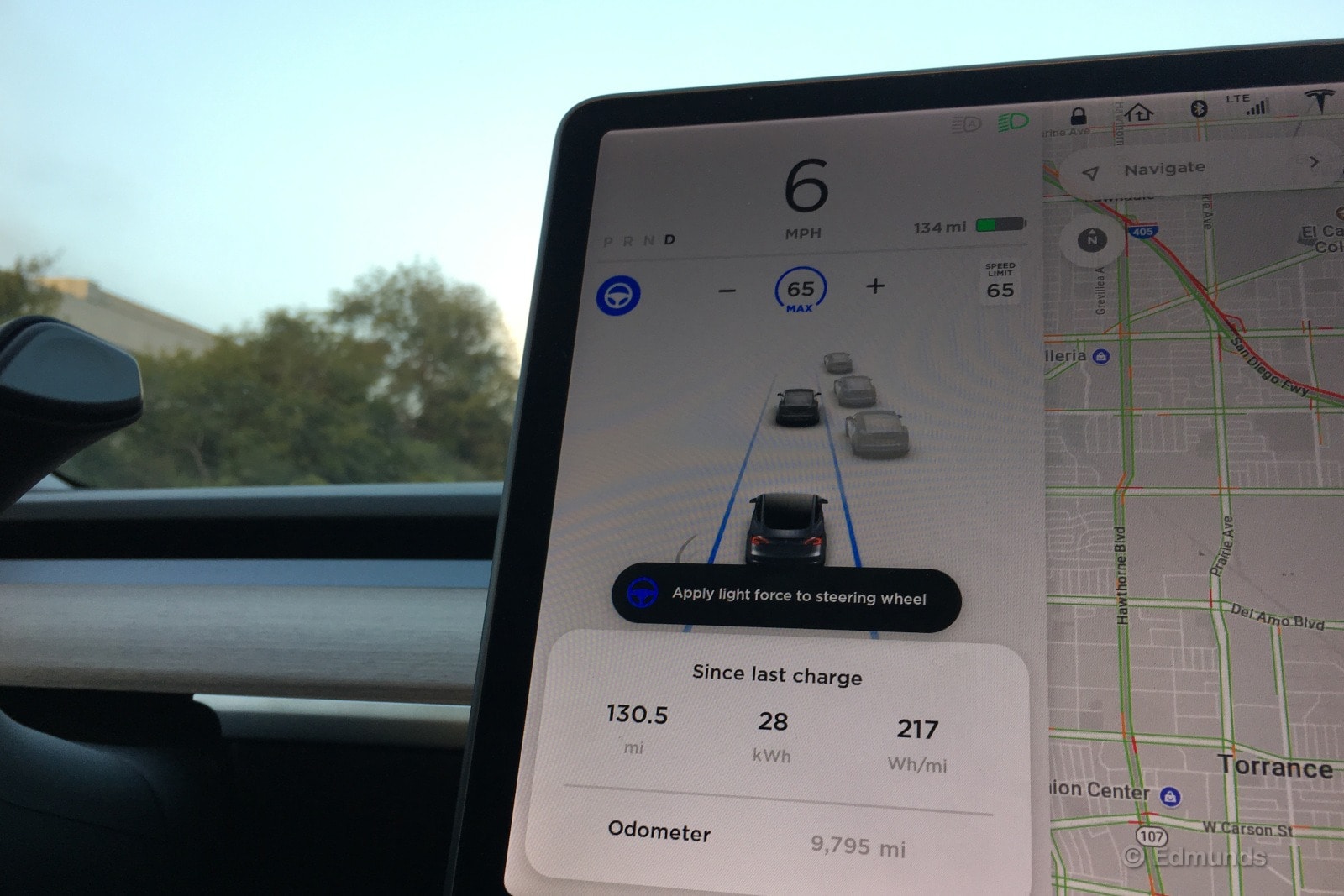
What Kind of "Fuel Economy" Did It Get?
The Model 3 traveled 800 miles this month and was charged nine times, with an average trip of 89 miles. Energy consumption figures didn't change versus last month, and our lifetime 30.8 kWh/100 miles average still trails the EPA rating somewhat.
Average lifetime consumption: 30.8 kWh/100 miles (109.3 mpge)
EPA consumption rating: 27 kWh/100 combined miles (126 mpge)
Best fill consumption: 25.6 kWh/100 miles (131.5 mpge)
Best range: 204.7 miles
Current odometer: 11,973 miles
Other fun facts:
Best onboard consumption meter reading (aka "The Featherfoot Award"): 177 Wh/mi
Worst reading (aka "The Leadfoot Award"): 570 Wh/mi
Average meter reading: 244.7 Wh/mi
Maintenance and Upkeep
None.
Logbook Highlights
Technology
"It's early days, but my initial impression of the new Navigate on Autopilot feature is it deserves a big thumbs-down. This feature allows the car to suggest lane changes to follow a route, and it will navigate through freeway interchanges if the driver allows it to change into the proper lane by acknowledging the car's request by clicking on a turn signal. But there are many problems.
"It reacts badly if you don't take its lane change suggestions when they're not necessary. An interchange may not be coming up for miles and traffic might be light, but it seems to want to get you into the fast lane regardless. I'm more than happy to stay in the middle or right-hand lane to keep the left lanes open for those who may want to go faster. I hate it when drivers camp out in the left lane. Also, it seems to be unaware that HOV lane access in L.A. is restricted to certain small zones. On many occasions, it directed me to get in when there were no legal openings.
"If you ignore such a request too long, the car reacts by slowing down quite a bit and in a fairly sudden way that irritates following drivers. I've had it slow to 45 mph with cars behind before I got scared by what it was doing and took over.
"Also, it generally seems more nervous and jumpy even when no changes are in the works for miles and miles. Regular Autopilot feels confident (overconfident, I would say), but Autopilot running under the Navigate on Autopilot feels like a paranoid student driver. It overreacts to non-events. All in all, I have zero confidence in it.
"I don't think it should be in the hands of the public, quite frankly. It feels dangerously underdeveloped. And I'm not willing to be a guinea pig unless I'm drawing a salary from Tesla. Seriously, this should not be on public roads. Tesla calls it beta, but that's a cop-out. That status only proves my point. Autosteer — the marquee component of regular Autopilot — has been beta for four years. It's not perfect either, but Navigate on Autopilot is really sketchy. Beta is OK for a phone but not for a car." — Dan Edmunds, director, vehicle testing
MPG
"I love having the range meter that was a staple in the Model S and Model X. The new operating system finally brought this to the Model 3. It may actually improve the efficiency of drivers who choose to view it, but that remains to be seen. I know I get sucked into the gamification that comes with giving the driver a lot of clear instant feedback on driving efficiency The Model 3 never had that before." — Dan Edmunds
Monthly Update for December 2018 and January 2019
Where Did We Drive It?
This update marks a year of ownership of our 2017 Tesla Model 3. Over the past 12 months, we've covered just less than 15,000 miles and experienced in the process a number of highs and lows.
How did we commemorate its first anniversary? Quietly. Senior Consumer Advice Editor Ron Montoya took it on a quick trip to Las Vegas and back. Doing so allowed him to experience the navigation system's planning capabilities and the tendencies of the so-called Autopilot. He also noticed a bit of condensation inside one of the taillights during a rainy day in Los Angeles, which is somewhat of a concern for a car that's just a year old.
What Kind of Energy Consumption Did It Get?
Our Model 3 racked up 2,652 miles in December and January through a mix of local commuting and one long-distance drive to Las Vegas. We logged some solid "tanks" in the process. Some beat the EPA's 27 kWh/100 miles rating and one even neared the 25.6 kWh/100 miles best we recorded last January. Still, it wasn't enough to significantly affect lifetime consumption.
Average lifetime consumption: 30.7 kWh/100 miles (109.8 mpge)
EPA consumption rating: 27 kWh/100 combined miles (126 mpge)
Best fill consumption: 25.6 kWh/100 miles (131.5 mpge)
Best range: 204.7 miles
Current odometer: 14,796 miles
Other fun facts:
Best onboard consumption meter reading (aka "The Featherfoot Award"): 177 Wh/mi
Worst reading (aka "The Leadfoot Award"): 570 Wh/mi
Average meter reading: 243 Wh/mi
Maintenance and Upkeep
None.
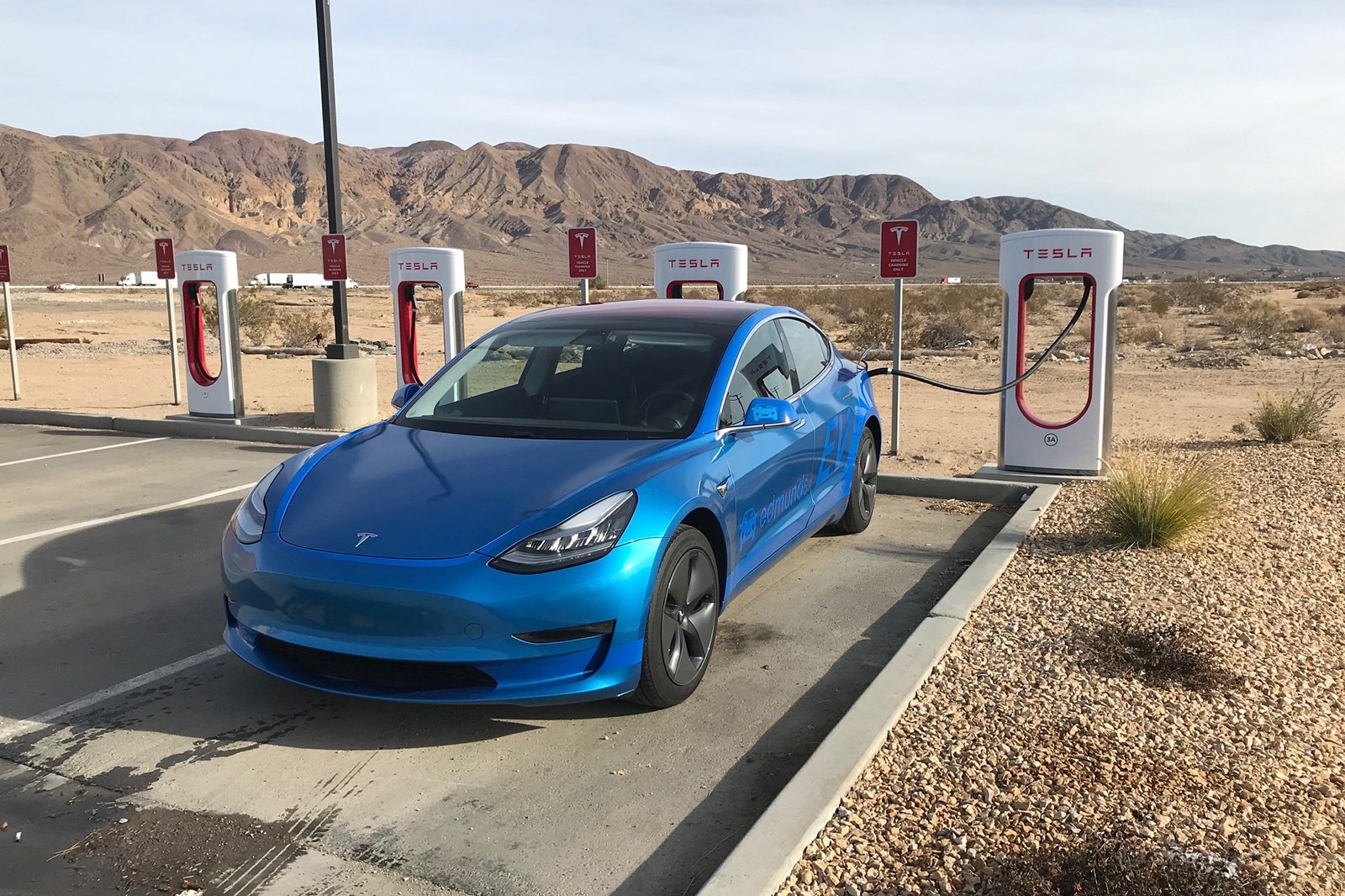
Logbook Highlights
Technology-Audio
"I was talked into taking the Model 3 to Vegas, and I learned quite a bit in the process. Tesla's navigation does all the planning for you. It factors in where you need to stop along the way to get a charge and even estimates the percentage of remaining battery life when you arrive at the charging station and final destination. I left home with about 200 miles of range, made one 30-minute stop in Yermo, California, then arrived in Vegas with about 95 miles of range remaining.
"On the return trip, I needed two charges. The nav system initially calculated that I would arrive home with about 10 percent charge. It assumed I'd have something to charge with on my end. But since I can't charge at my apartment, I stayed about 15 minutes longer at each of the charge stations. I not only needed to make it home but also needed to have enough range to make it to work the next morning. I arrived at the office with about 115 miles of range remaining, so I definitely erred on the side of caution.
"I'm not sold on Tesla's Autopilot. It requires you to keep your hands on the wheel. But if you hold the wheel too hard, the system will deactivate. It sits a little too close to the left lane for my comfort but doesn't allow me to adjust it. If you activate the turn signals, it will change lanes automatically, which is impressive. But you still need to monitor it because it freaked out when it drove over some Botts' dots and then asked me to take over immediately. With all this monitoring, I preferred to man the wheel myself and use the old-fashioned cruise control." — Ron Montoya, senior consumer advice editor
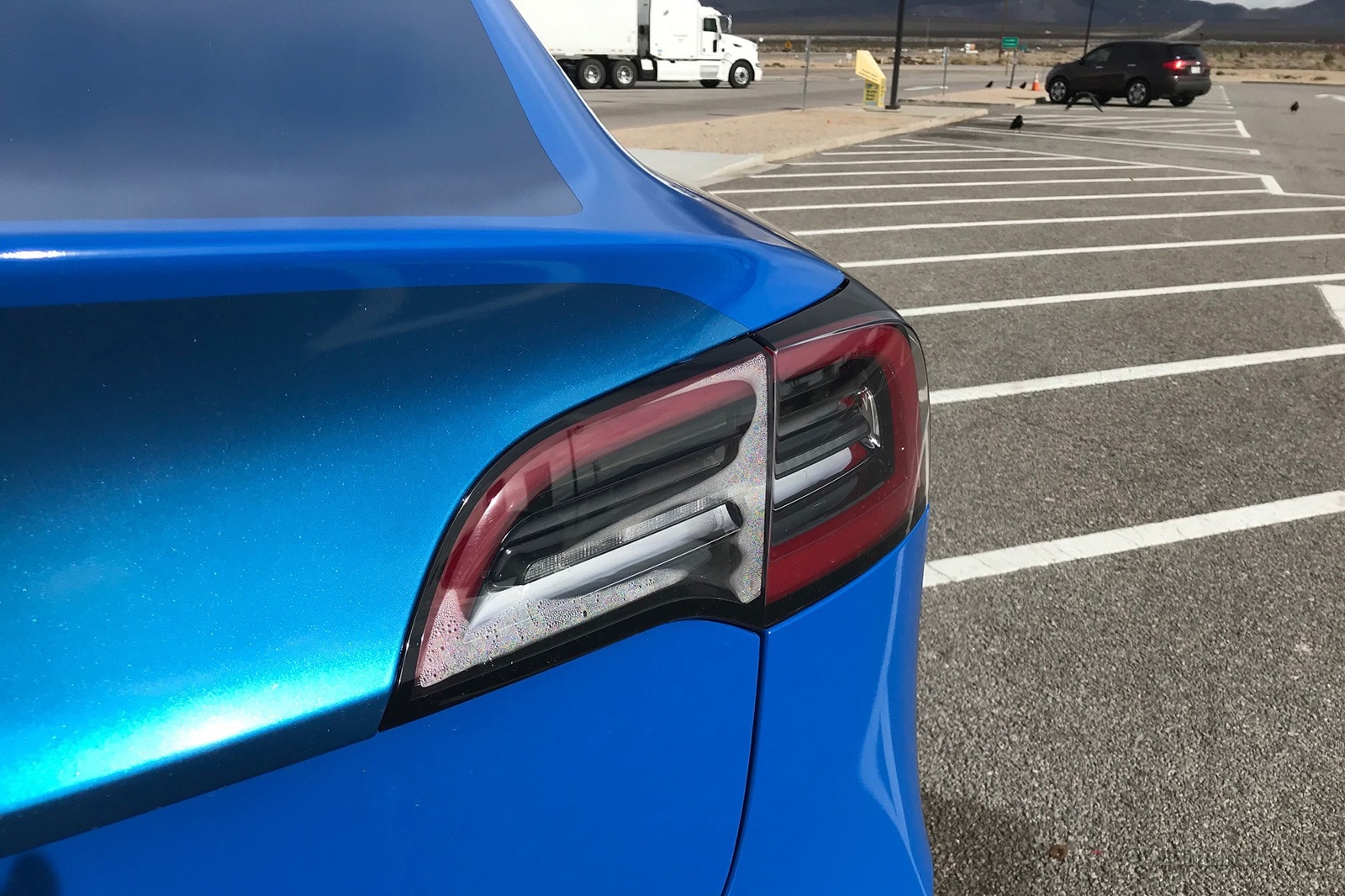
Miscellaneous
"It's been rainy recently, and I noticed that the right taillight on our Model 3 had some condensation on the inside. I expect to see something like this on an older vehicle, where the seals have dried out, but not on a 1-year-old car. It's small build-quality issues like this that give me pause when asked to recommend a Tesla." — Ron Montoya
"Our bright blue vinyl wrap gets a lot more attention than the boring gray we had before. It causes people to do double-takes and while at a Supercharger station, I had one Model X owner ask 'What's Edmunds?' I like the color quite a bit, but I'd skip the graphics if it were my car." — Ron Montoya
Monthly Update for February and March 2019
Where Did We Drive It?
Our long-term 2017 Tesla Model 3 now has an electronic fart sound generator. And that means the most significant thing that happened in the past two months with our Model 3 had little to do with actually driving it.
In December last year, our car received an "Emissions Testing Mode," which is a fancy name for an electronic whoopee cushion built into the Tesla's entertainment system. When enabled, you can select from an array of fart sounds and how they're triggered, whether it's every time you hit the turn signal or manually with a button on the steering wheel. It's endlessly amusing.
The same goes for the Atari emulator that allows you to play classic games such as Missile Command and Centipede on the center screen when parked. Weirdly, there was a modified version of the racing game Pole Position where you could even use the steering wheel and brake pedal. Even weirder, the car you drove in the racing game was a Model 3 that had an engine sound. (Note: This specific game was removed in an over-the-air update. Tesla CEO Elon Musk said in a tweet, "Couldn't resolve all the rights issues. Will add another racing game soon.")
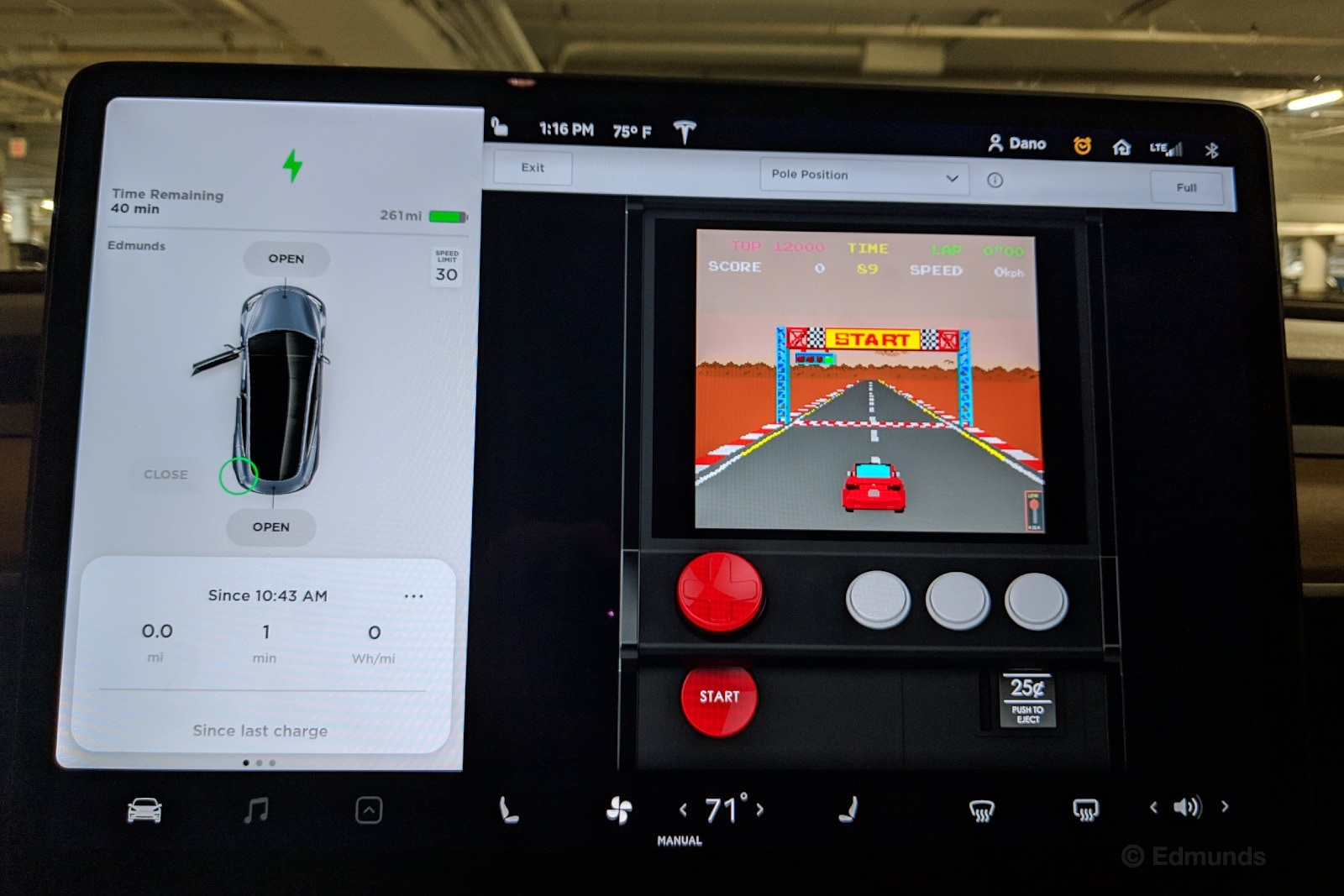
What Kind of "Fuel" Economy Did It Get?
When we weren't playing Atari or making fart noises, we covered around 1,600 miles in February and March. We made two stops at Tesla Supercharger stations, while the remainder of charging happened at Edmunds headquarters. Energy consumption remained at 30.7 kWh/100 miles, which is still off the EPA's 27 kWh/100 mile rating.
Average lifetime consumption: 30.7 kWh/100 miles (109.8 mpge)
EPA consumption rating: 27 kWh/100 combined miles (126 mpge)
Best fill consumption: 25.6 kWh/100 miles (131.5 mpge)
Best range: 204.7 miles
Current odometer: 16,447 miles
Other fun facts:
Best onboard consumption meter reading (aka "The Featherfoot Award"): 177 Wh/mi
Worst reading (aka "The Leadfoot Award"): 570 Wh/mi
Average meter reading: 241.6 Wh/mi
Maintenance and Upkeep
None.
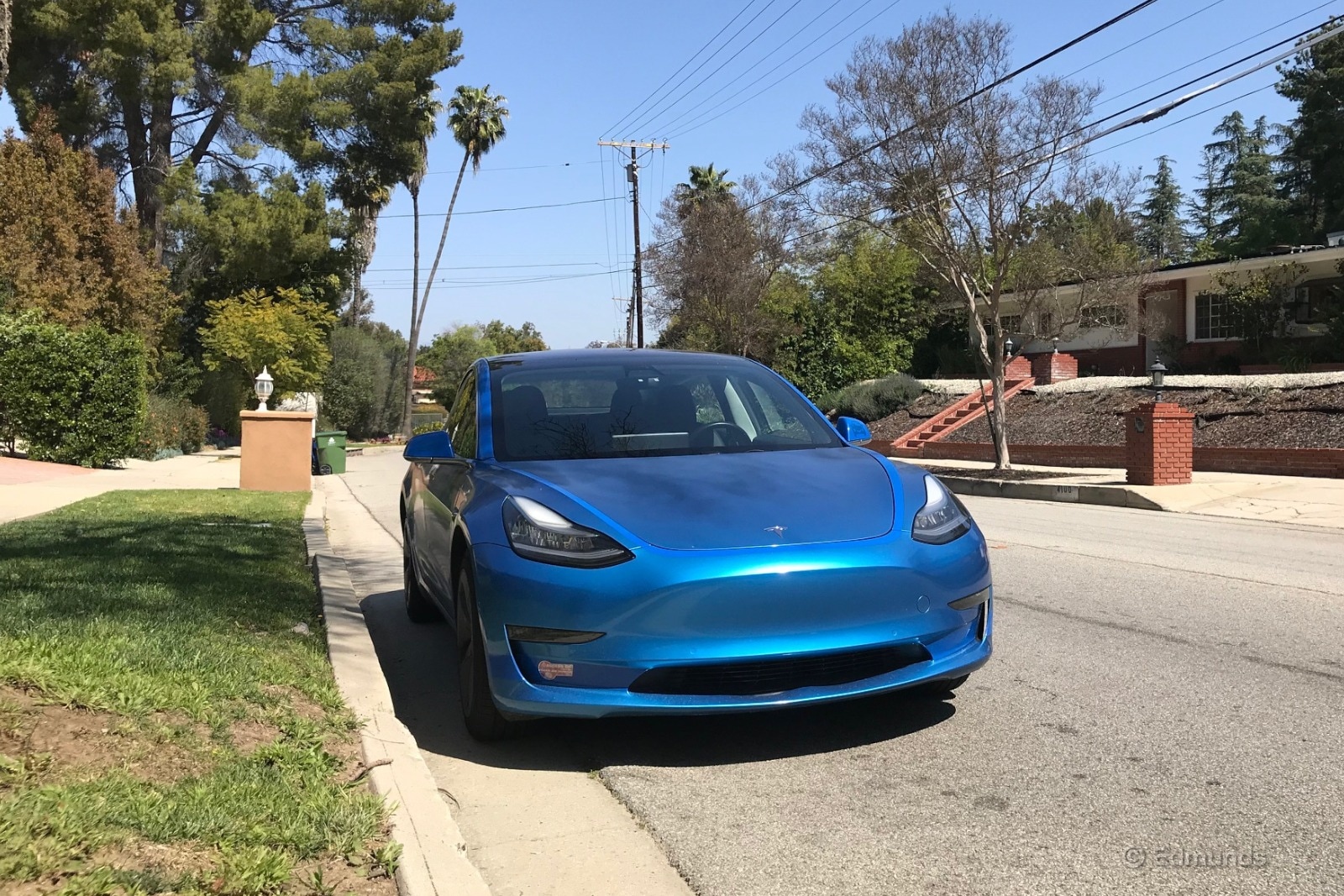
Logbook Highlights
Maintenance
"I don't want to jinx it, but it has been roughly 10 months since our Model 3 had to visit the dealership — perhaps the longest problem-free streak we've ever had in a Tesla. The reliability has improved with each Tesla model we've owned. Our Model 3 visited the dealer three times in just over a year of ownership, which is still well above average but roughly half the dealer visits of our previous Model X." — Ron Montoya, senior consumer advice editor
Comfort
"This car rides too rough for my tastes. You feel every crack and imperfection in the road. I drove this back to back with our Chevy Bolt, and the Bolt was far more comfortable to me for daily driving. I get that this car has sporty intentions, but most people are driving these cars in cities full of potholes rather than winding mountain roads." — Ron Montoya
Technology-Audio
"I've used several manufacturers' apps for loaned cars, but I don't find many of them useful. It's cool that you can precool or preheat the cabin and remotely unlock the doors, but most of the other functions aren't necessary. Even worse, manufacturers view these services as another source of revenue, and I'm not sold on paying hundreds of dollars per year for the privilege.
"That said, I love Tesla's app. It does the things I primarily use the other apps for — checking where I parked it, preconditioning the cabin and remotely heating the windshield to melt the ice off (yes, it was cold enough in L.A. this winter to need to do this in the morning). Because I don't have a charging port at my house, I have to charge the Model 3 at a public charging station. The app also displays the current range and estimated time of completion, which helps massively when I'm structuring my time around charging the car. Best of all, the Tesla app is free." — Cameron Rogers, reviews editor
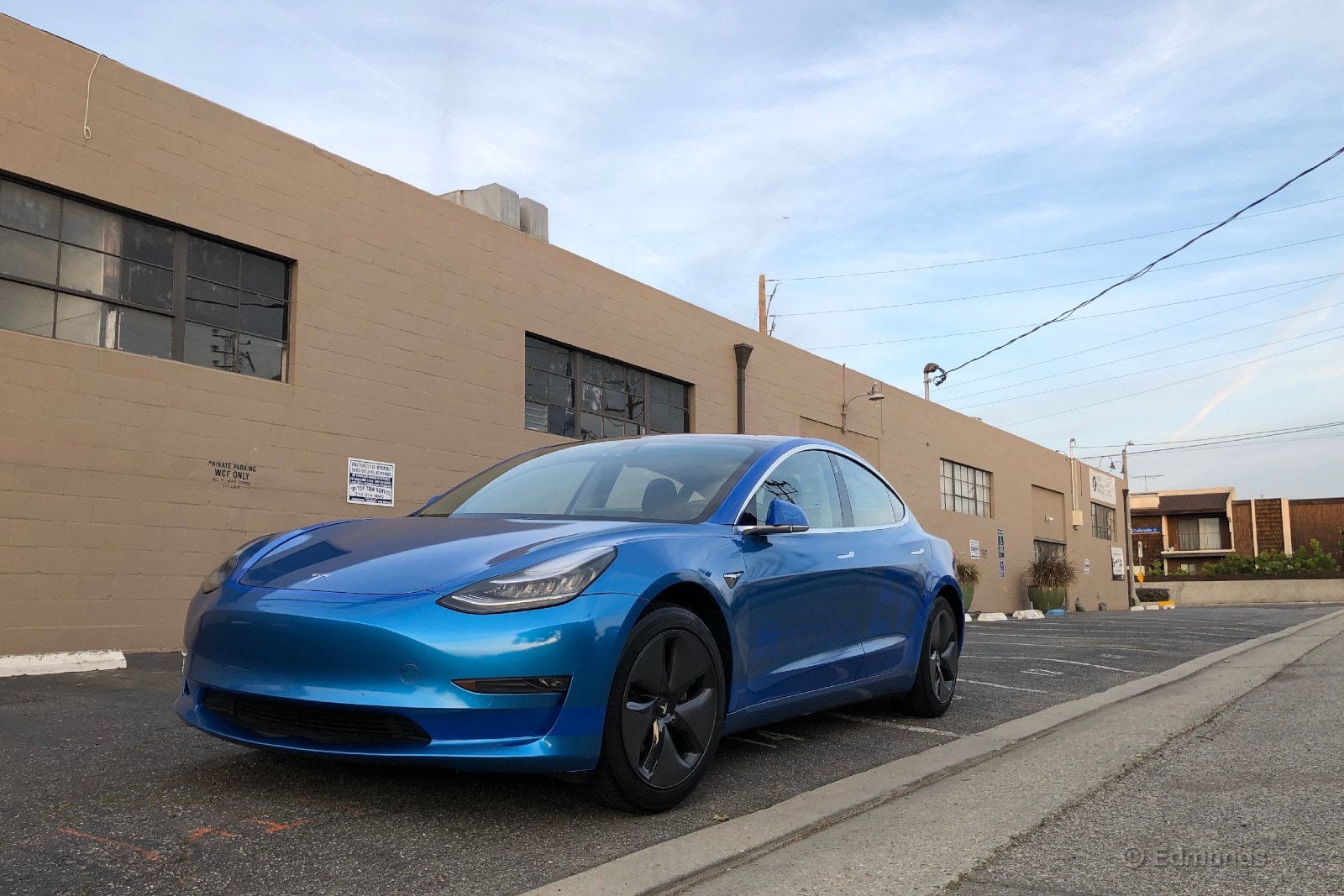
Monthly Update for April 2019
Where Did We Drive It?
There was a curious note in the most recent over-the-air update for our long-term 2017 Tesla Model 3. It read: "Your vehicle's peak power has increased by approximately 5%." Eager to see what that meant, we headed to our test track with our VBOX data logger. You can watch our video of the test here.
After crunching the numbers, we were surprised to find that, indeed, our Model 3 is now quicker. When we first tested it back in January 2018, it did 0-60 mph in 5.3 seconds (4.9 seconds if you include a 1-foot rollout, like you would at a drag strip or similar to how enthusiast car magazines test). It did the quarter-mile in 13.6 seconds at 102.1 mph.
After the performance-enhancing update, our Model 3 ran 0-60 mph in 5.0 seconds (4.7 seconds with a 1-foot rollout) and the quarter-mile in 13.5 seconds at the same trap speed.
This performance improvement was free, so we're pretty happy with our Model 3 right now.
On another note, we removed the blue wrap. Doing so cost around $300 and only took a few hours. We're happy to have the exterior back to stealth, which is the way most of us prefer. The front and rear badges came off as well, but we might just leave it like that. Most cars look better without badges anyway.
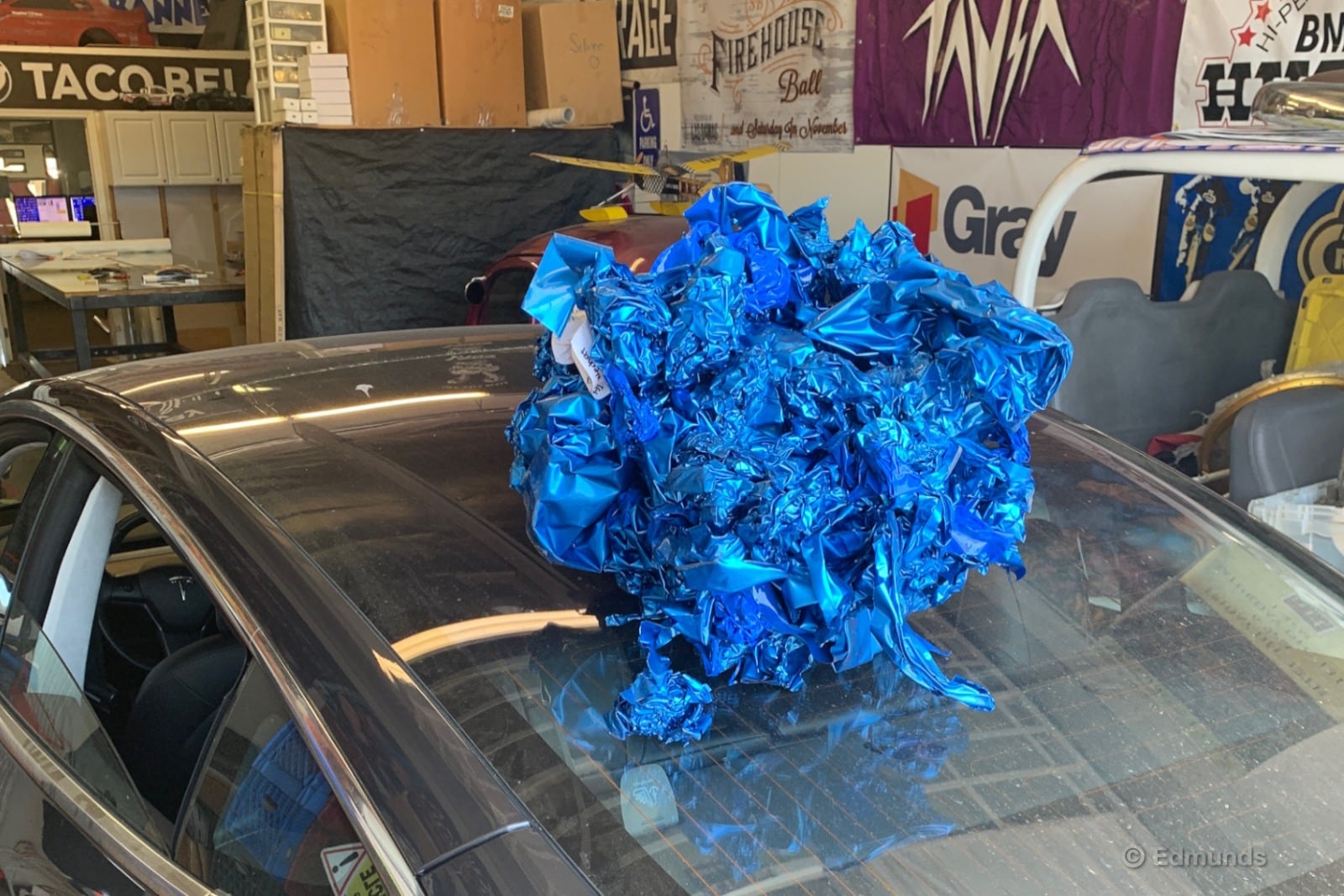
How Much Electricity Did It Use?
Not only is our Model 3 more powerful, but it also goes farther on a charge. The over-the-air performance increase also improved maximum range from 310 miles to 335 miles. We usually charge to 90%, around 290 miles now.
Because you seldom drive an electric vehicle until it's out of juice, we likely won't challenge this new range estimate during normal driving; we average just over 100 miles between charges. We'll watch to see if that figure creeps up as a result of staffers not feeling the need to charge as frequently.
Average lifetime consumption: 30.7 kWh/100 miles (109.8 mpge)
EPA consumption rating: 27 kWh/100 combined miles (126 mpge)
Best fill consumption: 21.7 kWh/100 miles (131.5 mpge)
Best range: 217.2 miles
Current odometer: 17,875 miles
Other fun facts:
• Best onboard consumption meter reading (aka "The Featherfoot Award"): 177 Wh/mi
• Worst reading (aka "The Leadfoot Award"): 570 Wh/mi
• Average meter reading: 241.6 Wh/mi
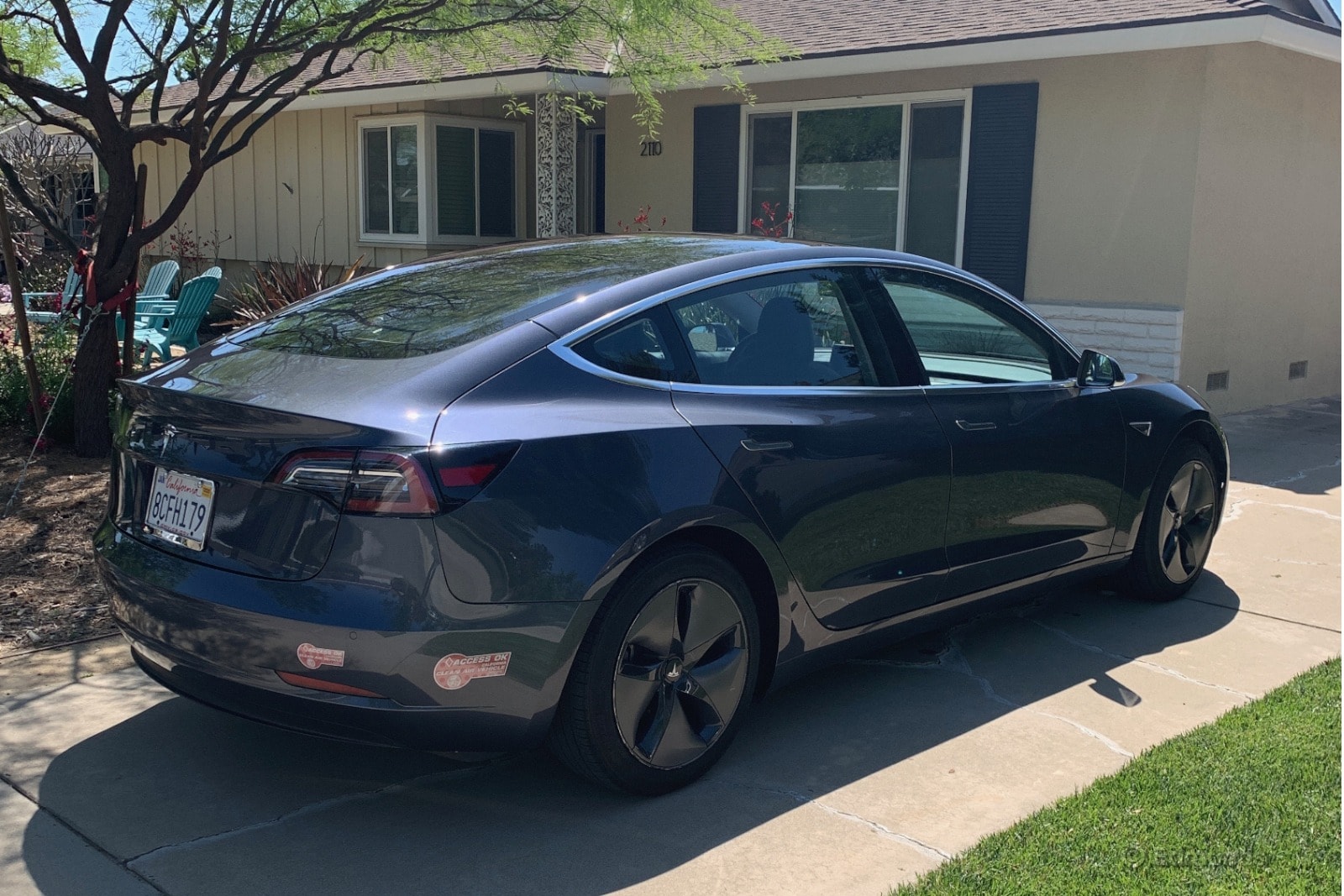
Maintenance and Upkeep
None.
Logbook Highlights
Technology
"Admittedly, it has been a while since I drove our Model 3, and there have been at least two software updates since that time. While over-the-air updates are a great feature, it takes a little bit of time to reacclimate because readouts and info (trip info, wiper controls) have either been added or moved around." — Rex Tokeshi-Torres, vehicle testing technician
• • • • • • • • • •
"I think I've been leaving the Model 3's doors unlocked for over a year. The thing is, all the Teslas we've owned have a 'walk away to unlock' feature. Our Model 3 has that, too, but it must be paired with a smartphone. We often use the physical keycard to access the vehicle since we have so many drivers on staff.
"I was fine with using the keycard, so I never bothered to pair my phone. In this scenario, it needs to be locked by tapping the card on the driver's side door pillar. You cannot unlock the car from the passenger side with the keycard, so if you want to score some chivalry points on a date, take the time to pair your phone." — Ron Montoya, senior consumer advice editor
• • • • • • • • • •
"Fans of the Model 3 praise it for being such a 'high-tech' vehicle, but here's my take: A big touchscreen does not equal high-tech. Nearly every control in this car involves the driver taking their eyes off the road, which is not safe. In other cars, I can do things such as adjust the fan speed, turn on my lights, activate the wipers, all by feel.
"Many automakers learned this lesson years ago and have since re-added physical controls for a number of features. Then there's the Model 3's lack of Android Auto and Apple CarPlay. Smartphone connectivity is the best way to get drivers to put down their phones while driving and a truly high-tech way of integrating your smartphone in your vehicle." — Ron Montoya
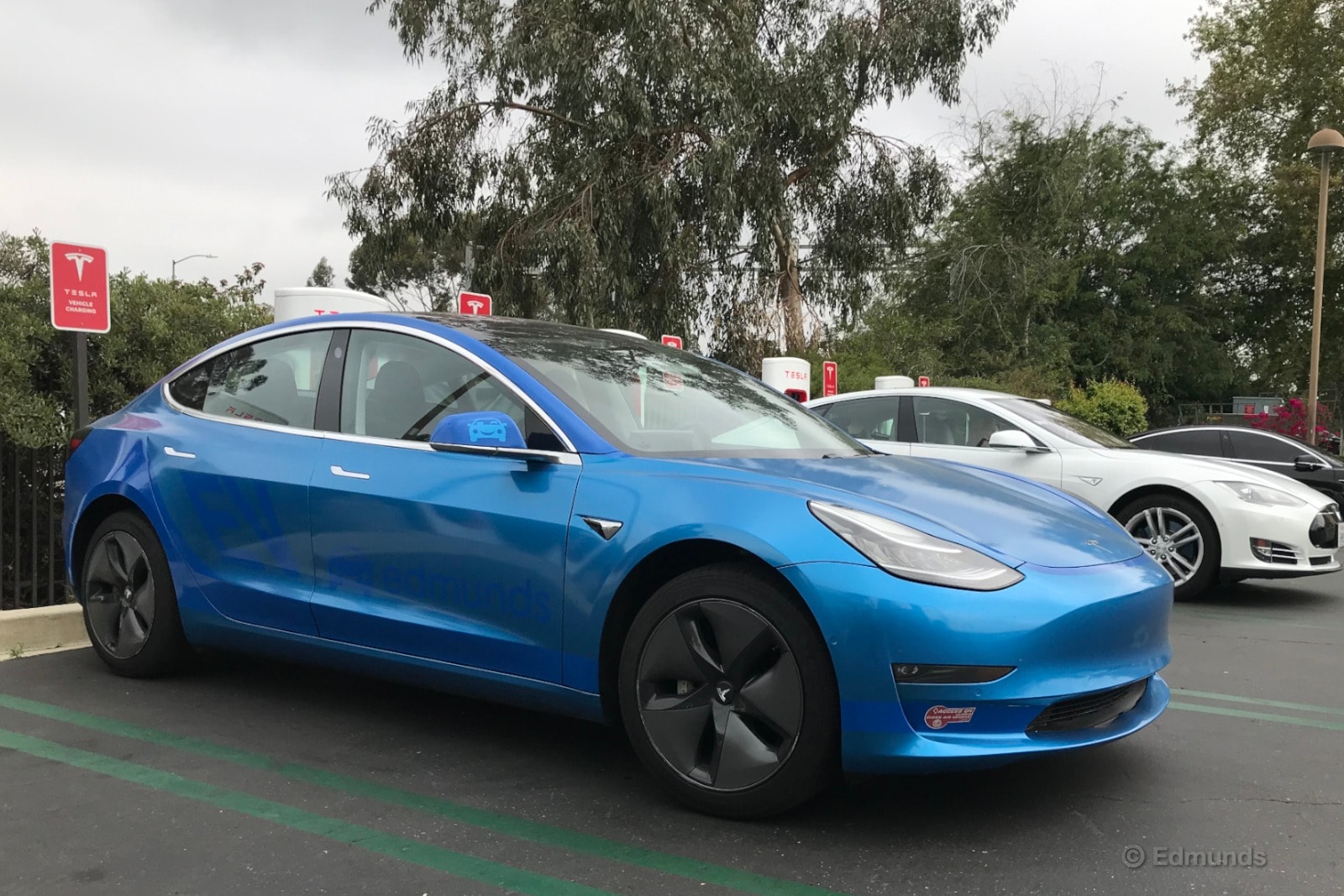
Monthly Update for May 2019
Where Did We Drive It?
After its performance-improving update last month, our long-term 2017 Tesla Model 3 had a relatively quiet May. Thanks to this lull we were able to give a long overdue look at the dashcam Tesla added in an over-the-air update late last year.
Setting it up couldn't be easier. Grab a USB thumb drive and create a folder on it called "TeslaCam." Plug it into one of the Model 3's USB ports, and that's it. If everything's working right, a small camera icon with a red dot appears on the top right of the entertainment display to indicate the cameras are recording. There are three: one forward facing and two looking rearward from the front fenders.
Tapping this icon saves the previous 10 minutes of video in a specific folder within the TeslaCam folder on your thumb drive, making it easy to log hilarious displays of driving ineptitude from fellow motorists or potential evidence if you've been in an accident. All you have to do afterward is pull the thumb drive.
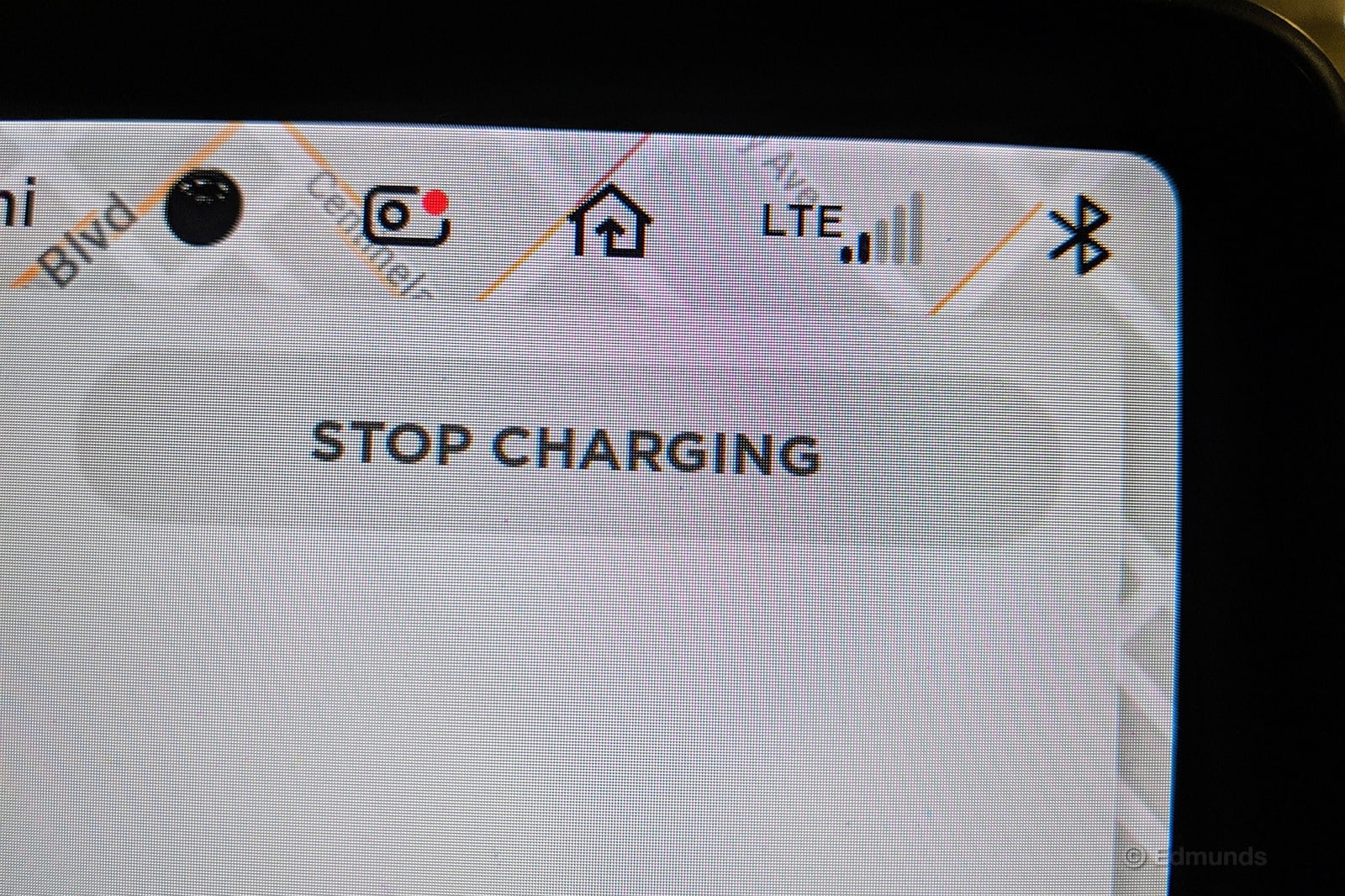
What Kind of Fuel Economy Did It Get?
Our Model 3 traveled just over 480 miles this month and was charged seven times. As reported in last month's update, our newly improved 290-mile range (on Tesla's recommended 90% charge) has yet to impact our driving habits. The nature of the commutes of most staffers combined with how frequently we swap cars means we seldom plug it in with more than 100 miles showing on the trip.
Average lifetime consumption: 30.7 kWh/100 miles (109.8 mpge)
EPA consumption rating: 27 kWh/100 combined miles (126 mpge)
Best fill consumption: 21.7 kWh/100 miles (131.5 mpge)
Best range: 217.2 miles
Current odometer: 18,485 miles
Other fun facts:
- Best onboard consumption meter reading (aka "The Featherfoot Award"): 177 Wh/mi
- Worst reading (aka "The Leadfoot Award"): 570 Wh/mi
- Average meter reading: 240.5 Wh/mi
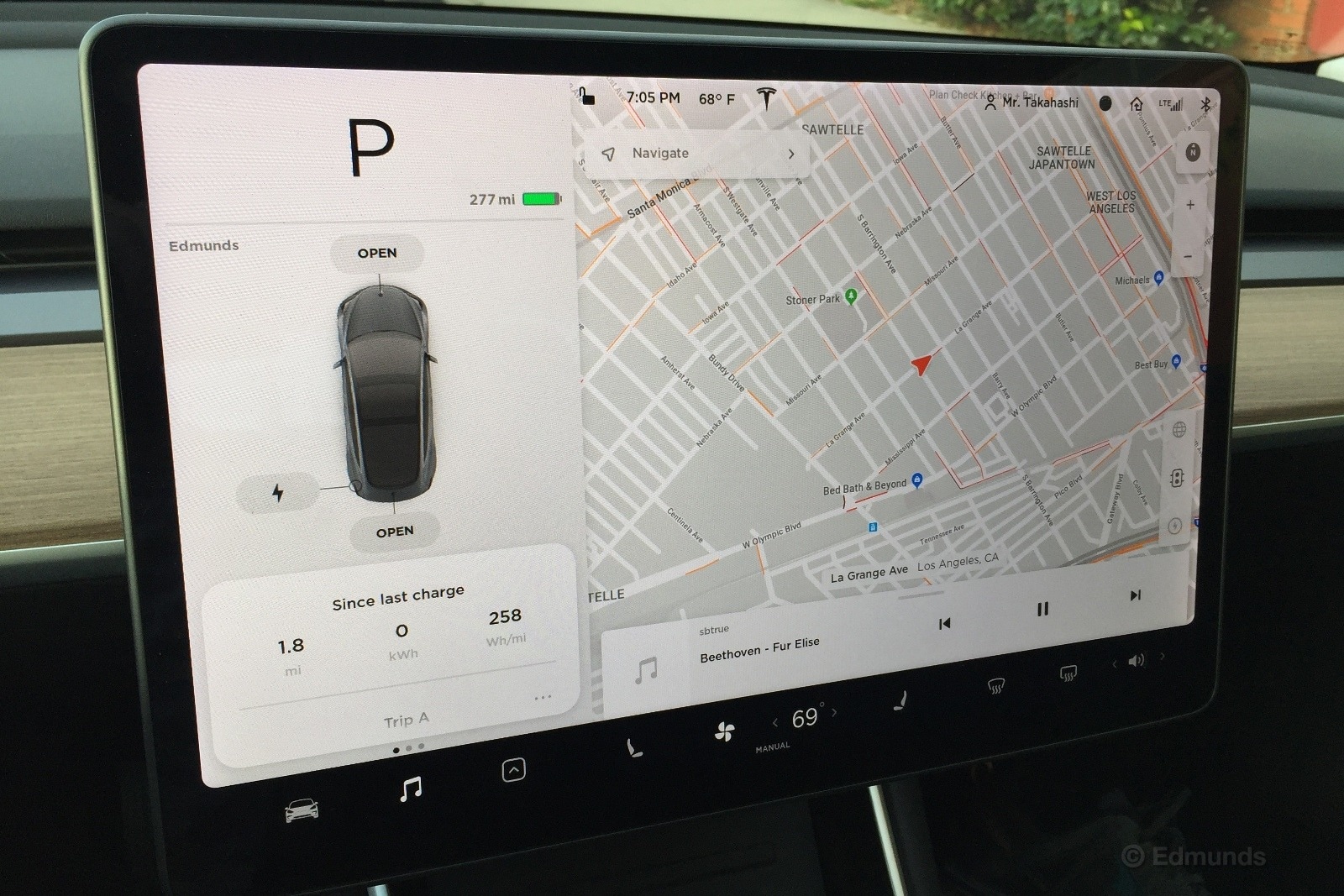
Maintenance and Upkeep
None.
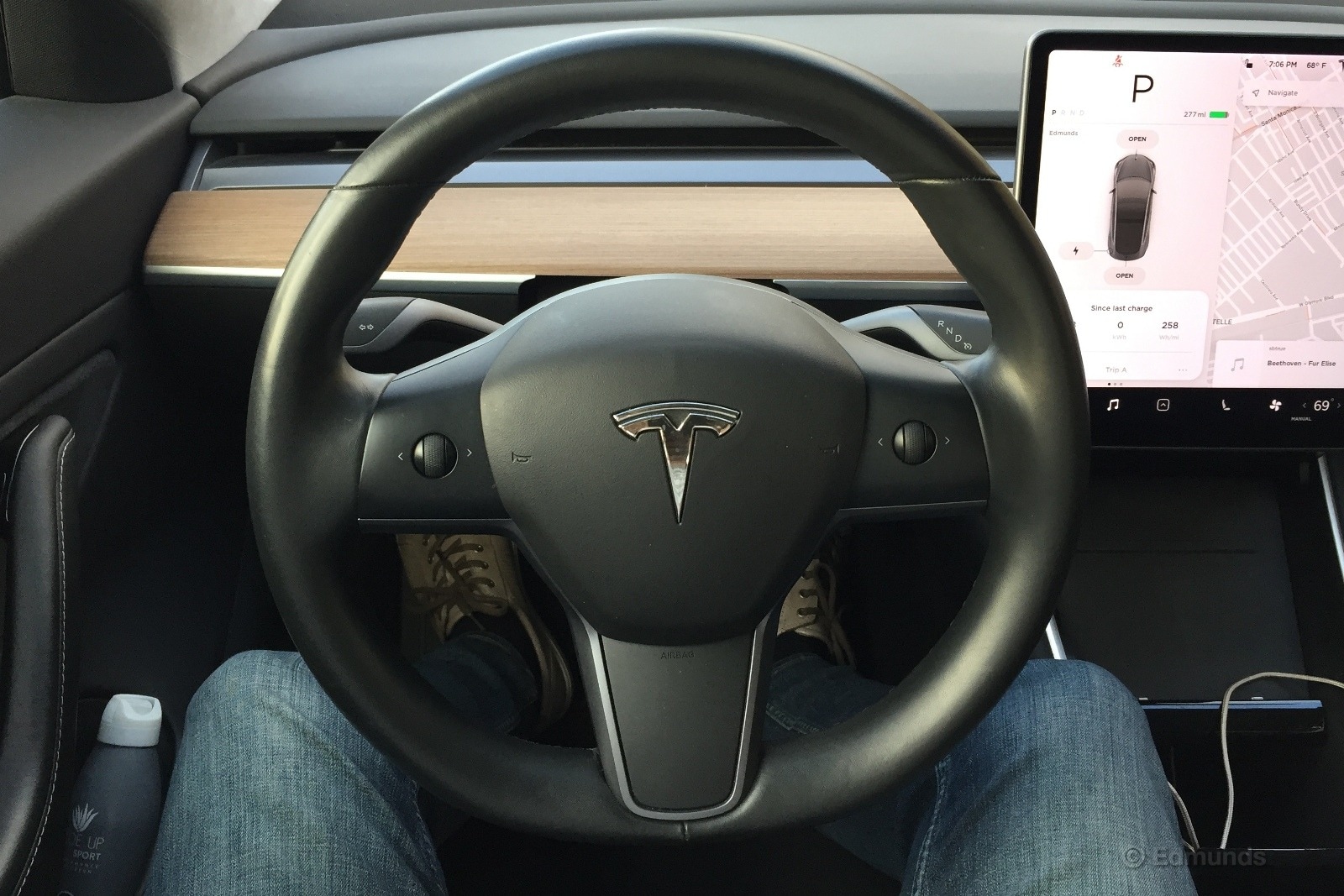
Logbook Highlights
Interior
"I love the steering wheel in our Model 3. It might be my favorite steering wheel in any car today. It's engagingly small in diameter, while the 9-and-3 grips are super thick and sized just right for my palms. Makes me think of an old arcade game such as RoadBlasters, where the wheel's sportiness was exaggerated beyond anything you'd find in an actual car. Tesla puts such a wheel into a mass-market consumer vehicle as standard equipment — you don't even have to upgrade to a sport package or something. It's a perfect 10 in a category that doesn't get as much attention as it should." — Josh Sadlier, senior manager, content strategy
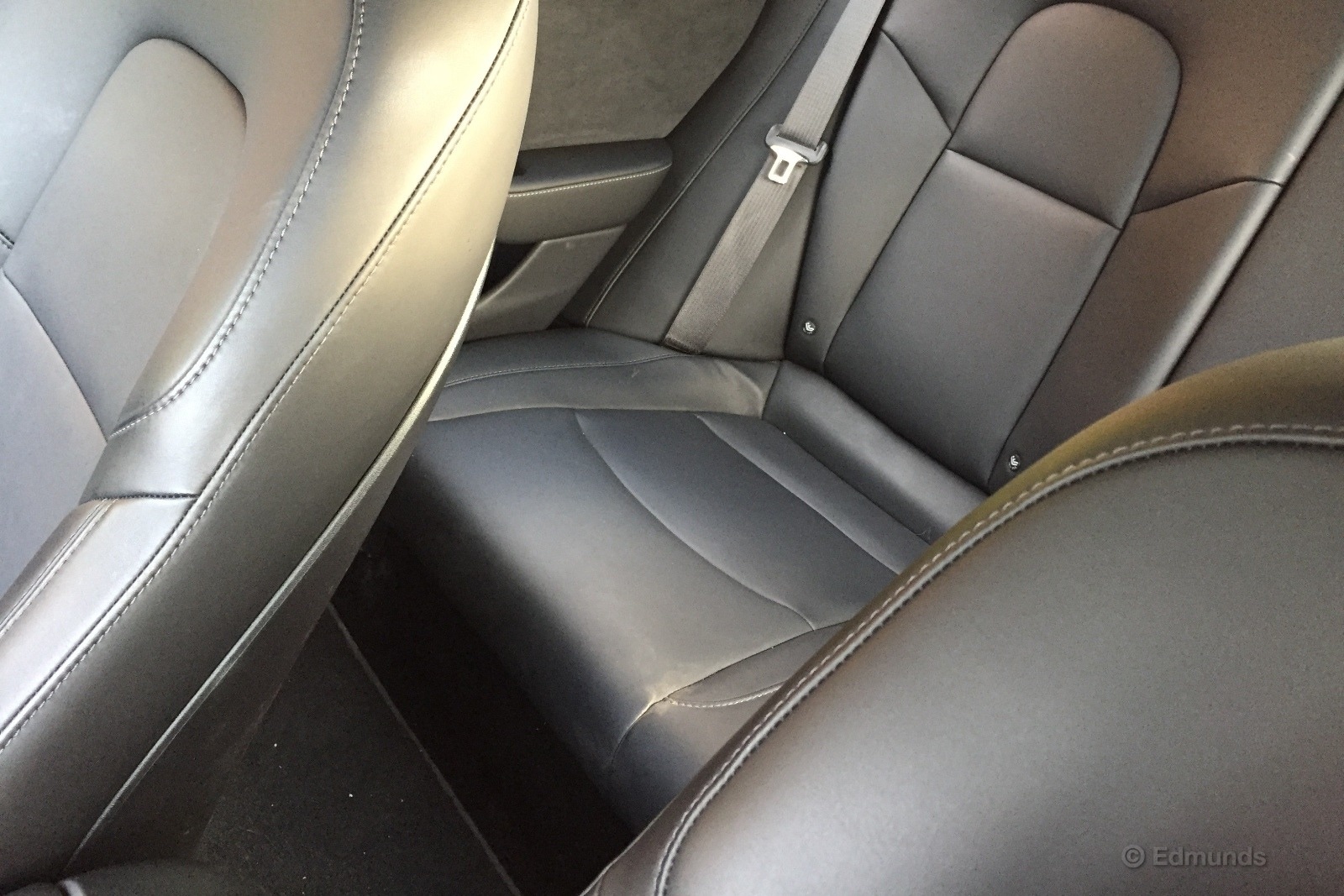
"The Model 3's back seat is an obvious weak spot, as my parents' recent visit underscored. They were generally gee-whiz amazed by the Model 3, but they were disappointed by the low-mounted rear bottom cushion and the lack of comfortable contours back there. Not much legroom either. As comfortable as the front seats are — I find them delightful — I'm surprised Tesla couldn't do a halfway decent job with the rear compartment. The Model 3 is at a distinct disadvantage versus well-rounded rivals such as the 3 Series in this regard."
— Josh Sadlier
Monthly Update for June 2019
Where Did We Drive It?
In April, our long-term 2017 Tesla Model 3 gained range. In June, our Model 3 lost it.
We track indicated range after a charge in an ever-growing spreadsheet. From the time we received our Model 3 in January 2018, until April this year, our car typically showed 279 miles after a 90% charge, which is Tesla's recommended level for normal use.
In April, after an over-the-air update, range increased as high as 293 miles. Performance improved, too. But since then, we've watched that figure drop back down into the low 280s.
To be sure, these are small changes (less than 5%), and we never drive that far between charging; our average is just over 100 miles on a "tank." But this gradual decrease is something we'll keep an eye on over the next few months. Stay tuned.
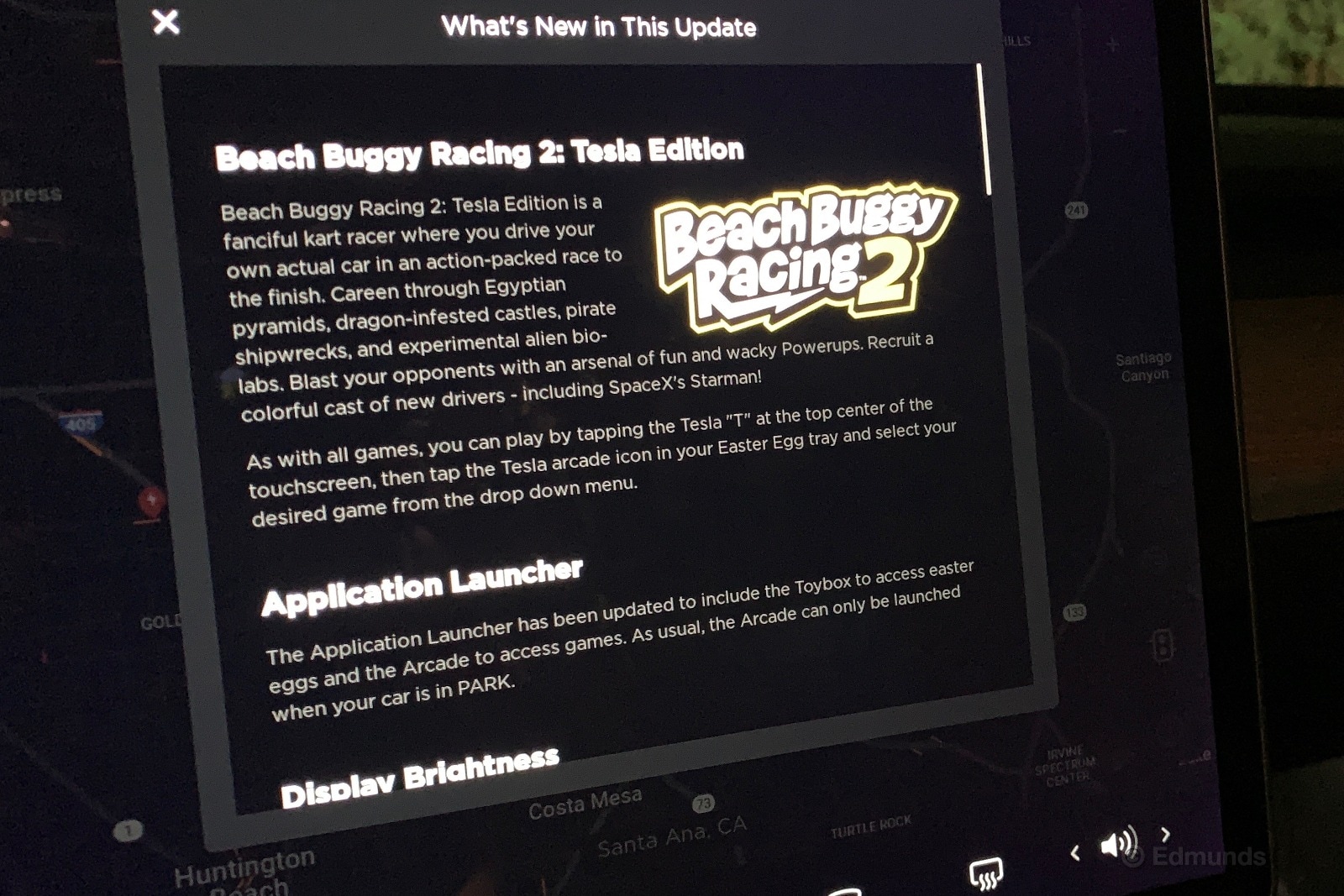
What Kind of "Fuel" Economy Did It Get?
Our Model 3 traveled just over 1,100 miles this month, and we charged it about nine times. There were no changes to the averages of driving range or energy consumption, nor were records set on highest range or best and worst readings. No movement means our consumption figures are pretty well settled. But that makes us wonder about the difference in our car's average consumption (30.7 kWh/100 miles) versus the EPA combined rating (27 kWh/100 miles). For comparison, our long-term 2017 Chevrolet Bolt is averaging 26 kWh/100 miles versus its EPA combined rating of 28 kWh/100 miles.
Average lifetime consumption: 30.7 kWh/100 miles (109.8 mpge)
EPA consumption rating: 27 kWh/100 combined miles (126 mpge)
Best fill consumption: 21.7 kWh/100 miles (131.5 mpge)
Best range: 217.2 miles
Current odometer: 19,596 miles
Other fun facts:
Best onboard consumption meter reading (aka "The Featherfoot Award"): 177 Wh/mi
Worst reading (aka "The Leadfoot Award"): 570 Wh/mi
Average meter reading: 240.5 Wh/mi
Maintenance and Upkeep
None.
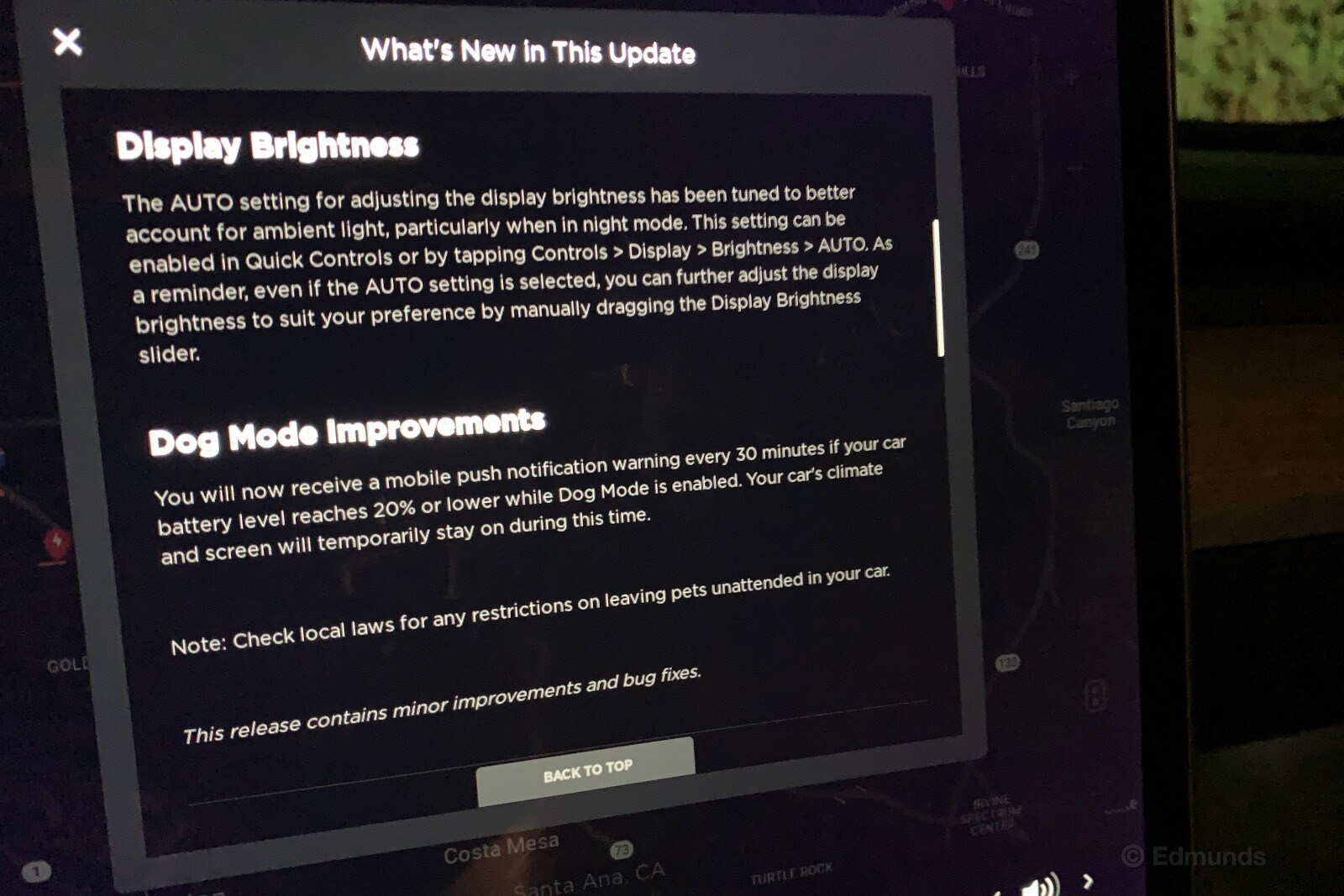
Logbook Highlights
MPG
"I'm tired of this. I am not able to match, let alone exceed, the Tesla's rated range. This flies in the face of every other EV. I've driven 334 miles in a Bolt, which is only rated at 238 miles. I've had similar (and frequent) range-busting results in the Leaf, the Volt, the Kona EV and many others. But never in a Tesla, be it an S, X or 3. And I'm driving the same commute.
"I'm thinking their ratings are overstated. Of course they are. Who else recommends that you set the battery to 90% full on a regular basis to save the battery? No one, that's who. It allows them to claim a certain range but recommend against operating the car that way. Meanwhile, our Bolt is proving such tactics aren't necessary. It just achieved its best-ever result after 2.5 years and nearly 30,000 miles." — Dan Edmunds, director of vehicle testing
Miscellaneous
"There's a lot of noise out there about Tesla. Negative noise. Schadenfreude, hater-ism, Elon's head on a platter — that sort of thing. On the one hand, I get it. The man himself is both a provocateur and at times seemingly unhinged, and when someone like that regularly picks up the Twitter megaphone, feverish reactions will follow.
"But now imagine if Ford Motor Co.'s early products had been judged on Henry's personal conduct, or Dodge's on that of the Dodge brothers. It's the classic ad hominem ('to the person') conflation of the people involved with the question at hand.
"As I see it, the question is whether the company builds great cars, and my answer is a resounding 'absolutely.' Yes, that includes the much-maligned-except-by-owners Model 3. This car is brilliant, folks. It's fast, nimble, confident. Seamless in operation. A sports car when you want it to be; a mindless grocery-getter when that's all you need. The interior is a study in zeitgeist luxury, all simple lines and understated tones and trendy wood that's probably called 'open-pore' by those in the know. The touchscreen control center is instantly familiar to all of us who have put in our 10,000 hours on the iPhone. The indicated 280-mile range on a normal full charge is an estimate you can trust.
"Of course the Model 3 was the best-selling luxury car of 2018 — it's an outstanding product at an appealing price, even if the $35K entry-level model never really materialized. Say what you will about Elon, but let's all say it together: Tesla is a true American success story when it comes to building compelling cars that customers want." — Josh Sadlier, director, content strategy
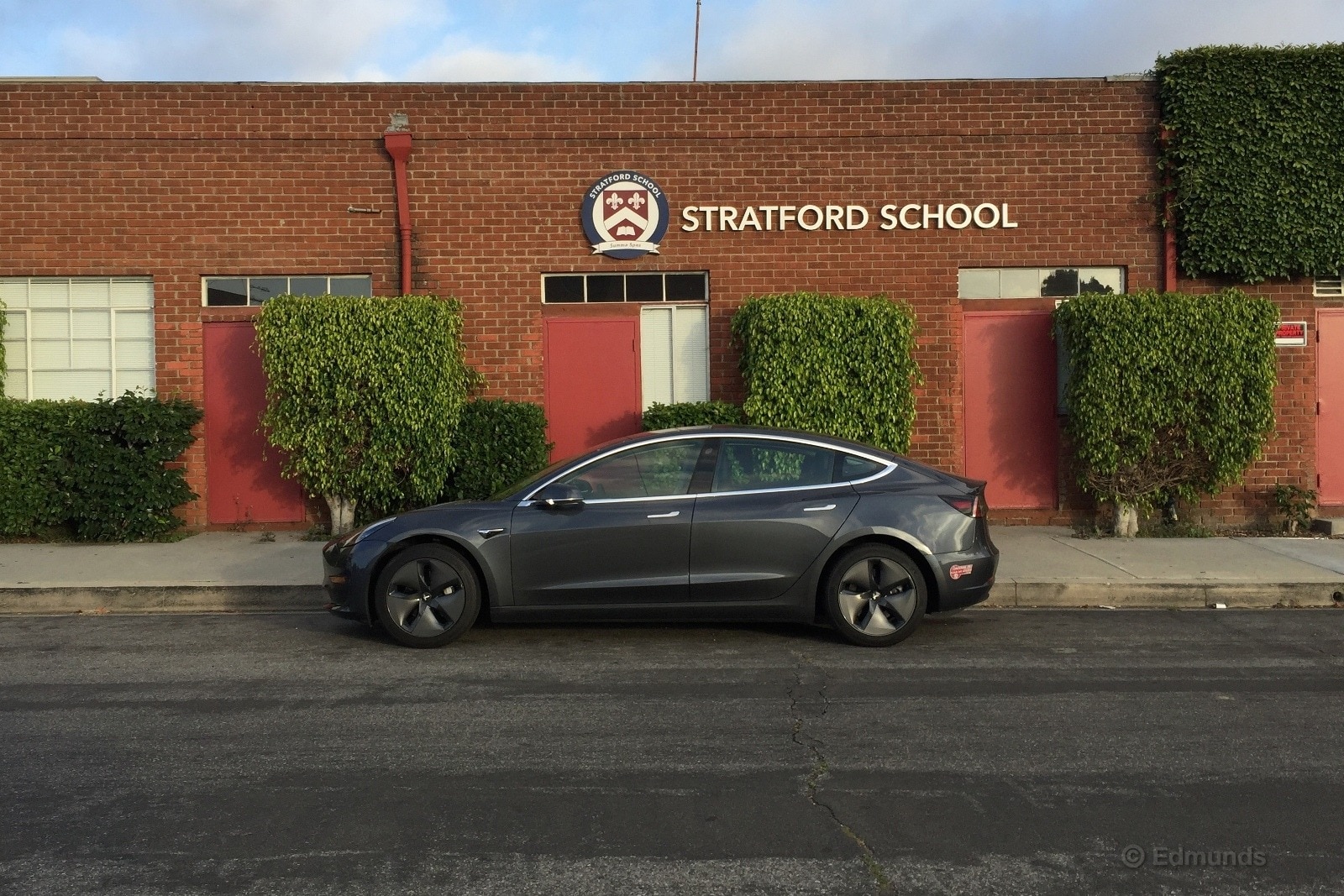
Monthly Update for July 2019
Where Did We Drive It?
July was a quiet month for our long-term 2017 Tesla Model 3. There were no major updates, breakdowns or Twitter tirades. Instead, our staff largely commented on ride quality and continued the debate on whether the conversation surrounding a product can be separated from its most prominent spokesperson.
As mentioned last month, we're continuing to monitor an apparent decrease in total range following a performance and range improvement delivered in an over-the-air update. Nothing conclusive yet.
What Kind of "Fuel" Economy Did It Get?
It may have taken a year and a half, but we crossed the 20,000-mile mark on the odometer in July. While this feels like an accomplishment, there were no changes to consumption figures, nor were any single-charge records set for efficiency or "leadfoot-ing," let's say.
We charged our Model 3 six times in July. As previously mentioned, we're still monitoring changes in distance-to-empty after a full charge.
Average lifetime consumption: 30.7 kWh/100 miles (109.8 mpge)
EPA consumption rating: 27 kWh/100 combined miles (126 mpge)
Best fill consumption: 21.7 kWh/100 miles (131.5 mpge)
Best range: 217.2 miles
Current odometer: 20,104 miles
Other fun facts:
Best onboard consumption meter reading (aka "The Featherfoot Award"): 177 Wh/mi
Worst reading (aka "The Leadfoot Award"): 570 Wh/mi
Average meter reading: 241.6 Wh/mi
Maintenance and Upkeep
None.
Logbook Highlights
Miscellaneous
"I need to rebut the esteemed Josh Sadlier's comment from last month. For starters, Henry Ford's personal conduct was inextricable from the Model T. Ford actually required his dealers to sign Model T buyers up for a subscription of his deeply anti-Semitic 'Ford International Weekly.' His views on World War I were widely discussed. His quotes about the Model T were famous in their own time (like the 'black paint' remark), and he ruled with the same sort of total power as Musk, cutting products such as the R and S by edict. Ford even insisted that the Model T never change, which is part of why it lost market share as soon as competitors were able to ramp up their own production and offer better products for a similar price.
"Musk has likewise made himself inextricable from the brand he heads. Whether it's the whole truth, it seems that he rules the brand entirely, determining every product decision. His claims and his enthusiasm are part and parcel of the media coverage of Tesla, regardless of their truth or how they prove out, and his every tweet affects the company's value in the eyes of shareholders. When you buy a Tesla, you are buying Musk, because that's how Musk has built the brand. To some that's an incentive — they want to be a part of Musk's future. And to that end, they are willing to be guinea pigs.
"Tesla buyers accept constant software updates for systems they are told outright are still in development, and they trust their lives to those systems. They do this over any evidence because Elon Musk has told them they can. Tesla buyers accept having features locked and unlocked remotely. And they accept upgrades and downgrades they may not have advance notice of, all of which originate, so we believe, from Elon's edicts.
"It is not hyperbole to say, that with the structure of Tesla and the way the cars are subject to its whims, your Tesla never stops being Elon's car. You are inviting him into your life when you buy a Tesla. So I would argue that as long as Elon Musk runs Tesla as he does now, there is no fallacy in addressing Musk when addressing the product. I'd also say that, as with the Model T, once competitors can meaningfully provide an alternative, Musk's presence may be part of what drags the brand's market share down." — Will Kaufman, content strategist and news editor
Performance
"Man, the ride is bouncy. It's better than in our old Model X, but it still might be enough to be a deal-breaker for me. Especially since I just got out of a Jetta, which in this generation has an amazing ride." — Will Kaufman
"It had been a while since I spent any time in our Model 3 outside of our testing facility and I had completely forgotten just how firm, no ... stiff the ride is on anything other than a perfect road. I think it's a bit too much for the non-performance version, and I'm surprised Tesla doesn't offer something more compliant. OTA updates are no good for fundamentals like ride." — Kurt Niebuhr, vehicle test editor
Monthly Update for August 2019
Where Did We Drive It?
While Tesla was off testing a future high-performance variant of the Model S on the Nürburgring, our long-term 2017 Tesla Model 3 spent the month like any other car in Los Angeles: commuting slowly around the city.
The tenor in our logbooks and the data we record haven't changed much, but anticipation for the future is higher than normal. One, consider the aforementioned Nürburgring attempt and what it may mean for future Tesla products. Two, software update V10 should be ready any minute. The headlines of this update don't appear to change drivability but add a host of features that could improve the in-car experience. For example, "Caraoke" adds an in-car karaoke mode that displays song lyrics when parked, while Tesla Theater adds support for YouTube and Netflix (insert joke about "chill" mode here). Tesla's even included a version of the game "Cuphead," which should be interesting to play considering that game's high level of difficulty.
What Kind of "Fuel" Economy Did It Get?
Our Model 3 traveled just 337 miles last month as it was under the care of an Edmunds employee who lives very close to the office. During its heavy city-commuting duty, it was charged three times. Average lifetime consumption improved slightly (0.1 kWh/100 miles), and we're continuing to watch the projected range after a fill, which is now hovering around the mid-280-mile mark.
Average lifetime consumption: 30.6 kWh/100 miles (110.1 mpge)
EPA consumption rating: 27 kWh/100 combined miles (126 mpge)
Best fill consumption: 21.7 kWh/100 miles (131.5 mpge)
Best range: 217.2 miles
Current odometer: 20,441 miles
Other fun facts:
Best onboard consumption meter reading (aka "The Featherfoot Award"): 177 Wh/mi
Worst reading (aka "The Leadfoot Award"): 570 Wh/mi
Average meter reading: 241.9 Wh/mi
Maintenance and Upkeep
None.
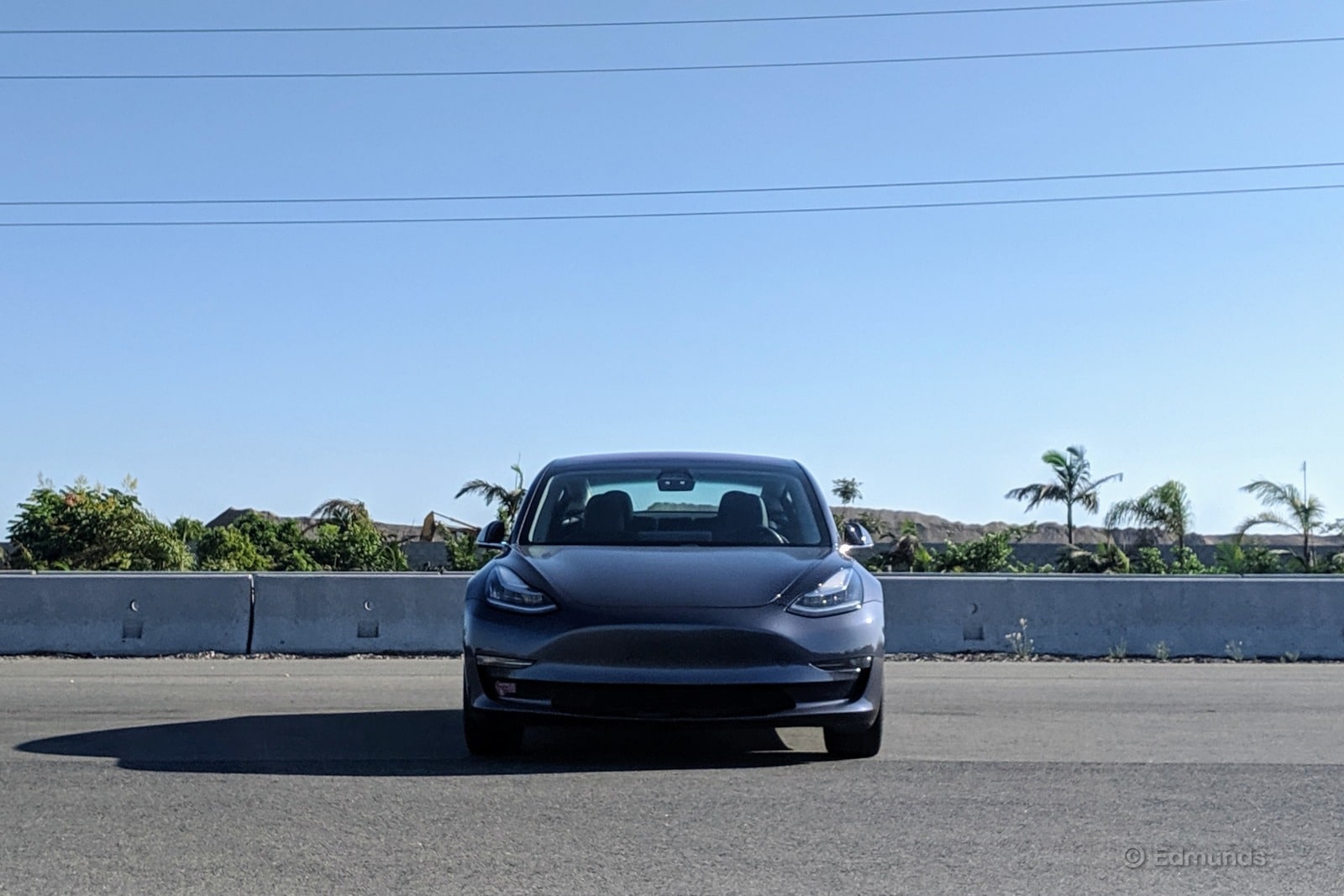
Logbook Highlights
Performance
"We've said it plenty, but it bears repeating: The Model 3 is a blast to drive. The always-available immediate acceleration matches the sense of power you get after an aggressive downshift in a traditional car, but you don't have to wait for the shift in the Tesla. You just go. It's that immediacy paired with smoothness and silence that gives the Model 3 stealth speed. And, let's admit it: That sensation can make you drive like a bit of a jerk. Why wait to merge or be patient with traffic when you can just zip around everyone?" — Carlos Lago, manager, feature content
"I love that you can go full yeehaw on the right pedal without making a sound. I live above a busy residential street and curse every modified car that drives by at speed. I want to tell each of them, 'Look, bro, I like acceleration, too. But we don't need to hear the exhaust backfire, especially when it's midnight and the speed limit is 35 mph.' I tell myself the same thing when I want to go fast in every car I drive in an attempt to be considerate of people nearby. And in the Tesla — provided I'm following all laws — I don't have to worry as much." — Carlos Lago
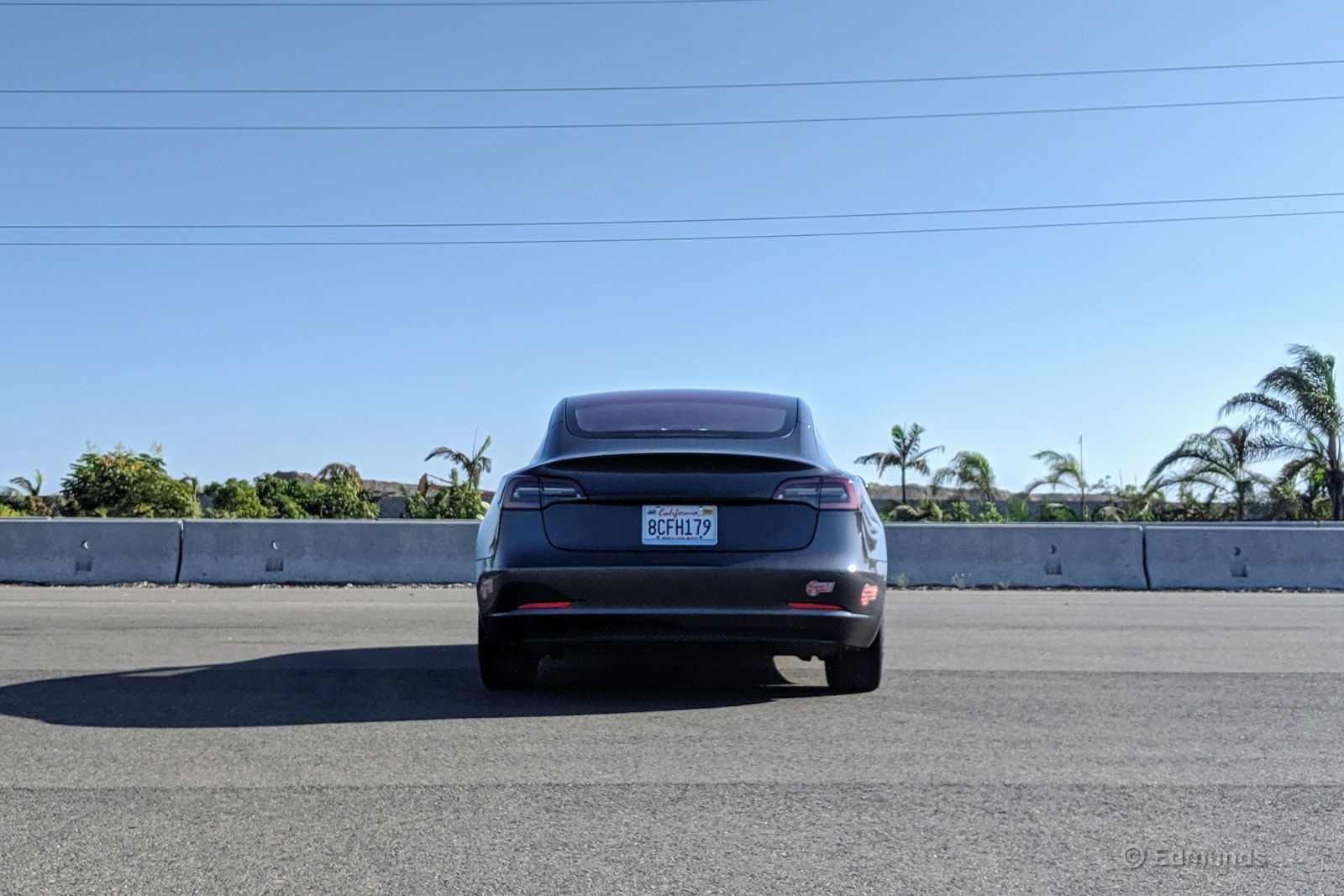
Technology
"I have yet to develop any trust with Autopilot beyond low-speed cruise control. Every time I try the beta navigate on the Autopilot feature and let the car manage lane changes and turns by itself, its movements always fall out of sync with my instincts. The system can wait too long to speed up after a turn, and it can pogo back and forth between lane markers. It seems hesitant in places it shouldn't, which is frustrating to both me and surrounding traffic. I bet it's much nicer on smoother and straighter freeways than I've been on lately, but until I drive those kinds of roads more regularly, I'll keep control of the wheel and only use the system in stop-and-go." — Carlos Lago
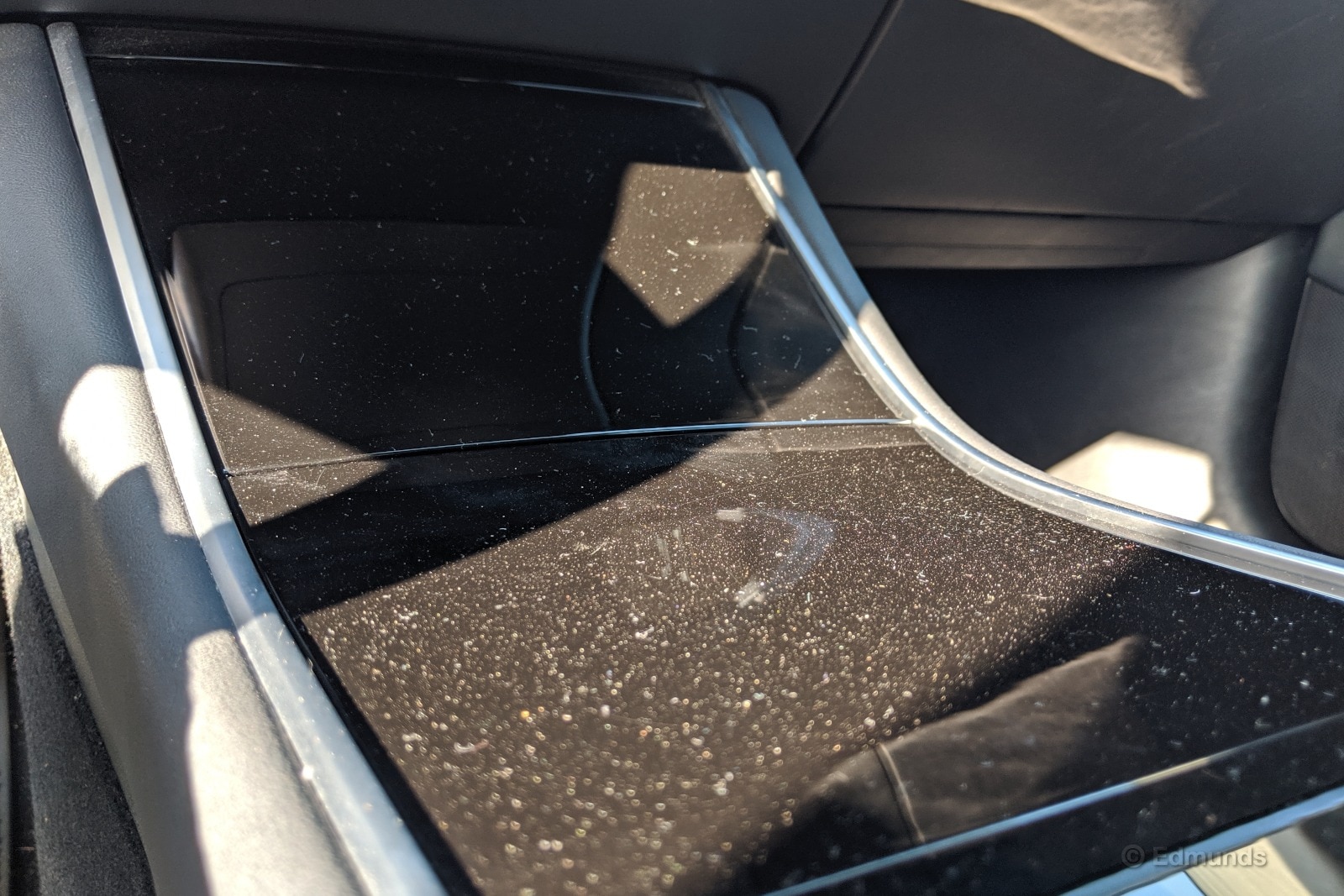
Interior
"There are two things I wish I could change immediately about the Model 3's interior: piano black plastic and the glass roof. Piano black looks amazing when clean, but that only lasts for about five minutes. It becomes a magnet for hair, dust, dead skin, and smudges. Yes, you can quickly clean it with a rag, but a textured or patterned material would do a much better job hiding the mess. And the glass roof? It's just hot. Sure, it's been treated in a way to lessen glare and heat, but you know what doesn't let glare and heat into the interior? A roof. We should start looking into getting shades or a tint." — Carlos Lago
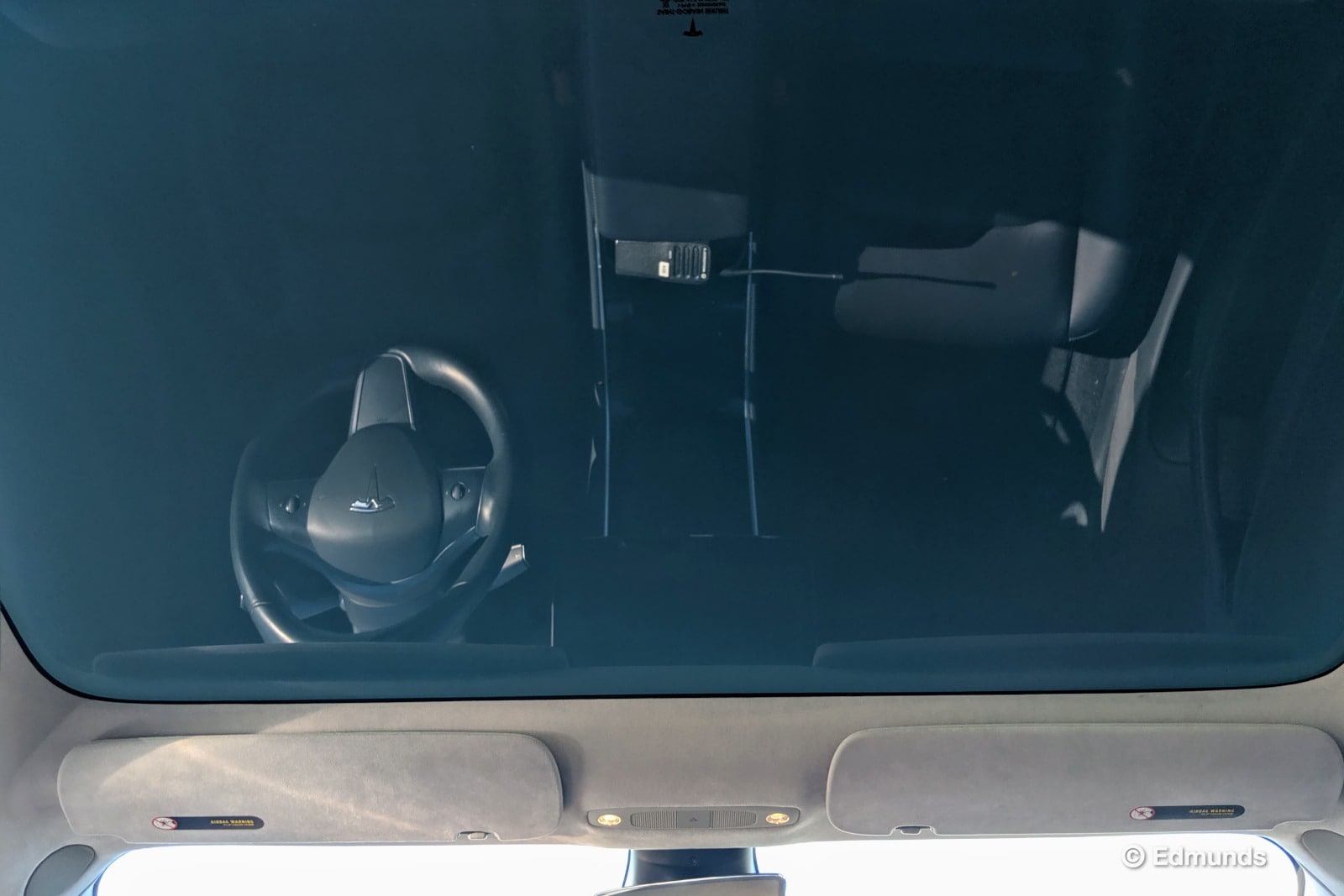
Monthly Update for September 2019
Where Did We Drive It?
Software update V10 has landed. It downloaded rather quickly once our Model 3 was parked and connected to Wi-Fi, and the installation process took around a half-hour. Here's a recap of what the updates include and our brief experience using each feature.
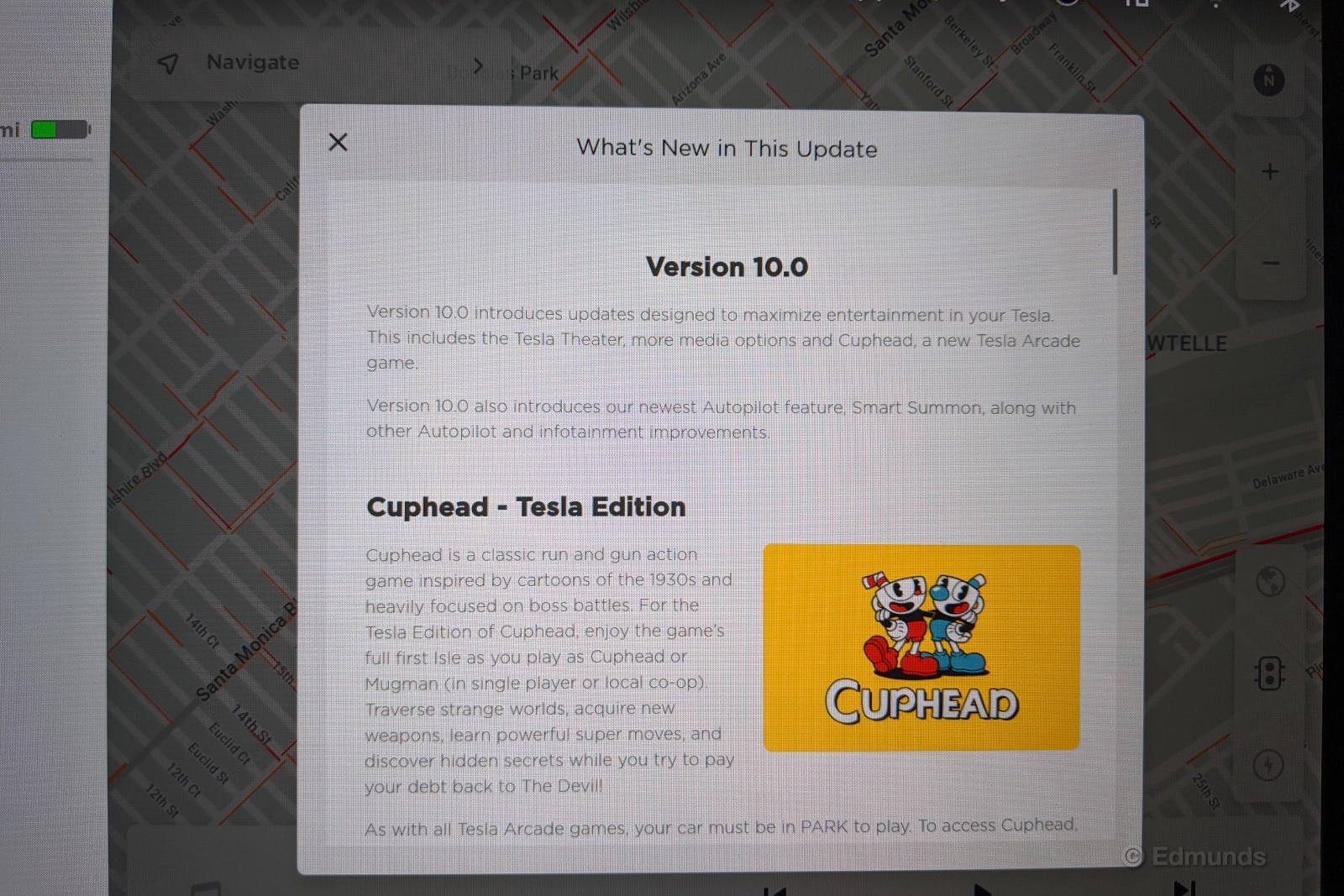
Cuphead
The video game Cuphead is now available. We were curious how this extraordinarily difficult (and beautifully animated) action platformer would work with the Tesla touchscreen interface. As it turns out, it doesn't. The only way you can play the game is with a controller plugged into a USB port — a good thing, considering the precision that the game demands. Check back later for thoughts on how it works.
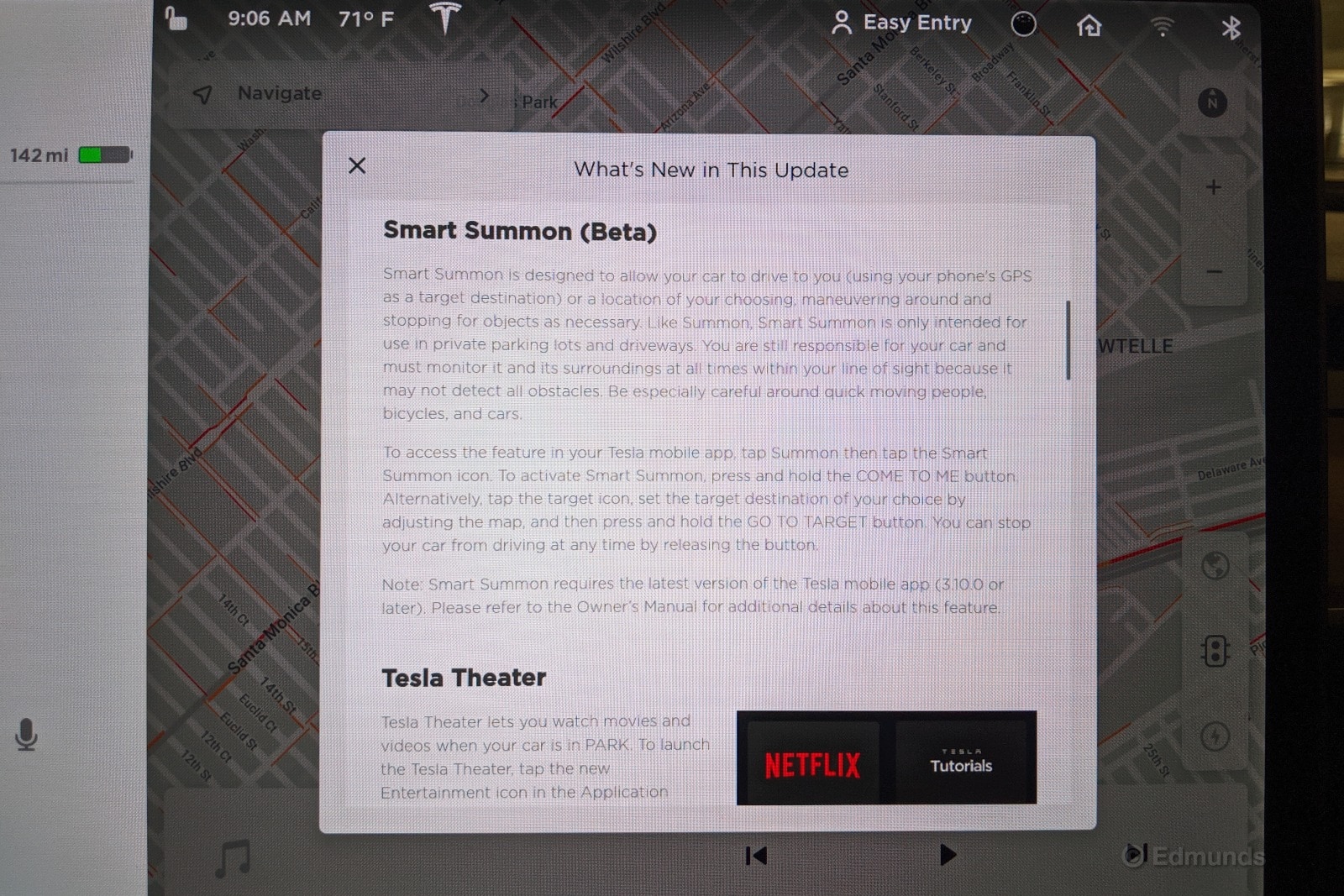
Smart Summon
Smart Summon is a, um, "braver" and beta version of the existing Summon feature where, using the Tesla phone app, you can have your car drive to you, or more specifically to your phone's location via GPS. It attempts to navigate tight surroundings, occasionally turning to avoid objects in its path. The changelog carries this disclaimer, "Smart Summon is only intended for use in private parking lots and driveways." It also says that "it may not detect all obstacles."
Our experience has been hit-and-miss, and we've watched the system's successes and failures on a bunch of videos online already. Ultimately, it's a neat gimmick when it works, but we have yet to find a practical use for it outside of showing off to friends, family and Instagram.
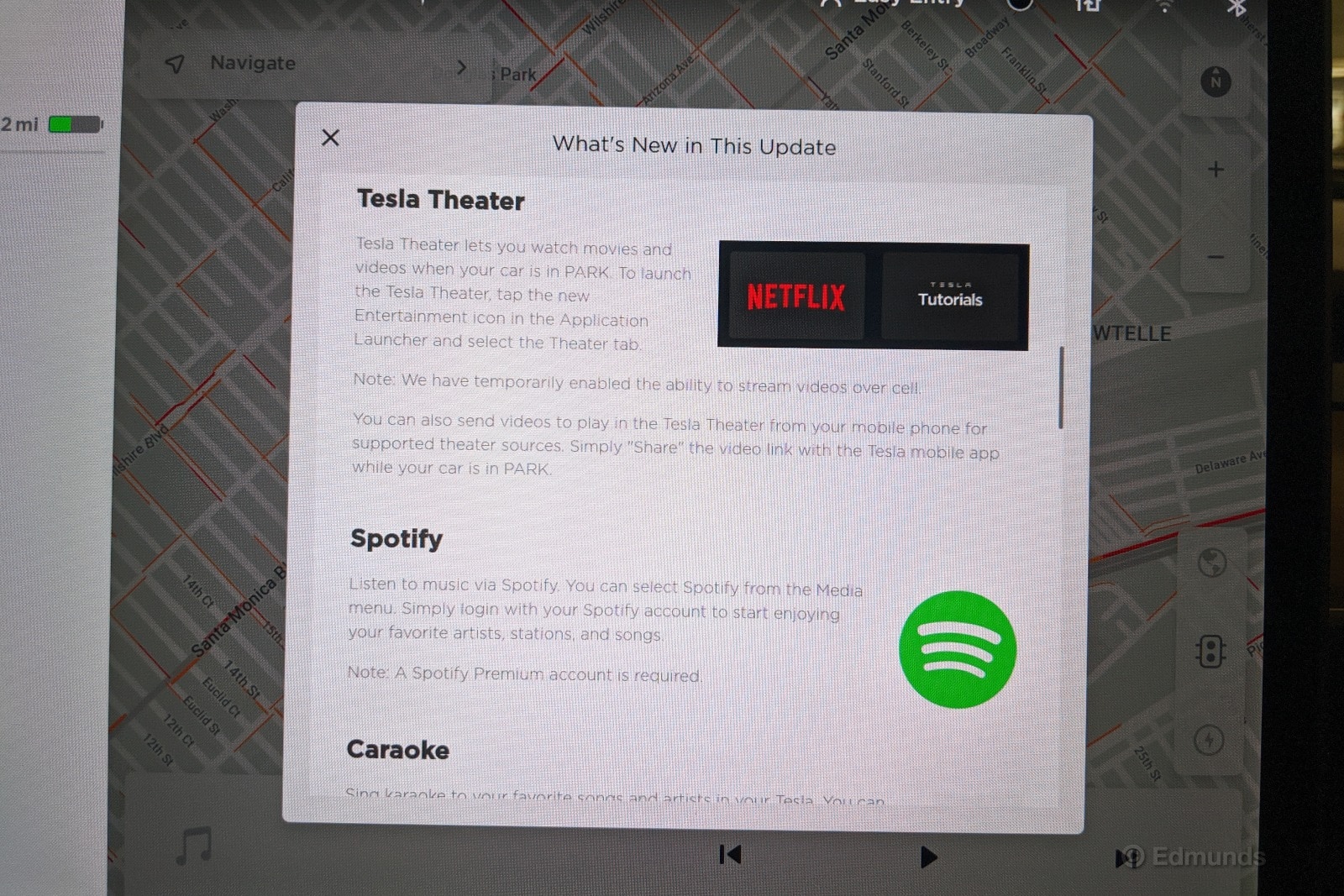
Tesla Theater
Ever wanted to watch YouTube, Netflix or Hulu on something bigger than your phone when parked? Now you can in the Model 3 — just enter your user credentials and binge. We suspect more platforms will follow in future updates, but we're impressed by what's available. From video games to TV shows and movies, the Model 3 has many answers for the question, "What do you do while it's charging during your road trip?"
Spotify
Finally, something better than internet radio! Well, kind of. Spotify is now available on the Model 3 but only for paying subscribers. There are no free rides here. While Spotify Premium members are surely celebrating, I'm not a subscriber, so it's Bluetooth until future notice.
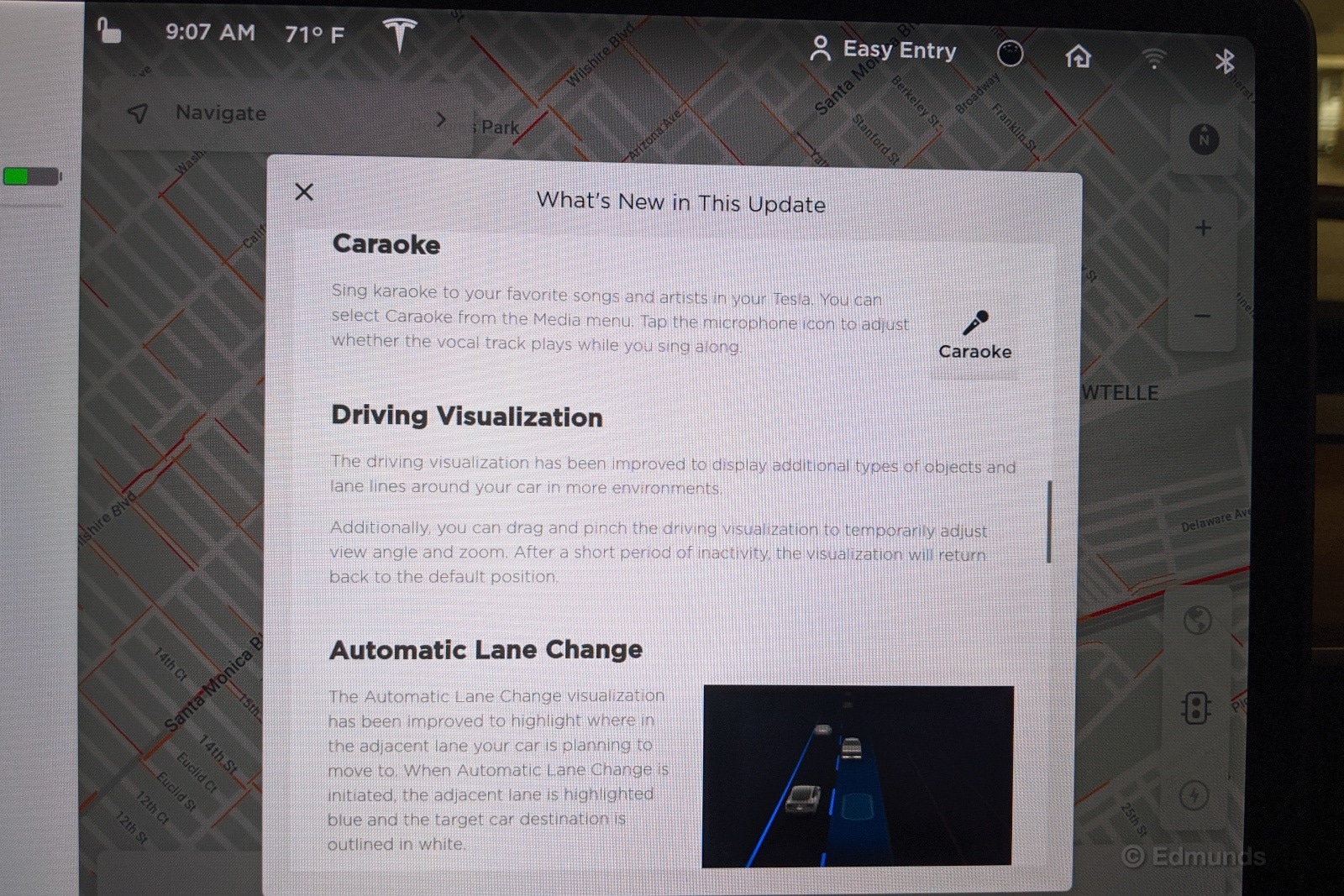
Miscellaneous
The dashcam can now use the rear-facing camera (why did this take so long?). In-car karaoke (called Caraoke) gives access to preset karaoke songs with lyrics that appear on the screen. Two new navigation prompts ("Lucky" and "Hungry") route you to nearby attractions or local restaurants. Also, the display of your car's surroundings moves a bit more smoothly now. Neat-o.
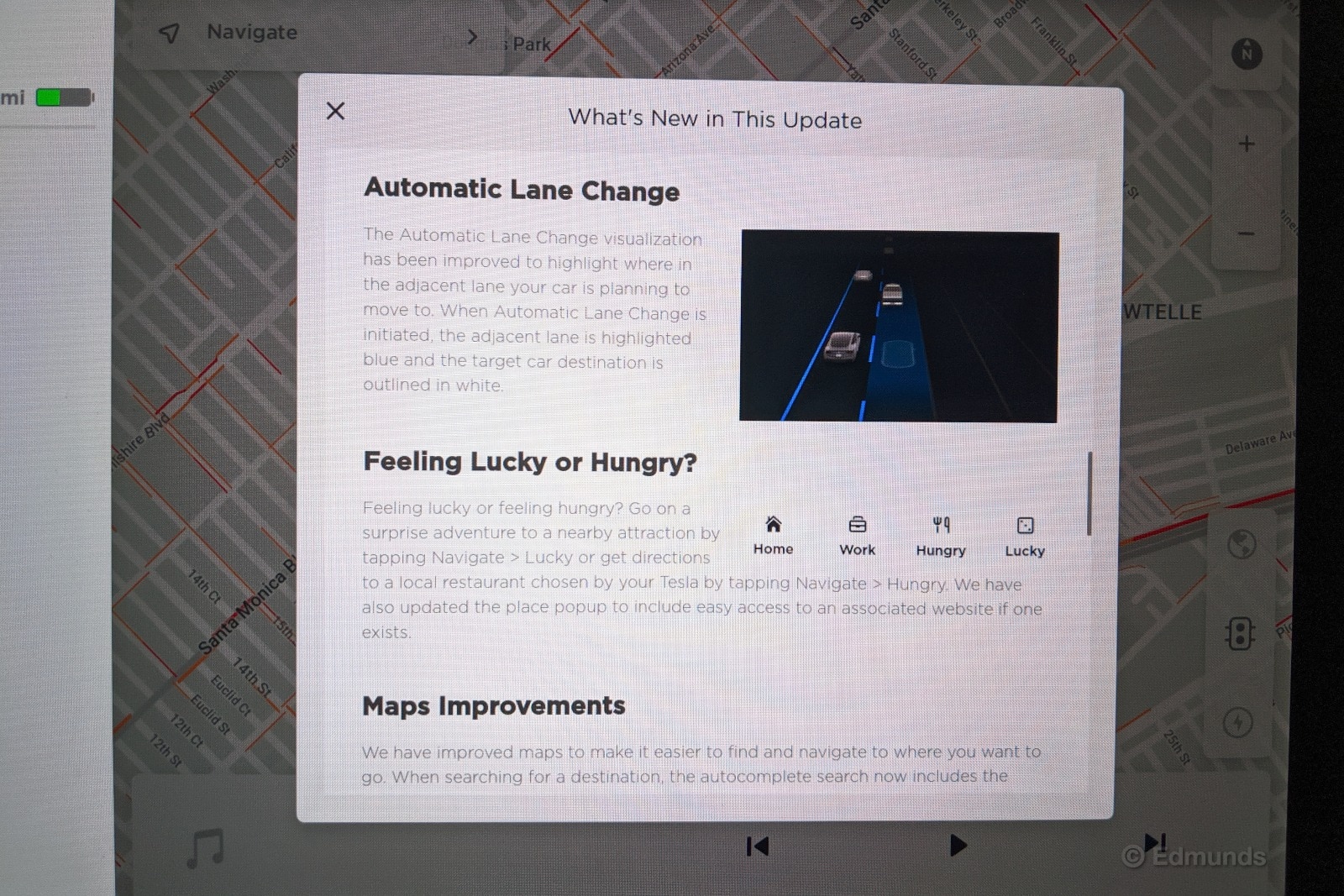
How Much Electricity Did It Use?
We drove the Tesla 561 miles and charged it six times in September. The indicated range after a charge continued to climb. We saw it register as high as 291 miles after one charge, though most hovered at 287 miles. Never mind that we don't actually go that far between charges; we average about 100 miles between plug-ins.
Remember how our average lifetime energy improved by 0.1 kWh/100 miles in August? In September, it returned to the 30.7 kWh/100 miles average we've reported for a few months now, indicating the difference is mainly due to rounding.
Average lifetime consumption: 30.7 kWh/100 miles (109.7 mpge)
EPA consumption rating: 27 kWh/100 combined miles (126 mpge)
Best fill consumption: 21.7 kWh/100 miles (131.5 mpge)
Best range: 217.2 miles
Current odometer: 21,002 miles
Other fun facts:
Best onboard consumption meter reading (aka "The Featherfoot Award"): 177 Wh/mi
Worst reading (aka "The Leadfoot Award"): 570 Wh/mi
Average meter reading: 242.5 Wh/mi
Maintenance and Upkeep
None.
Logbook Highlights
Technology
"A strange thing happened when the notification for software update V10 appeared on the Tesla's display: I drove to work faster to get the process started.
"More interesting than the specific features is the sense of interest that an update like this brings to vehicle ownership. It's like when your phone or your favorite video game receives a major update. It brings anticipation and renewed interest to the experience. I've never thought a car could do the same thing, but the Model 3 does.
"After an update, you look forward to playing with the new doodads and goodies it brings, as simple as they may be. For example, I swear that the electronic whoopee cushion built into the entertainment screen has made more passengers laugh over and over again than the acceleration. These are gimmicks, surely, but they're damn good ones." — Carlos Lago, manager, feature content
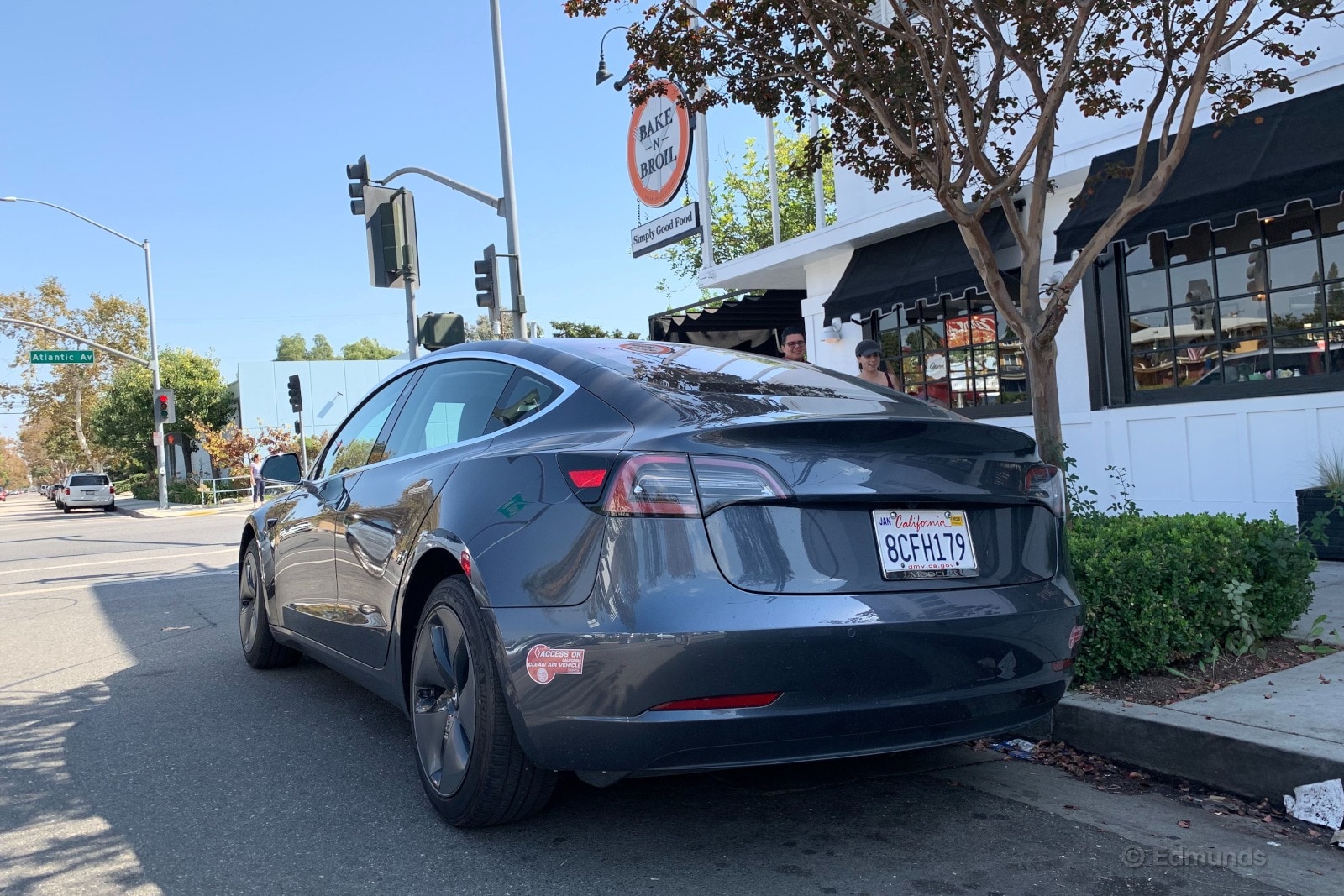
Wrap-Up
What We Got
We were among the first to take ownership of a Tesla Model 3. Doing so required a few mandatory options and a configuration that is no longer available. Outfitted with the (at the time) 310-mile battery and Premium Upgraded interior, our Model 3 long-range rear-wheel drive totaled $50,000 with destination. To that we added a color that wasn't black ($1,000) and Enhanced Autopilot ($5,000) for a total of $56,000.
You expect a few glitches when you buy a car in its first generation. But when it's an entirely new car from an entirely new car company that has entirely different ideas on how cars should work, those glitches get magnified.
Indeed, our 2017 Tesla Model 3 had a very rocky start to ownership, with frequent visits to repair centers for a variety of issues. But once those issues were addressed, our Model 3 quickly became one of our favorite sedans. We even named the current model a winner of Edmunds Top Rated 2020.
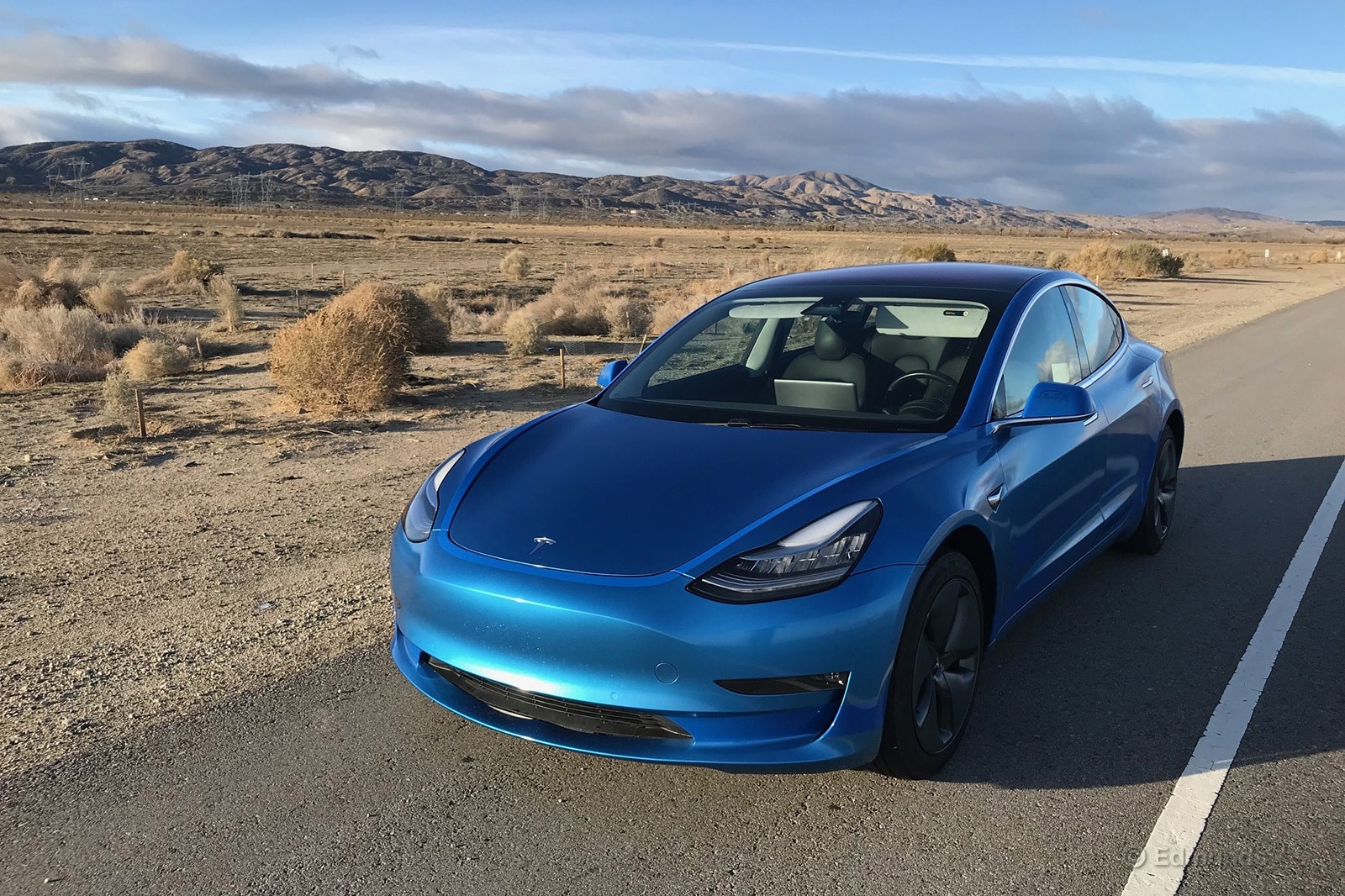
The Model 3 is a collection of radical new ideas, not just for electric vehicles but also for the automotive industry. When executed well, these ideas don't make the Model 3 feel futuristic. Instead, they make similar vehicles seem old.
It's small things like the absence of a power button (why do you need one?) and harmless fun baked into the entertainment system, like karaoke and a whoopie cushion. But it's also things like how you can control your ownership experience through your phone, from locking the car to scheduling service to ordering upgrades.
It's more like owning a modern cellphone or video game than a car. Tesla's over-the-air software updates promise new features and polish to existing ones. We caught ourselves checking online Tesla communities when an update was imminent simply because we were eager to play with the new toys.
Performance
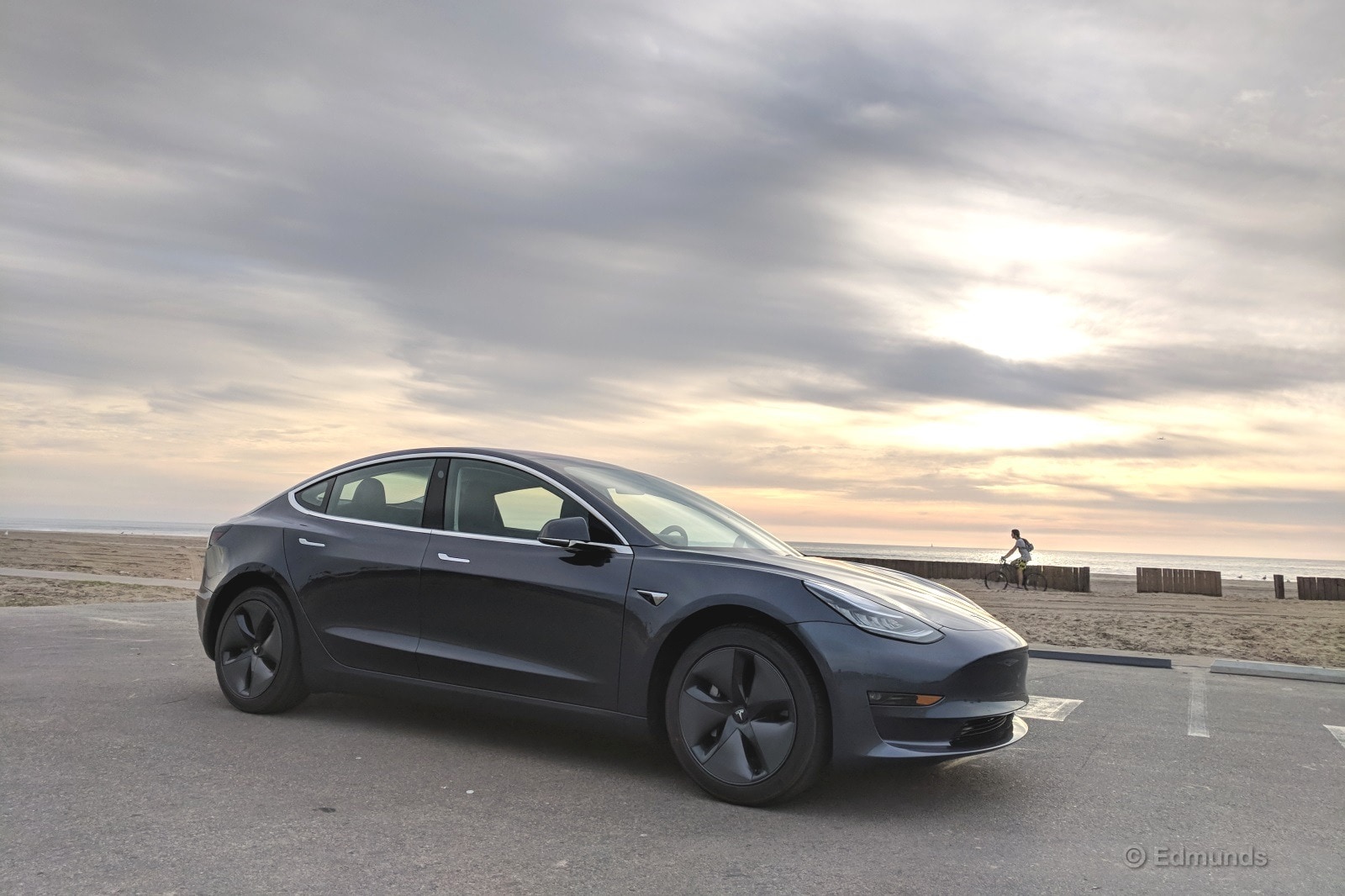
"Highway 39 is tight and sinuous, and there's a fair bit of climbing through several switchbacks. Up here this chassis feels really sorted and well-balanced, and I really like the way the steering reacts, as well as the feel of the wheel in my hands. The electric motor delivers plenty of thrust, too. I actually caught up to a pair of sport bikes on the way up and walked away from an Alfa Romeo Giulia." — Dan Edmunds, director of vehicle testing
"The brakes felt smooth and easy to regulate on the way down the mountain from Crystal Lake. But even though I had the regenerative braking set to high, I did find myself using the brake pedal more often than I had when driving the Bolt EV down the same mountain at a similar clip. I suppose it's because the Model 3 is a rear-wheel-drive machine and the Bolt is a front-driver. Stability demands that the bulk of your braking be done on the front end, and that means Tesla can't set the Model 3's regen level quite as high. You'll find yourself using the brake pedal instead of lift-throttle braking more often in situations like this. The end result is an overall loss of harvesting efficiency because some energy that might otherwise be recoverable in a front-wheel-drive EV will be lost as heat in the Model 3's front brake pads and rotors." — Dan Edmunds
"The Model 3 definitely steers and handles better than, well, any other EV, frankly. Feels more satisfying to drive than a Bolt, Leaf, etc. The ride's a bit too busy, however, in a way that makes me think they need to make another pass at the damping. It's not harsh, but it's not spot-on, either. Still, thumbs-up for making an EV that doesn't mind a fun road." — Jason Kavanagh, senior road test engineer
MPGe
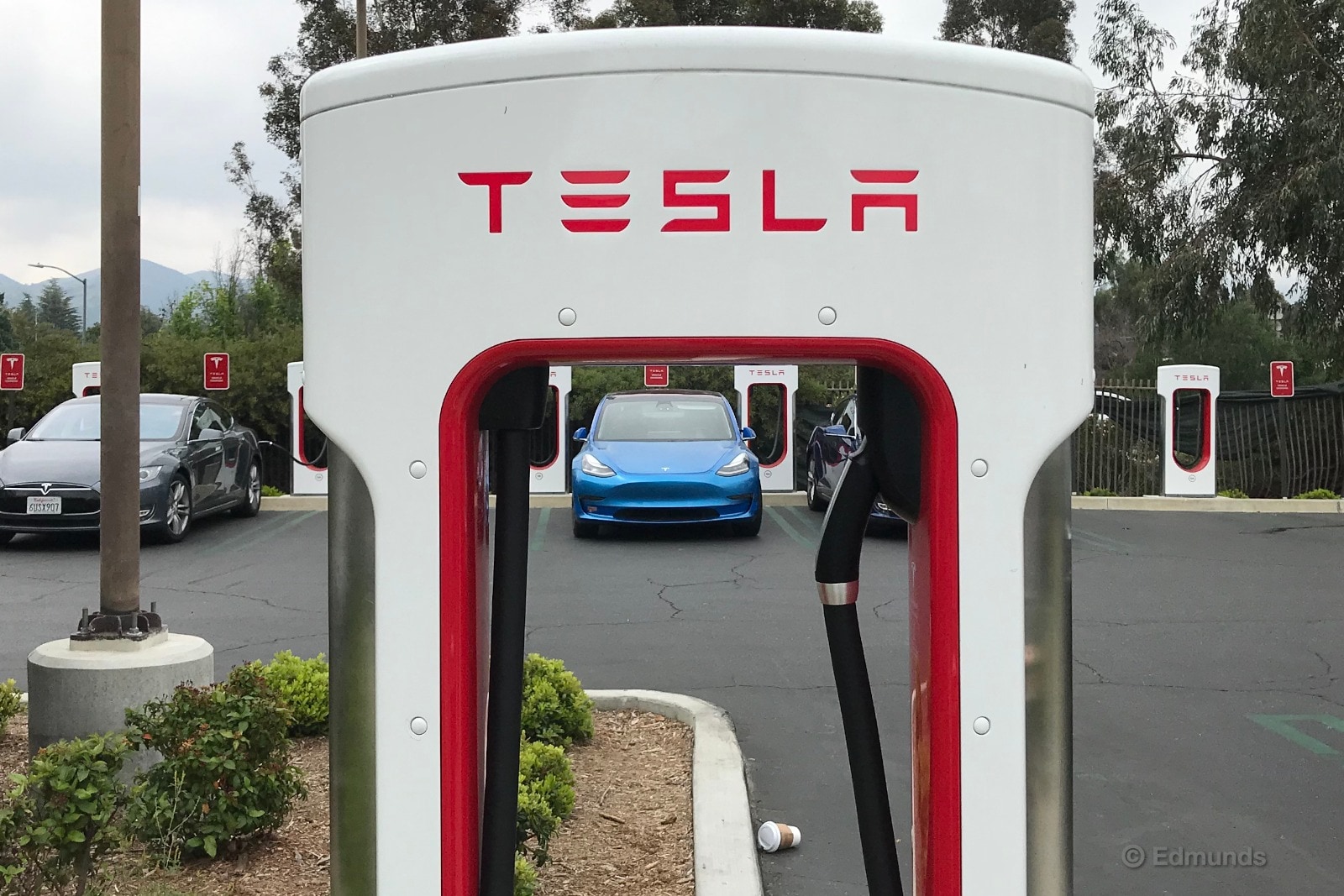
"I'm tired of this. I am not able to match, let alone exceed, the Tesla's rated range. This flies in the face of every other EV. I've driven 334 miles in a Bolt, which is only rated at 238 miles. I've had similar (and frequent) range-busting results in the Leaf, the Volt, the Kona EV and many others. But never in a Tesla, be it an S, X or 3. And I’m driving the same commute.
"I'm thinking their ratings are overstated. Of course they are. Who else recommends that you set the battery to 90% full on a regular basis to save the battery? No one, that's who. It allows them to claim a certain range but recommend against operating the car that way. Meanwhile, our Bolt is proving such tactics aren't necessary. It just achieved its best-ever result after 2.5 years and nearly 30,000 miles." — Dan Edmunds
Comfort
"This car rides too rough for my tastes. You feel every crack and imperfection in the road. I drove this back to back with our Chevy Bolt, and the Bolt was far more comfortable for me for daily driving. I get that this car has sporty intentions, but most people are driving these cars in cities full of potholes rather than winding mountain roads." —Ron Montoya, senior consumer advice editor
"The Model 3's back seat is an obvious weak spot, as my parents' recent visit underscored. They were generally gee-whiz amazed by the Model 3, but they were disappointed by the low-mounted rear bottom cushion and the lack of comfortable contours back there. Not much legroom, either. As comfortable as the front seats are — I find them delightful — I'm surprised Tesla couldn't do a halfway decent job with the rear compartment. The Model 3 is at a distinct disadvantage versus well-rounded rivals like the 3 Series in this regard." — Josh Sadlier, director, content strategy
Cargo Space

"I was recently transporting a large record collection, along with a few boxes of CDs, and the Model 3 was the car I had for the job. I was impressed by the Model 3's storage ability relative to its size, with the space to fit four massive storage containers and several cases of CDs with space to spare. The weight on top of the rear seats, however, set off the seat sensor, telling me there was something in the back seat. It did this, on a constantly displaying basis, for over 100 miles. Seems to me like there should be some sort of secondary sensor that knows the seat is folded down before it warns me that the plastic totes aren't wearing their seat belts." — Travis Langness, reviews editor
"Still in all, it was pretty simple if I slid the bike in tail first and chain up. I didn't have to drop my seat post to slip it through the opening either. There was more than enough longitudinal space to slide it in far enough to lay the bars flat at 90 degrees, and in this position the back tire was nowhere near the front seat, even when racked to my long-legged driving position. There's tons of room for gear bags all over the place, too." — Dan Edmunds
Interior
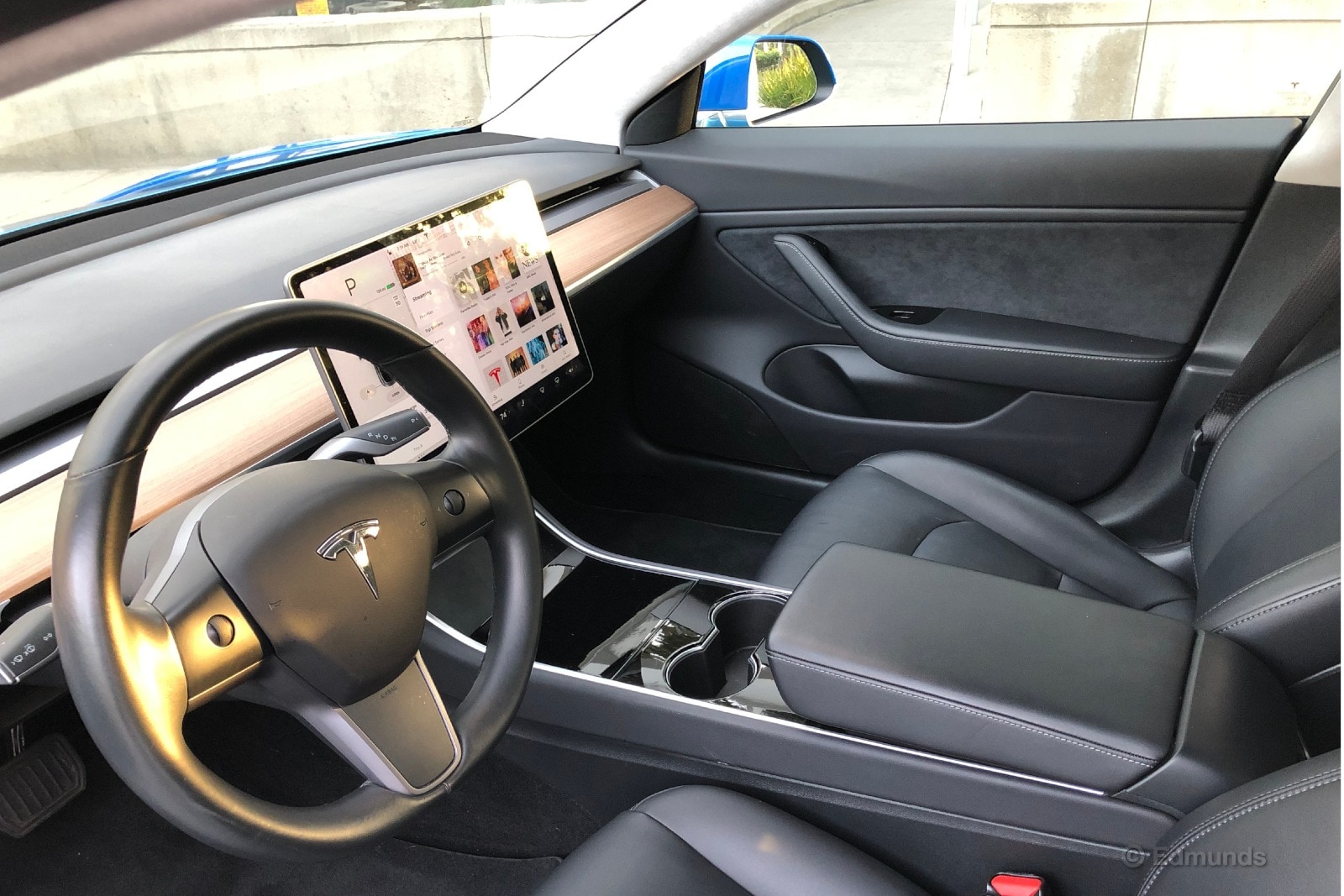
"I really don't like how there are no hard buttons in the Model 3 to adjust the side mirrors. It's a tedious process that you can't do on the fly. I often need to be parked to navigate the various button presses on the screen and on the steering wheel. Even if you're not like us, who switch drivers on a regular basis, mirrors are something that often need to be adjusted from the car wash or the valet." — Ron Montoya
"I love the steering wheel in our Model 3. It might be my favorite steering wheel in any car today. It's engagingly small in diameter, while the 9-and-3 grips are super thick and sized just right for my palms. Makes me think of an old arcade game like RoadBlasters, where the wheel's sportiness was exaggerated beyond anything you'd find in an actual car. Tesla puts such a wheel into a mass-market consumer vehicle as standard equipment — you don't even have to upgrade to a sport package or something. Perfect 10 in a category that doesn't get as much attention as it should." — Josh Sadlier
Audio and Technology
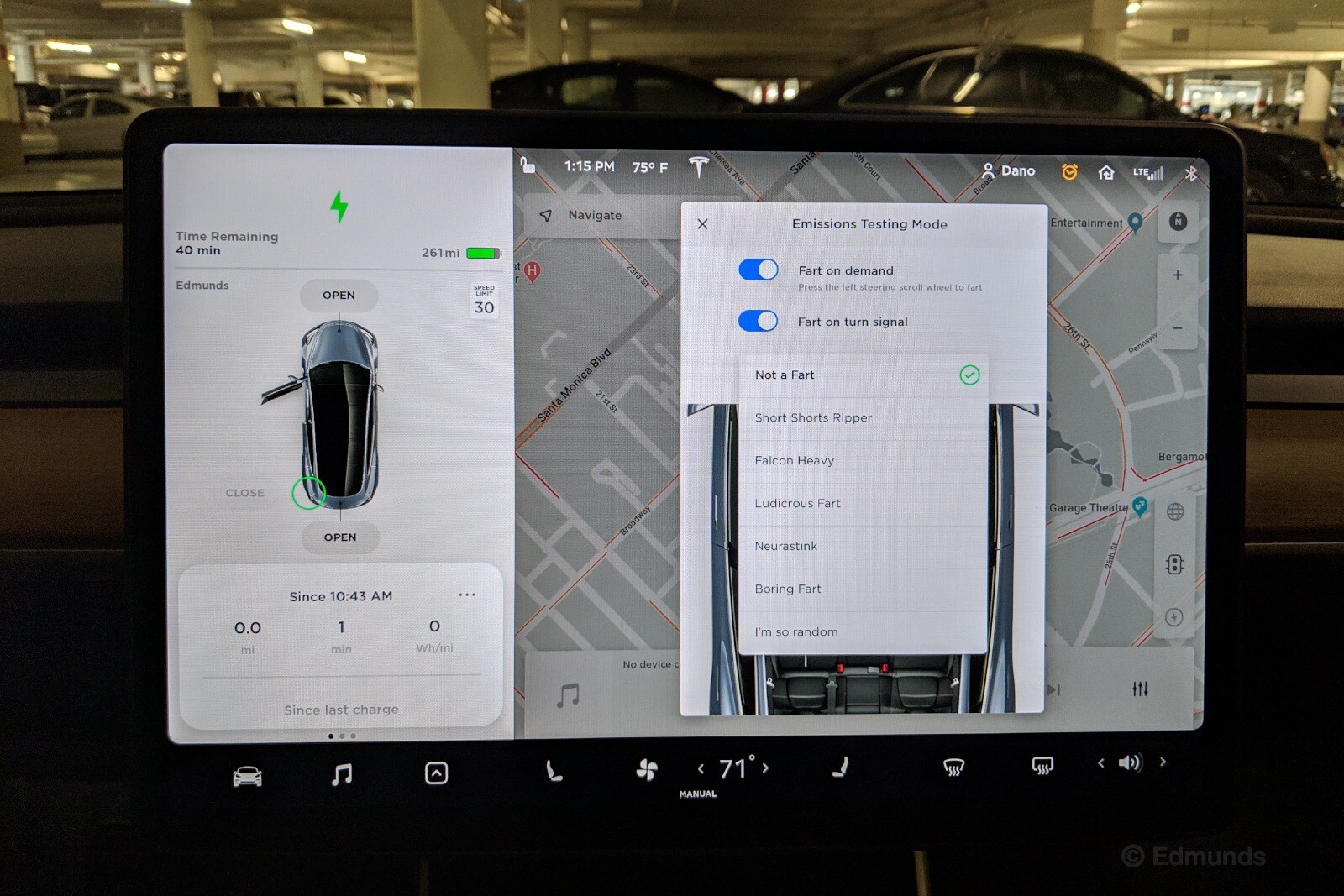
"I keep forgetting that the Model 3 doesn't have satellite radio. It's not much of an issue when I'm driving alone and listening to podcasts, but my friends and family don't enjoy listening to Adam Scott Aukerman talk about U2 as much as I do. In that case, satellite radio is the way to go, especially on long road trips where I can tune it to Alt Nation and not think about music for a few hours." — Cameron Rogers, reviews editor
"I've used several manufacturers' apps for loaned cars, but I don't find many of them useful. It's cool that you can precool or preheat the cabin and remotely unlock the doors, but most of the other functions aren't necessary. Even worse, manufacturers view these services as another source of revenue, and I'm not sold on paying hundreds of dollars per year for the privilege.
"That said, I love Tesla's app. It does the things I primarily use the other apps for — checking where I parked it, pre-conditioning the cabin and remotely heating the windshield to melt the ice off (yes, it has been cold enough in LA to do this early in the morning). Because I don't have a charging port at my house, I have to charge the Model 3 at a public charging station. The app also displays the current range and an estimated time of completion, which helps massively when I'm structuring my time around charging the car. Best of all, the Tesla app is free." — Cameron Rogers
Maintenance
"I don't want to jinx it, but it has been roughly 10 months since our Model 3 had to visit the dealership — perhaps the longest problem-free streak we've ever had in a Tesla. The reliability has improved with each Tesla model we've owned. Our Model 3 visited the dealer three times in just over a year of ownership, which is still well above average but roughly half the dealer visits of our previous Model X." — Ron Montoya
Miscellaneous

"I'm not sold on Tesla's Autopilot. It requires you to keep your hands on the wheel. But if you hold the wheel too hard, the system will deactivate. It sits a little too close to the left lane for my comfort but doesn't allow me to adjust it. If you activate the turn signals, it will change lanes automatically, which is impressive. But you still need to monitor it because it freaked out when it drove over some Botts' dots and then asked me to take over immediately. With all this monitoring, I preferred to man the wheel myself and use the old-fashioned cruise control." — Ron Montoya
"With the recent software update, the wipers in auto mode no longer act like they're drunk." — Rex Tokeshi-Torres
"A 19-inch upgraded performance wheel and tire combo only weighs 1 pound more than our stock 18-inch wheel and tire. That's cool." — Rex Tokeshi-Torres, vehicle testing technician
"Doing a vivid blue vinyl wrap was fun, and the process was informative, but it's nice having the subtle gray exterior color back on our Model 3." — Carlos Lago, manager, feature content
Maintenance & Repairs
Regular Maintenance:
The Model 3's owner's manual recommends a tire rotation every 10,000 to 12,000 miles, a clean and lubrication of the brake calipers every year or 12,500 miles, a brake fluid check and cabin air filter replacement every two years, and an air-conditioning desiccant bag replacement every six years. Otherwise, it says the Model 3 should "generally be serviced on an as-needed basis."
Service Campaigns:
Our Model 3 was subject to one technical bulletin that required replacing the front stabilizer bar links.
There were no recalls, but our car experienced a litany of problems in its first year of ownership. Here is a brief list of the problems we experienced:
- Delivered with a cracked vanity mirror, dislodged interior trim, and a misaligned frunk hood. After repair, the vanity mirror later simply fell off.
- The central entertainment display had multiple failures, including Bluetooth inconsistencies, total blackouts (we lost count after 15), repeated and uncontrollable increases in stereo volume, and an erratically behaving navigation display (zooming and panning without input).
- At one point, the stereo turned on and went to full volume when the car was off, locked and unoccupied.
- Backup camera display occasionally failed to appear during reversing.
- An alert that regenerative braking was unavailable even when the battery had room to spare.
- Keycard to unlock the vehicle was not recognized multiple times.
- Occasionally the vehicle wouldn't shift into drive or reverse after startup. "Vehicle Systems Are Powering Up. Shift Into D or R After Message Clears" appeared on screen.
While we never had to leave the Model 3 at a service center for longer than a matter of hours or pay for anything, we did often have to wait for parts. For example, it took a little over two months from when we scheduled our first service to the repairs actually happening.
The problems got to a point where we even started a special channel in Slack to document everything. But just when the issues seemed insurmountable, they stopped happening (R.I.P. #lt_tesla3_problems).
We chalked up these issues to owning an early production Model 3 because once the service network strengthened and after a few updates rolled out, the remainder of our ownership was flawless. Plus, our experience with current model year Model 3s has shown a dramatic increase in quality.
Fuel Economy and Resale Value
Observed Fuel Economy:
EPA estimates for electricity consumption for a 2017 Model 3 are 27 kWh/100 combined miles and a range of 310 miles. These figures represent a fully charged battery, but Tesla recommends against charging this way. We charged to 90% the majority of the time, netting an estimated range of around 280 miles. Unlike most EVs we've tested and owned, we were unable to match either figure. Lifetime consumption was higher than the EPA rating, at 31.2 kWh/100 miles and our longest driven range was 261 miles.
Resale and Depreciation:
We purchased our Model 3 for $56,000. After three years and 24,290 miles, we decided to trade it in toward a new "off-the-menu" Model 3. Tesla appraised our vehicle at $35,500, essentially matching Edmunds' TMV Calculator for trade-in and reflecting a 37% depreciation.
Summing Up
Pros: Addicting passing power and delightful steering and handling. An ownership experience that makes similarly priced vehicles seem antiquated. No maintenance costs.
Cons: Poor initial quality meant plenty of trips to the service center. Rough ride quality. Rampant popularity can expose the limitations of the charging network during the holidays.
Bottom Line: The Model 3 pairs brilliant real-world driving dynamics with gee-whiz interior features, making it an excellent sedan for city commuting.
Total body repair costs: |
None |
Total routine maintenance costs: |
None (over 36 months) |
Additional maintenance costs: |
None |
Warranty repairs: |
Replaced driver-side sunvisor, replaced driver's seat trim, replaced front passenger seat adjustment switch, replaced touchscreen, replaced trim on driver and front passenger doors |
Non-warranty repairs: |
None |
|
|
Best observed range |
261 miles |
Best projected range |
322 miles |
Lifetime average consumption |
31.2 kWh/100 miles (108 mpg equivalent) |
EPA rating |
27 kWh/100 miles (126 mpg equivalent) |
|
|
True Market Value at service end: |
$38,751 |
What it sold for: |
$35,500 |
Depreciation: |
$20,500 (37% of paid price) |
Final odometer reading: |
24,290 miles |
Disclaimer: Edmunds purchased this vehicle for the purposes of evaluation.